谨以此书献给所有为这一片土地奋斗、奉献的华商们︕
This book is dedicated to all the Chinese entrepreneurs who contributed earnestly to Singapore.
THE UNWAVERING FORCE OF CHINESE ENTREPRENEURIAL SPIRIT A
Centennial History of the Singapore Chinese Chamber of Commerce & Industry
苍黎命脉 继往开来
百年华商 积厚流光
积厚流光
陈志锐 博士
捍卫小权益 取信大社稷
为民复请命 诚信可振邦
响应维新 改革教育
作育栋梁 造福南洋
Reservoir of Light
People inherit the light of before
Chinese businessmen accumulate a century of light for after
Safeguarding our smallest rights
Winning our greatest trust till us unite!
Plead for the population
With truth, revitalize our nation
Pillars that uphold Nanyang
Reform our education!
Open the port of my Sinchew
开埠我星洲 煦色韶光
实业吾民富 引资招商
家国有效忠 鸣凤朝阳
回馈吾乡 取诸更用诸社会
创新求变 还先得远瞩高瞻
立足当下才有未来展望
华商精神必将源远流长
May glory be our view
Import businesses and investments
And prosperity be with our inhabitants
The country sees in everyone a loyal son
Like the phoenix calls to the morning sun
Light up our hometown which we’ve used and taken abound
With great foresight, ascend to new heights
From innovation, to transformation
Secure the present, for the future’s present
The Chinese Entrepreneurial Spirit might always stay alight
Poem by Dr Tan Chee Lay
Translated by Tan Inn Shin

目录 CONTENTS i 会长献词 PRESIDENT S MESSAGE 1 导论 百年华章 为民立命 INTRODUCTION Centennial Chapters: Serving the People 17 第一章 商海领航 帷幄运筹 CHAPTER ONE The Leadership Stories of the SCCCI Presidents 89 第二章 峥嵘岁月 时代印记 CHAPTER TWO Glorious Years: Leaving a Mark in History 169 第三章 华商精神 薪火相传 CHAPTER THREE Passing on the Chinese Entrepreneurial Spirit Legacy 207 结语 CONCLUSION 211 第60届董事会 THE 60TH SCCCI COUNCIL 229 致谢 ACKNOWLEDGEMENTS
会长献词
PRESIDENT’S MESSAGE


新加坡中华总商会会长
Roland Ng San Tiong President Singapore Chinese Chamber of Commerce & Industry

The Singapore Chinese Chamber of Commerce & Industry has always been founded on the Chinese Entrepreneurial Spirit, namely Integrity, Loyalty, Giving back to society, and Innovation. Looking back at the past 116 years, the Chamber’s legacy has been built on the unwavering force of the Chinese Entrepreneurial Spirit. This will continue to be the foundation of our sustained development in the future.
Since its establishment in 1906, the Chamber has been the apex organisation of Singapore’s Chinese business community. Guided by the mission of safeguarding the interests of the Chinese business community and the general Chinese community, our forefathers have witnessed and participated in the historical events that have defined
黄山忠
新 加坡中华总商会向以 诚信、效忠、回馈和创
新为华商精神的支柱。回顾过 去116年的历史,总商会一直以
“华商精神
生生不息”为传承的
基础,未来亦会以此为永续发 展的基石。 总商会自1906年成立以来,
百年沧桑,不但见证了时代的
President’s Message
一直是新加坡华商最高领导 机构。我们的先贤,本着维护 华商与华社利益的使命,走过
变迁,同时也参与其中。过去
the past century. During this period, 60 Councils and 34 Presidents, all dedicated to leading the Chinese community, have played their roles in various political, economic, social and cultural spheres.
The publication of The Unwavering Force of Chinese Entrepreneurial Spirit—A Centennial History of the Singapore Chinese Chamber of Commerce & Industry encourages us to review Singapore’s history and its interplay with the Chamber’s roles and contributions throughout Singapore’s key historical eras—the British colonial rule, the Japanese Occupation, the fight for independence, the merger and separation with Malaysia, and the independence. Readers can then understand how the Chamber, in the post-independence era, worked with the government to
drive economic development, while undergoing a change in identity, transforming from sojourner to citizen.
Today, I am pleased to see the publication of The Unwavering Force of Chinese Entrepreneurial Spirit— A Centennial History of the Singapore Chinese Chamber of Commerce & Industry in print. The title of this book is inspired by the words of Mr Liang Qichao: “A bridge between Chinese culture and Western culture, committed to reviewing the writings of the world”. The term “writings” also refers to the glorious splendour of words and literary works. I deeply hope that while reflecting on the last century’s achievements, the Chamber looks forward to the future and marches into the next century. ❖

一个多世纪,总商会历经60届 董事会、34位会长,致力于带 领华商在政治、经济、社会、 文化等各个领域发挥影响力。 《华商精神生生不息— 新加坡中华总商会百年华 章》的出版,正好引领我
认识总商会在殖民、日占、 自治到建国过程的角色扮演,
们回看新加坡的历史,
以及建国后如何配合政府来 推动经济发展、经历从侨民到
公民的身份变化和认同转向。 今天,我很高兴看到《百年
时,继往开来下一个百年华章 之旅。❖ President’s Message 会长献词 k
华章》付梓成册。本书书名典
出梁启超先生“两脚踏中西文
化,一心评宇宙华章”之语。 “华章”所指,为词章华丽、精彩 绝伦之意。我深切期待总商会 在回顾上一个百年华章之同

导论 INTRODUCTION 新加坡河景(1830年) Singapore River (1830)
建国总理李光耀(1966年)
 Lee Kuan Yew Founding Prime Minister (1966)
Lee Kuan Yew Founding Prime Minister (1966)
“The history of the Singapore Chinese Chamber of Commerce is a reflection of the history of Singapore.”
“ 新加坡中华总商会的历史 反映着新加坡的历史。 ”
The founding Council of the Chamber (1906).
百年华章 为民立命

Centennial Chapters: Serving the People
The Singapore Chinese Chamber of Commerce
(now known as the Singapore Chinese Chamber of Commerce & Industry, hereinafter referred to as “the Chamber”) was established in 1906. Over the past century, the Chamber has witnessed the changes in Singapore from British colonial
rule, the Japanese Occupation, the fight for self-governance, the merger and separation of Singapore and Malaysia, to the independence of Singapore and other historical developments. Throughout this period, the Chamber has played an influential role that extended into every historical era.
新加坡中华商务总会首届董事合影(1906年)。
力。
新 加坡中华总商会(简称 总商会)成立于1906年, 原称“新加坡中华商务总会”。 一个世纪以来,总商会见证了 新加坡历史的发展轨迹,从英国 殖民时期、日本占领、争取自治、 新马合并到独立建国,在各个 阶段扮演重要角色、发挥影响
导 论
百年华章 为民立命 Introduction 5 4
Centennial Chapters: Serving the People
总商会是本地华商的最高领 导机构。自成立至战前,总商会
一直代表本地华商,发挥团结
内部、开创商机、为民请命的 角色。同时面向中国政府与英国
殖民政府,亦在华社之间扮演 桥梁的角色。
清末时期,总商会向清廷立
案后着力于办理商照、资助学校、
协调纠纷、筹款赈灾、招商引资 等事务;辛亥革命后支持民国
政府,购买中国债券、举办国货 展览推销大会;抗日救亡运动
时期则响应中国政府的号召,
The Chamber is the apex organisation of the local Chinese business community. After it was established, during the colonial era, the Chamber had been representing the interests of the Chinese business community, unifying its efforts to create business opportunities to safeguard the interests of the local Chinese community. The Chamber also acted as a bridge between the Chinese government and the British colonial government.
In the twilight of China’s Qing Dynasty, the Chamber registered with the Qing government. The Chamber began to issue business licences, build schools, mediate disputes, raise funds and attract investments. After the 1911 Chinese Revolution, the Chamber supported the Republican government,

bought China’s bonds and organised the Chinese Trade Fair. The Chamber also responded to the Chinese government’s call to help China fight the Second Sino-Japanese War by donating to oppose the Japanese invasion.

At the same time, the Chamber expressed its support for the British colonial government. During the war, at the European front, the Chamber donated a fighter jet to the British and bought Britain’s war bonds. Through the celebration of the coronation of King George VI, the Chamber expressed its political identity. This dual identity was characteristic of the early Singapore immigrant society, reflecting pragmatism and flexibility.
1935年,总商会国货 扩大展览推销大会开 幕典礼摄影留念。
1922年3月,总商会董事在马来亚暨婆罗洲商品展览会场,欢迎英皇储访问新加坡。
The Council Members of the Chamber welcoming the British Crown Prince’s arrival in Singapore at the Borneo Trade Fair in Malaya in March 1922.
The opening ceremony of the Chinese Trade Fair organised by the Chamber in 1935.
出钱出力反对日本的侵略行为。 与此同时,总商会对英国 殖民地政府亦表达支持。欧战爆 发时,总商会以捐赠战机、购买 债券的形式资助英国,并通过 庆祝英王登基来展示政治认 同。这种二元政治认同是早期 新加坡移民社会的特色,充份
体现其务实及弹性。
导 论 Centennial Chapters: Serving the People 百年华章 为民立命 Introduction 7 6
负起协调与分配物资的重任
同时也协助殖民政府重整社会
秩序、稳定物价、调解纠纷
重建学校等工作。当陈六使在 白思华中将和英国军官前去武吉知马福特工厂投降,标志着日本占领新加坡的开端。
Lieutenant-General Arthur Percival and British officers on the way to
During the Japanese Occupation (1942–1945), the Chamber temporarily ceased all operations. On 15 February 1942, the British colonial government announced its surrender, which unfortunately was the first day of the Lunar New Year. Many of the Council Members of the Chamber who were involved in the anti-Japanese movements were forced to leave Singapore to avoid Japanese reprisals, resulting in the Chamber temporarily ceasing all its operations. After Japan occupied Singapore, the remaining Chinese leaders were coerced to form the Overseas
Chinese Association. In September 1942, the Association was headquartered at the Chamber. The Japanese imperial government also coerced the Association to extort $50 million from the Chinese community in Malaya.
On 15 August 1945, the Japanese announced its unconditional surrender. Under the leadership of Tan Lark Sye, the Chamber resumed operations on 1 September. Lien Ying Chow, the then President of the Chamber, returned to Singapore in October and led the Chamber in contributing to a post-war Singapore. The war devastated Singapore and its society. Resources were scarce and problems such as a black market and unrest swept through the city. The Chamber took on the responsibility to coordinate and ration resources. The Chamber also assisted the British colonial government to restore social order, stabilise market prices, mediate disputes, rebuild schools, and more. When Tan Lark Sye proposed to establish Nanyang University in Singapore, the first Chinese-medium university in Southeast Asia, the Chamber supported it through donations.


日本占领期间( 1942 1945年) 总商会会务被迫停顿。1942年 2月15日,英殖民政府宣布投降 新加坡不幸在华人农历大年初一 当天沦陷。总商会许多参与抗日 工作的董事和会员被迫离开 新加坡避难,会务因此暂时停 顿。日军占领新加坡后,留下 的华社领袖被迫组织华侨协会 并于1942年9月迁入总商会会所。 日本军政府也强迫华侨协会向 新马华社征收5,000万元叻币 “奉纳金”。 1945年8月15日,日本宣布 无条件投降后,总商会于9月1日 在副会长陈六使领导下恢复会 务。10月份,会长连瀛洲返回 新加坡,带领总商会继续为战后
治安混乱等问题,总商会因此
的新加坡做出贡献。 战后新加坡百废待兴,社会 普遍面对物资匮乏、黑市猖獗、
珍藏,新加坡国家档案馆提供
1950年代的新加坡街道。 A street in Singapore in the 1950s. George Tricker 珍藏,新加坡国家档案馆提供
Ford Factory at Bukit Timah to surrender to the Japanese, marking the beginning of the Japanese Occupation of Singapore.
Quah We Ho
Courtesy of Quah We Ho Collection, courtesy of National Archives of Singapore
George Tricker Collection, courtesy of National Archives of Singapore
出力支持。
新加坡倡办东南亚第一所华文 大学—南洋大学时,总商会出钱
导 论 Centennial
the People 百年华章 为民立命 Introduction 9 8
Chapters: Serving
Singapore’s first National Day Parade at the Padang in 1966.

通讯与艺术部珍藏,照片由新加坡国家档案馆提供
Ministry of Information and the Arts Collection, courtesy of the National Archives of Singapore
Centennial Chapters: Serving the People
In the political arena, the Chamber also led the locals in the fight for citizenship, encouraging the migrants to settle in Singapore and make their home here. As Singapore embarked on its journey towards self-governance and subsequently joined the Federation of Malaysia, the Chamber cooperated with the government’s policies by volunteering to assist the youths in registering for National Service. Subsequently, the Chamber organised the Constitution Exposition, which celebrated Singapore’s attainment of self-government, National Loyalty Week and other large-scale national events, expressing their political identification with Singapore.
At the start of Singapore’s independence journey, Singapore experienced labour disputes, racial riots and Indonesia’s Konfrontasi. Faced with such challenges, the Chamber assisted the government in mediating disputes, stabilising the economy, building up its national defence and promoting national development.
在政治上,总商会也领导
在此落地生根。当新加坡走向
也配合政府决策,协助办理选 民登记及青年入伍登记,先后 主办“庆祝新加坡自治博览会” 和“国民效忠周”等大型活动, 以宣示对新加坡的认同。 新加坡建国之初,经历工潮 风波、族群冲突、印马对抗等 纷扰,总商会协助政府排解 纷争、稳定社会、巩固国防、
本地的公民权运动,鼓励人们
自治继而加入马来西亚,总商会
推动国家建设,共同面对难关。
新加坡首次于1966年在政府大厦大草场 举行国庆庆典。
导 论
百年华章 为民立命 Introduction 11 10
The Chamber set up the Singapore Import Pavilion in Shanghai to help to promote Singapore products.

In the 1970s, Singapore faced an oil crisis, and the British withdrew its troops from Singapore. The Chamber worked alongside the government to push industrialisation projects forward, strengthen economic development and assist members in venturing into overseas markets.
In the 1980s, Singapore encountered her first post-independence economic recession. The Chamber cooperated with the government’s industrialisation policy to develop Singapore into a manufacturing hub and foster its development in the transportation, financial and tourism sectors to create an open economy.
In the 1990s, Singapore experienced a third oil crisis and the Asian financial crisis. The Chamber supported the government’s policy on the transformation towards a knowledge-based economy by organising the first World Chinese Entrepreneurs Convention, and actively encouraging local small and medium-sized enterprises (SMEs) to adopt digitalisation.
As it entered the 21st century, Singapore continued to face new challenges. These included the September 11 terrorist attacks in the United States, the severe
Centennial Chapters: Serving the People
acute respiratory syndrome (SARS) outbreak and the United States subprime mortgage crisis, which caused a global financial crisis. The Chamber has since worked with the government to develop a cross-century development strategy, leading SMEs towards a globalised, free trade and digitalised economy.
Since 2010, the government has encouraged businesses to increase productivity, provide highvalue job opportunities for the manufacturing industry, and promote innovation. This is to develop Singapore into a leading smart nation in Asia. The Chamber set up the Trade Association Hub to assist the industrial and commercial sector in industrial transformation, assisting members to expand their businesses and explore global business opportunities. Despite facing the challenges of the COVID-19 pandemic, the Chamber has donated generously as the nation combated the virus. This allowed the Chamber to continue giving back to society. The Chamber also set up the Singapore Import Pavilion in Shanghai to help members to expand their business overseas, and to create more business opportunities.
1970年代新加坡经历石油 危机与英国撤军,总商会亦与 政府并肩,推动工业化生产、强化 经济发展,同时也协助会员开拓 海外市场。 来到1980年代,新加坡面对 建国以来首波经济衰退,总商会 配合政府的产业转型,发展以 制造业为中心的贸易、交通、 金融、旅游等多元化经济。
石油危机与亚洲金融风暴, 总商会首创世界华商大会,支持 政府朝知识密集转型,积极推 动本地中小企业进入电脑化和 网际网络时代。
病毒危机、美国次级房贷危机
总商会配合政府推行跨世纪
1990年代新加坡走过第三次
迈入21世纪,新加坡面对新的 挑战,包括美国911恐袭、SARS
所导致的全球经济放缓等等。
发展策略,带领商家共同迈向
经济国际化、贸易自由化,以及 企业高科技化的目标。 2010年以来,政府鼓励企业 提高生产力,为制造业提供高增 值工作机会,以及推广创新活 动,将新加坡打造成亚洲领先 的环球都市及智慧国。总商会 设立商团中心,继续协助工商界 进行产业转型。即便是在冠病 疫情的挑战下,总商会合力抗 疫、出钱出力,继续回馈社会。 总商会也在中国上海设立新 加坡进口馆,协助会员扩张业 务,开拓商机。 总商会在上海设立新加坡进口馆,协助推动新加坡产品。
导 论
百年华章 为民立命 Introduction 13 12
总商会的历史反映着新加坡的历史。”
这本书的内容共分五部分,首先为导论,其次 介绍总商会成立以来的34位会长及其任内主要事
迹。其三则通过二战后总商会主导的12个事件来
说明华商精神故事,其四选录迈入21世纪后有关 总商会的重大新闻。最后是结语。
本书以华商精神为主题,旨在勾勒过去116年

来总商会的历史图像,特别是回到新加坡的历史 脉络,通过历届会长与重要事件来说明总商会的 华商精神故事,让年轻一代认识总商会在新加坡 的发展中所扮演的积极角色。❖
As we follow the historical milestones of Singapore since its founding, we can see that the local Chinese business community and Singapore’s development are strongly intertwined. This is especially so after the establishment of the Chamber, demonstrating the Chamber’s close association with the fate of Singapore. As Lee Kuan Yew, the founding Prime Minister, once said during the 60 th anniversary of the Chamber, “The history of the Singapore Chinese Chamber of Commerce is a reflection of the history of Singapore.” This book is divided into five parts. The first part is the prelude. In the second part, we will introduce the 34 Presidents of the Chamber and their contributions. In the third part, we will delve
into 12 significant events helmed by the Chamber after World War II. The fourth part showcases selected news reports related to the Chamber in the 21 st century. Concluding remarks will be presented in the last part.
The theme of the book is the Chinese Entrepreneurial Spirit. It aims to outline the historical image of the Chamber over the past 116 years by reviewing Singapore ’ s historical development. It uses the milestones of the Presidents and major events to explain the Chamber Chinese Entrepreneurial Spirit, allowing the younger generation to learn about the roles that the Chamber played in the country’s development. ❖
当我们跟随新加坡开埠后的历史进程,可以 充分感受到本地华商与新加坡的发展息息相 关。尤其是总商会成立后的历史演变,更是与 新加坡的命运紧密结合在一起。因此,建国总理 李光耀在总商会60周年庆典上说:“新加坡中华
导 论 Centennial Chapters: Serving the People 百年华章 为民立命 Introduction 15 14
ONE

第一章
(the 1840s)
CHAPTER
新加坡河景(1840年代) Singapore River
商海领航 帷幄运筹
本 章介绍总商会历届会长及其任内的主要
工作和事跡。会长是总商会组织中的最高 领导人,对外全权代表总商会,对内则负起协调董
事意见、裁定会务、监督贯彻董事会的各项决议,
并于会员常年大会上向全体会员负责。
总商会会长不仅是一名成功的商人,更具备
“才、智、资、望”等社会领袖特质。换言之,才品
方正、熟悉商情、热心公益、具有社会名望及经济 地位,都是总商会领导人的基本素质。会长由董
事中选举产生,贤德者脱颖而出。
我们唯有回到特定的社会脉络与历史时空,
才能理解每一位会长和他所处的时代,以及其任内
The Leadership Stories of the SCCCI Presidents
所面对的考验和挑战。过去一个世纪多以来,
总商会可分为:自成立至二战前(1906
日本占领(1942 1945年)、争取自治到新马合并
(1945 1965年)、建国至今(1965 )等各个时期。
在不同会长的带领下,总商会百余年来持续引领 工商界发展,促进新加坡经济繁荣,落实社会服务, 热心文化教育及公益活动。让我们跟随每一任会
长的故事,看大时代的缩影,认识总商会与新加坡 历史的关系。 ❖
T his chapter introduces the achievements of the Chamber’s Presidents from different terms.
The President of the Chamber is the leader of the organisation. He represents the Chamber and is responsible for consolidating the various opinions of the Council Members, for making decisions, and for supervising and implementing the decisions made by the Council Members, and must be accountable to all members at the Annual General Meetings. The President of the Chamber should not only be a successful businessman. He has to possess the characteristics of a leader of the community, namely talent, wisdom, acumen and eminence. In other words, the President should be morally upright, have business acumen, give back to society, and have good economic and social standing. The Council has always elected the President of Chamber based on these exceptional values.
Only when we look at the specific social and historical context can we understand each President, the era in which he led, and the challenges faced. In the past century, the Chamber witnessed the pre-war era (1906–1942), the Japanese Occupation (1942–1945), the fight for independence (1945–1965), and the post-independence years (1965–present). Since 1906, under the leadership of different Presidents, the Chamber has continued to lead the local business community, push Singapore’s economy forward, give back to society, and contribute actively to cultural, educational and philanthropic activities. Let us trace the story of each President and position ourselves in the macrocosm of the Chamber to understand the historical relationship between the Chamber and Singapore’s history. ❖
1942年)、
第一届 (1906-1907年)
及第三届 (1908-1909年)
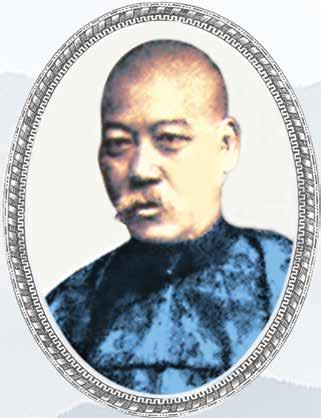
总理
吴寿珍 Goh Siew Tin
The First (1906–1907) and Third (1908–1909) President of the Chamber
Goh Siew Tin (1854–1909) came from Zhao’an, Fujian province. From a young age, he assisted his father in managing their business, Chop Ann Ho, which dealt in local products, tin slags, wood products and shipping.
During his tenure as President, he mediated disputes among the different dialect groups, donated to build schools, raised funds for disaster relief and encouraged the merchants to invest. He also proposed to the British colonial government to abolish the unfair rule of requiring Chinese passengers entering Singapore to strip naked for physical examination. He was also a philanthropist who served as a Board Member of the Thian Hock Keng Temple and rendered services as a Committee Member of Po Leung Kuk under the Chinese Protectorate. He was the Consular General of the Qing consulate in Singapore and a well-known leader in the Chinese community.
吴寿珍(1854 1909年),福建诏安人。自幼随父
经商,管理安和号,经营土产、锡米、木业、 船务等生意。 吴寿珍在总理(会长)任内,协调帮群纠纷、
第 一 章 The Leadership Stories of the SCCCI Presidents 商海领航 帷幄运筹 Chapter One 21 20
资助学校、募捐救灾、招商引资,曾向英殖民地
政府提出废除中国旅客裸体检疫的不合理规定。 吴寿珍也出任乐善社、天福宫董事,身兼 英国殖民地政府华民政务司保良局委员、清朝驻 新加坡代理总领事等职务,为本地知名华社领袖。
Chua Chu Yong (1847–year unknown) came from Chenghai, Guangdong province. In 1874, he came to Singapore and owned businesses dealing in silk and polished rice along South Bridge Road. During his tenure as President, he pushed forward the drafting of the Chamber’s Rules, purchased printing machines to save costs, urged the colonial government to ban opium smoking and fought for the circulation and exchange of old silver coins.
Chua Chu Yong was also a philantrophist. In 1902, he led the local Teochews in donating 30,000 Straits dollars’ worth of rice to provide relief during the rice shortage in Chaozhou. He was a Committee Member of the Chinese Advisory Board.

第二届 (1907-1908年) 总理
Chamber (1907–1908)
蔡子庸 Chua Chu Yong
The Second President of the
蔡子庸(1847
他担任总理期间,推动建会章程,自购印字 机器以节繁费,呼吁殖民政府禁烟,争取旧式银元 的流通和收换。 蔡子庸为人乐善好施,曾于1902年领导本地 潮侨以时值三万叻币的白米救济潮州米荒。他也 担任华人参事局的委员。 第 一 章 The Leadership Stories of the SCCCI Presidents 商海领航 帷幄运筹 Chapter One 23 22
不详),广东澄海人。1874年南来 新加坡,于桥南路从事绸缎和白米生意。
1910年),广东新宁(台山)人。他所
Lam Wai Fong (1863–1910) came from Xining (Taishan), Guangdong province. He started the Kwong Yik Bank, making him a pioneer of the local banking industry.
During his tenure as President, he revised the Chamber’s Rules, led the fundraising for the Fuzhou typhoon disaster relief, assisted the Chinese merchants to obtain travel documents for their return to China, rescued the poor and sickly, and assisted them on their return to China. He also assisted the Chinese businessmen in Batu Pahat, the state of Johor, Malay Peninsula, to establish their Chamber of Commerce.

同时也协助马来半岛柔佛州峇株巴辖的华商成立 其商会。 林维芳
第四届 (1909-1910年) 总理 The Fourth President of the Chamber (1909–1910) 第 一 章
林维芳(1863
创立的广益银行,开本地华人银行业之先河。 林维芳在其总理任内,曾修订章程,领导筹赈 福州风灾,办理回华商照,救助贫病者返回中国,
Lam Wai Fong
商海领航 帷幄运筹 Chapter One 25 24
The Leadership Stories of the SCCCI Presidents
1916年),福建南靖人。
Teo Sian Keng (1855–1916) came from Nanjing, Fujian province.

During his tenure as President, the Chamber drafted the “Arbitration Guidelines for Closure of Companies’ Operation Issued by the Chamber”, created a Chamber flag, led the relief effort for the Chaozhou drought and opposed the income tax proposed by the British colonial government.
He was once the President of Tao Nan School. He supported Sun Yat Sen’s revolutionary movement and received the Order of the Golden Harvest, awarded by the Chinese government.
The Fifth (1910–1911) and Seventh (1912–1913) President of the Chamber
救济潮汕旱灾;并反对英殖民政府提出的入息 所得)税。
的革命运动,荣获中华民国政府颁发嘉禾奖章。 第五届 (1910-1911年) 及第七届 (1912-1913年) 总理
张善庆(1855
在其两届总理任期内,总商会拟定了《商号 倒闭商会出任仲裁简章》、制定商旗;发动劝募
张善庆也出任道南学校总理。他支持孙中山
第 一 章 The Leadership Stories of the SCCCI Presidents 商海领航 帷幄运筹 Chapter One 27 26
张善庆 Teo Sian Keng
廖正兴 Leow Chia Heng

The Sixth (1911–1912) and Ninth (1914–1915) President of the Chamber
廖正兴(1874
1931年),广东潮安人,四海通银行 创办人。 两届总理任内,他带领总商会协助民国政府
第六届 (1911-1912年) 及第九届 (1914-1915年)
总理
Leow Chia Heng (1874–1931) was from Chao’an, Guangdong province. He founded the Sze Hai Tong Bank and Insurance Company Limited. During his tenure as President, he led the Chamber to assist the Chinese government in disaster relief activities, and was actively involved in donating to safeguard the security in Fujian, providing relief to Guangdong, and funding the return of the poor and sick Chinese to their hometowns. During the outbreak of war on the European front in 1914, the Chamber assisted local businesses to overcome the crisis. In 1915, the Chamber changed its premier system to the presidential system and the term of office was changed from one year to two years. During his tenure, the Chamber also purchased the property at Hill Street where the Chamber is located today. He served as a Committee Member of Po Leung Kuk, a member of the Chinese Advisory Board and a Justice of the Peace. 赈灾救难,积极投入福建保安和广东救济活动,
并资助贫病华民返乡。1914年欧战爆发后,总商会 大力协助本地商家度过危机。自1915年起将总 理制改为会长制,任期从一年改为两年一任。
第 一 章 The Leadership Stories of the SCCCI Presidents 商海领航 帷幄运筹 Chapter One 29 28
总商会亦在其任内购置禧街的产业,即今会所的所 在。 他也担任过新加坡保良局委员、华人参事局 委员等职,获委为太平局绅。
林秉祥 Lim Peng Siang

The Eighth (1913–1914) and 10th (1915–1917) President of the Chamber
负担;同年,总商会也协助筹赈广东水灾,获中国
Lim Peng Siang (1872–1944) came from Longxi, Fujian province. After coming to Nanyang, he studied at St Joseph’s Institution. He then followed in his father’s footsteps to set up businesses. He set up the Ho Hong Company and Ho Hong Bank. His lines of business involved shipping and manufacturing. During his tenure as President, he created a new accounting school and unified the bookkeeping system. In 1915, under his presidency, the Chamber raised funds to donate a fighter jet in support of the British war effort in Europe. When the British colonial government increased income taxes to offset war expenditures, the Chamber proposed to tax the landlords to alleviate the burden on the business sector. In the same year, the Chamber also helped to raise funds to relieve the floods in Guangdong. As a result, the Chinese government awarded the Chamber with a commemorative plaque with the phrase “Unifying for the Future”. He was also appointed as a Justice of the Peace and a member of the Chinese Advisory Board. Singapore once had a road named Peng Siang Quay in his honour. Peng Siang Quay in Singapore was named after him to commemorate his contributions to the society.
第八届 (1913-1914年) 总理 及第十届 (1915-1917年) 会长
任内推出新式会计学堂,统一簿记。1915年, 总商会筹款捐赠战机一台支援英军在欧洲的 战事;当殖民政府为抵消欧战开支而增抽入息
林秉祥(1872 1944年),福建龙溪人。南来后就读 圣约瑟书院,随父经商,创办实业,开设和丰银行, 经营海运有成。
税时,总商会建议政府改抽牌租税以减轻商界
政府颁给“群策匡时”匾额。 林秉祥亦担任华人参事局委员及受委为太平 局绅。新加坡的“秉祥基”以他的名字命名,纪念他
第 一 章 The Leadership Stories of the SCCCI Presidents 商海领航 帷幄运筹 Chapter One 31 30
对本地社会的贡献。
陈德润 Tan Teck Joon
The 11th President of the Chamber (1917–1919)
暂代。
Tan Teck Joon (1859–1918) was born in Chao’an, Guangdong province.
He was a successful silk and cloth merchant. In 1908, he initiated the founding of the Teochew Textile Trader’s Association. He was also one of the founders of Sze Hai Tong Bank and Insurance Company Limited and Tuan Mong School.
During his tenure as President, the Chamber encouraged the Chinese in Singapore to return to China and support its industrialisation efforts.
At the same time, the Chamber also published articles in the newspaper to encourage the public to purchase Straits Settlements bonds and participated in negotiations on income tax. The Chamber also raised funds via various channels to provide relief for local and overseas disasters.
Tan Teck Joon passed away in March 1918. Tan Jiak Ngoh succeeded as the acting President.

第十一届 (1917-1919年) 会长
陈德润 (1859 1918年), 广东潮安人。
陈德润是一名成功的布商,于1908年参与 成立新加坡布行商务局,也是四海通银行和端蒙 学校创办人之一。 会长任内,总商会鼓励本坡华民回中国兴办 实业,同时亦登报鼓励认购海峡殖民地军劵,并协 调入息税事宜。此外,总商会亦多方协助国内外
的筹赈活动。 陈德润于1918年3月逝世,会长职缺由陈若愚
第 一 章
商海领航 帷幄运筹 Chapter One 33 32
The Leadership Stories of the SCCCI
Presidents
薛中华 See Tiong Wah
The 12th (1919–1921) and 14th (1923–1925, by-election) President of the Chamber
See Tiong Wah (1886–1940) had ancestral roots in Zhangzhou, Fujian province, and was born in Singapore. He studied at St Joseph’s Institution. After graduation in 1909, he joined his father in the Comprador’s Department of the Hongkong and Shanghai Banking Corporation (HSBC) in Singapore.
During his tenure as President, he continued to negotiate with the government regarding income tax, food supply regulation as well as a new Chinese cemetery. He also raised funds to support the Chinese High School and Raffles Institution. In addition, the Chamber also raised funds to provide relief to victims of natural disasters in the different provinces in China. He also held office as a member of the Chinese Advisory Board and served as the Municipal Commissioner and a Justice of the Peace.

第十二届 (1919-1921年) 及第十四届 (1923-1925年, 补选) 会长
薛中华(1886 1940年),祖籍福建漳州,新加坡 出生,就读于圣约瑟书院,毕业后随父投身银行 业,1909年加入汇丰银行成为买办。 会长任内,持续与政府协调入息税、管粮 法令及华人义山等事宜,筹款资助南洋华侨中学 及莱佛士英校、同时也募款救济中国各省灾民。
第 一 章
薛中华亦担任华人参事局委员、市政会议员 及受委为太平局绅等。
商海领航 帷幄运筹 Chapter One 35 34
The Leadership Stories of the SCCCI Presidents
林义顺 Lim Nee Soon
The 13th (1921–1923) and 15th (1925–1927) President of the Chamber
Lim Nee Soon (1879–1936) had ancestral roots in Chenghai, Guangdong province, and was born in Singapore. He was homeschooled when he was young and subsequently attended St Joseph’s Institution. His businesses were very successful. He also supported Sun Yat Sen’s revolutionary activities.

During his tenure as President, in 1922, the Chamber launched The Commercial Monthly. In 1926, Lim Nee Soon opposed the abolition of the policy of allowing letters to be combined into one consignment. He also opposed the increase of the postage rates and proposed to add Chinese names in the railway stations and on the tickets.
He was also known as the “Rubber King” and “Pineapple King”. Furthermore, he also served as a member of the Singapore Rural Board, the Chairman of the Teochew Poit Ip Huay Kuan and the Chairman of the Ee Hoe Hean Club.
第十三届 (1921-1923年) 及第十五届 (1925-1927年) 会长
出生,幼时先上私塾、后读圣约瑟书院,毕业后经 商有成,积极支持孙中山的革命活动。
及增加邮费的政策、同时也函请政府在火车站及车 票上加写华文。 林义顺享有树胶和黄梨大王美誉,曾出任新加坡 乡村局局员、潮州八邑会馆首届总理、怡和轩 主席等职务。 第 一 章
Presidents 商海领航 帷幄运筹 Chapter One 37 36
林义顺(1879 1936年),祖籍广东澄海,新加坡
1922年,林义顺在其会长任内创办《总商会 月报》。1926年,林义顺反对殖民地邮局废止信包
The Leadership Stories of the SCCCI
林推迁 Lim Chwee Chian
The 14th President of the Chamber (1923)
Lim Chwee Chian (1868–1923) came from Haicheng, Fujian province. He was involved in the shipping, plantation and mining industries. However, he passed away soon after taking on the role as the President of the Chamber, and See Tiong Wah took over the position. During his tenure as President, the Chamber published notices in newspapers to canvass donations to provide relief for people affected by the Great Kanto earthquake in Japan. He also proposed to the colonial government to gradually phase out the issuing of opium licences. He served as the Chairman of Thong Chai Medical Institution and Ee Hoe Hean Club, and a Board Member of the Chinese High School and Chung Hwa Girls’ School. He was appointed as a Justice of the Peace and a Committee Member of Po Leung Kuk as well as the Chinese Advisory Board. He was awarded the Third Order of the Golden Harvest by the Chinese government.

第十四届 (1923年) 会长
种植业及矿业。 林推迁当选会长后不久便辞世,遗缺由薛中华
灾民,建议殖民地政府逐年取消烟廊牌照。 林推迁曾担任同济医院主席、怡和轩主席、 华侨中学及中华女校董事,也出任太平局绅、 保良局委员及华人参事局委员等职,曾获中国政府
第 一 章 The Leadership Stories of the SCCCI Presidents 商海领航 帷幄运筹 Chapter One 39 38
林推迁 (1868 1923年),福建海澄人,从事船运业、
接任。任内通过总商会登报劝募,救赈日本地震
三等嘉禾奖章。
薛武院 See Boo Ih
The 16th President of the Chamber (1927–1929)
See Boo Ih (1873–1940) was born in Xiamen, Fujian province. He was involved in the rubber plantation industry.

During his tenure as President, he took the lead in raising funds to provide relief to those affected by the flood in Kuantan, the state of Pahang, Malay Peninsula. He assisted the colonial government in pacifying the unrest caused by the Kreta Ayer Incident, which broke out in Chinatown during the death anniversary of Sun Yat Sen. He also urged the government to repeal the Immigration Restriction Ordinance, protecting the interests of the Chinese community.
He also served as the Chairman of the Chinese Commercial Bank Limited, the Manager of the Overseas Chinese Bank Limited, and the President of Singapore Ho San Kong Hoey.
第十六届 (1927-1929年) 会长
的暴动事件。他也要求政府取消限制移民条例, 维护华社利益。
第 一 章 The Leadership Stories of the SCCCI Presidents 商海领航 帷幄运筹 Chapter One 41 40
薛武院(1873 1940年),福建厦门人,从事树胶 种稙业。 会长任内筹赈马来半岛彭亨州的关丹水灾, 协助殖民地政府平抚孙中山忌日发生在牛车水
他也出任华商银行董事会、华侨银行经理、 新加坡禾山公会会长等职。
李伟南 Lee Wee Nam
1964年),广东澄海人,16岁时南来
Lee Wee Nam (1880–1964) came from Chenghai, Guangdong province. At the age of 16, he set sail for Singapore and worked at Sze Hai Tong Banking and Insurance Company Limited, beginning a career in banking and finance. His tenure coincided with the Great Depression. He contributed significantly to help the needy and alleviate hunger. He also petitioned the colonial government to set up a pottery factory for unemployed civilians.
He was appointed as the President of Ngee Ann Kongsi and Teochew Poit Ip Huay Kuan. In
1938, he established the Singapore Kwangtung Hui Kuan and was elected as its first President. He was appointed as a Committee Member of Po Leung Kuk and the Chinese Advisory Board, and as an inspector of the quarantine station on St John’s Island.

第十七届 (1929-1931年) 会长
李伟南(1880
新加坡,任职四海通银行,从事金融业。 会长任内,适逢世界经济大萧条。他慷慨
解囊,救济饥民,极力请求殖民地政府设立平民 工艺厂收纳失业工人。 李伟南曾担任义安公司总理及潮州八邑会馆 总理,并于1938年参与创设广东会馆,出任首任 会长。他亦先后担任保良局委员、华人参事局委员 及棋樟山检疫所巡视员。
第 一 章
商海领航 帷幄运筹 Chapter One 43 42
The 17th President of the Chamber (1929–1931)
The Leadership Stories of the SCCCI Presidents
李俊承 Lee Choon Seng
The 18th President of the Chamber (1931–1933)
Lee Choon Seng (1888–1966) came from Yongchun, Fujian province. He was the founder of the Chinese Commercial Bank Limited. During his tenure as President, he established the China Relief Fund for Disasters Committee and held a special discussion on the Aliens Ordinance.

In 1937, Lee Choon Seng, together with other Chinese merchants, jointly bought over the Sun Yat Sen Villa and handed the property rights to the Chamber, preserving Singapore’s history and heritage. This villa was Sun Yat Sen’s former residence.
In 1935, he was conferred a medal by the Governor-General of the British colonial government. He also served as the Chairman of the Eng Choon Hway Kuan, President of the Singapore Lee Clan Association, Chairman of the Ee Hoe Hean Club and President of the United Chinese Library.
第十八届 (1931-1933年) 会长
最后将产权交由总商会管理,使新加坡的历史 遗产得以保存。此别墅曾是孙中山故居。 李俊承于1935年荣获海峡殖民地总督颁赐 勋章,他也担任永春会馆主席、陇西李氏总会会长、 怡和轩主席、同德书报社副社长等职务。 第 一 章 The Leadership Stories of the SCCCI Presidents 商海领航 帷幄运筹 Chapter One 45 44
李俊承(1888 1966年),福建永春人,华商银行 创办人。 会长任内成立“星洲华侨救济中国惨灾 筹赈会”,亦召开特大讨论“外侨居留条例案”。 1937年,李俊承联合本地华商购置晚晴园,
林文田 Lum Mun Tin
The 19th President of the Chamber (1933–1935)
Lum Mun Tin (1873–1943) came from Taishan, Guangdong province. He came to Singapore at the age of 16 and went into the pawnshop business. During his tenure as President, the Chamber revised its Rules to change the words “Chinese sojourner” to “ethnic Chinese”, signalling the Chinese merchants’ shift in identifying with Singapore as their home, in the pre-war era. In 1934, the Chamber set up the Bukit Ho Swee Fire Relief Committee to help those affected by the fire.
Lum Mun Tin served as the President of the Singapore Pawnbrokers’ Association, a Committee Board Member of the Chinese High School and a Committee Member of Po Leung Kuk and Chinese Advisory Board.

第十九届 (1933-1935年) 会长
新加坡,经营当铺生意。 会长任内,总商会通过章程修改,将“吾侨” 改为“华人”,代表战前华商已出现本土认同之 转向;总商会亦于1934年成立“救济河水山火灾 委员会”,协助灾黎度过难关。 林文田也担任新加坡当商公会会长、华侨 中学董事、保良局及华人参事局委员等职。 第 一 章 The Leadership Stories of the SCCCI Presidents 商海领航 帷幄运筹 Chapter One 47 46
林文田(1873 1943年),广东台山人,16岁南来
林庆年 Lim Keng Lian
The 20th President of the Chamber (1935–1937)
Lim Keng Lian (1893–1968), a Peking University graduate, came from Anxi, Fujian province. He came to Singapore in 1924 and was involved in the tea trading business.

During his tenure as President, he took the lead and organised the Chinese Trade Fair, and expanded it to Perak, Vietnam, Batavia and other places. The Chamber also assisted the Chinese consulate in registering the Chinese nationals.
Lim Keng Lian also contributed greatly to Singapore’s Chinese education sector. He was a pioneer in promoting Chinese as the medium of instruction in Chinese schools. He helped to establish Sin Nan Public School in Jurong and suggested the implementation of examinations in primary schools.
第二十届 (1935-1937年) 会长
记侨民的工作。
第 一 章 The Leadership Stories of the SCCCI Presidents 商海领航 帷幄运筹 Chapter One 49 48
林庆年(1893 1968年),福建安溪人,北京大学 毕业。1924年南来新加坡,经营茶庄生意。 会长任内扩大举办国货展览推销大会至霹雳、 越南、巴达维亚等地;总商会协助中国领事馆登
林庆年对本地华文教育贡献良多,率先在学校 推动国语教学、推广华语、统一学校语言。 他也参与创办裕廊醒南学校,建议小学实施会考 制度。
陈振贤 Tan Chin Hian
The 21st President of the Chamber (1937–1939)
1964年),广东潮安人。1925年南来
Tan Chin Hian (1893–1964) came from Chao’an, Guangdong province. He came to Singapore in 1925. He served as the Director of Sze Hai Tong Banking and Insurance Company Limited.

During his tenure as President, the Chamber, on one hand, organised events to celebrate the coronation of King George VI. On the other hand, the Chamber bought $50,000 worth of war bonds to support China’s effort in resisting the Japanese invasion. The Chamber also issued a notice to encourage merchants to donate to China. He served as the President of Teochew Poit Ip
Huay Kuan, Vice-President of Ngee Ann Kongsi and a member of the Chinese Advisory Board. He was a well-known leader of the Teochew community.
第二十一届 (1937-1939年) 会长
支持中国抗日,并发表通告鼓励商家捐款救济 中国。
第 一 章 The Leadership Stories of the SCCCI Presidents 商海领航 帷幄运筹 Chapter One 51 50
陈振贤(1893
新加坡,担任四海通银行司理。 会长任内,总商会一方面筹办英皇加冕庆祝 活动,一方面因应日本侵华购买五万元战争债券
陈振贤曾任潮州八邑会馆总理、义安公副总理、 华人参事局委员,是本地著名的潮社领袖。
李光前 Lee Kong Chian

The 22nd (1939–1941) and 24th (1946–1948) President of the Chamber
Lee Kong Chian (1893–1967) came from Nan’an, Fujian province. In 1903, he came to Singapore and successfully built his business empire. He made a mark in the rubber trade, pineapple, and banking businesses.
During his tenure as President, he assisted the British colonial government by acting as the mediator when the staff at the Singapore General Hospital went on strike. He also supported the Chinese Consulate’s campaign to ban opium smoking. In 1947, he established a task force to discuss the issues on the Malayan Union constitutional report and citizenship before submitting a proposal to the British colonial government.
He was a firm believer in education and public welfare. In 1952, he set up the Lee Foundation. He is well remembered as an outstanding Chinese entrepreneur, educationist and philanthropist.
第二十二届 (1939-1941年) 及第二十四届
(1946-1948年) 会长
工友罢工事件,支持中国驻新总领事推动禁烟
李光前(1893
1967年),福建南安人。1903年南来 新加坡,经商有成,涉足树胶、黄梨、金融等产业。 会长任内,协助英殖民政府调解中央医院
运动。1947年,李光前成立研究小组探讨马来亚制
第 一 章 The Leadership Stories of the SCCCI Presidents 商海领航 帷幄运筹 Chapter One 53 52
宪报告书及公民权事宜,并向英殖民政府递呈意 见书。 李光前一生热心教育和公益。1952年,他 设立李氏基金,被誉为杰出的华人企业家、教育 家和慈善家。
连瀛洲 Lien Ying Chow
The 23rd President of the Chamber (1941–1945)
连瀛洲(1906 2004年),广东潮阳人。14岁南来
Lien Ying Chow (1906–2004) was from Chaoyang, Guangdong province. He arrived in Singapore when he was 14 and later started the Overseas Union Bank.
Lien Ying Chow was the youngest in the Chamber’s history to be elected president. He assumed the role of President of the Chamber on the eve of the outbreak of the Pacific War. He represented the views of the businessmen to oppose the colonial government from raising income tax. He also established the Relief Fund Committee to deal with the food distribution issue. He also urged businesses to remain open to safeguard and protect the interests of the public.
Lien Ying Chow was appointed as President of the Ngee Ann Kongsi. He also played a key role in the founding of Ngee Ann College and Nanyang University. In 1966, he served as the Singapore High Commissioner to Malaysia.

第二十三届 (1941-1945年) 会长
新加坡,后创办华联银行。 连瀛洲是总商会最年轻的会长。会长任内, 正值太平洋战争爆发前夕,他代表商家反对入 息税,同时也成立“星华救护委员会”,处理粮食 分配问题。他也劝请商家照常开市,维护和保障 社会大众的利益。 连瀛洲曾担任义安公司总理,他也是义安学 院创办人之一。此外,他也积极推动南洋大学的 创立。他于1966年出任新加坡驻马来西亚最高专 员。 第 一 章 The Leadership Stories of the SCCCI Presidents 商海领航 帷幄运筹 Chapter One 55 54
杨溢璘 Yong Yit Lin
The 25th President of the Chamber (1948–1950)
Yong Yit Lin (1896–1950) was from Meixian, Guangdong province. He was involved in the construction industry.

During his tenure as President, in 1949, the Chamber campaigned to donate to the poor and sick who were forced to repatriate. Meanwhile, he also wrote to the Colonial Secretary of Singapore to oppose the charges of the landing permit. The Chamber also encouraged Chinese people who were British subjects to register as citizens to be able to vote in the Legislative Council election. He also served as the President of Ying Fo
Fui Kun, President of Singapore Contractors Association Limited, a member of the Chinese Advisory Board and a Justice of the Peace.
第二十五届 (1948-1950年) 会长
总商会亦鼓励英籍华人登记为公民,以便在立法 议员选举中取得投票权。
建筑商公会会长、华人参事局委员、太平局绅等 职。 第 一 章 The Leadership Stories of the SCCCI Presidents 商海领航 帷幄运筹 Chapter One 57 56
杨溢璘(1896
1950年),广东梅县人,从事建筑业。
会长任内,总商会于1949年发动“被遣离穷苦 及家属义捐”,同时致函辅政司反对登岸证收费。
他也曾担任新加坡应和会馆总理、新加坡
陈六使 Tan Lark Sye
The 26th President of the Chamber (1950–1952)
陈六使(1897
1972年),福建同安人。18岁南来 新加坡,从事树胶业。
南洋大学,全力支持第一所华文大学的创立,为本 地作育英才。 陈六使也担任福建会馆主席、新加坡树胶
Tan Lark Sye (1897–1972) was from Tong’an, Fujian province. He came to Singapore at the age of 18, establishing his business in the rubber industry. During his tenure as President, he donated $500,000 in the name of the Chamber to the University of Malaya Foundation. He raised funds to provide relief for victims of the Kampong Bugis fire. He also led the Chamber in the fight for citizenship rights.
In 1953, he personally donated $5 million to Nanyang University to fully support the establishment of the first Chinese-medium university to nurture local talents.

第二十六届 (1950-1952年) 会长
He also served as the President of the Hokkien Huay Kuan, the Chairman of the Chinese Rubber Association and the Chairman of Ee Ho Hean Club. 会长任内,陈六使以总商会名义捐款五十万
作为马来亚大学基金。他也在任内拨款救济武义 村大火的灾民; 带领总商会积极争取公民权。
1953年,陈六使再以个人名义捐赠五百万元给
第 一 章
工会主席、怡和轩主席等职务。
商海领航 帷幄运筹 Chapter One 59 58
The Leadership Stories of the SCCCI Presidents
陈锡九 Tan Siak Kew
The 27th (1952–1954) and 29th (1956–1958) President of the Chamber
Tan Siak Kew (1903–1977) came from Chao’an, Guangdong province. He came to Singapore in 1910 and received an English-language education from St Anthony’s Boys’ School and Raffles Institution. His business was involved in trading and banking. During his tenure as President, he supported the Public Service Commission Ordinance and led the Chamber to assist the government in building up Singapore’s national defence. The Chamber assisted 300 youths in the registration for National Service. He also set up a registration booth in the Chamber, allowing secretariat staff to assist locals in the citizenship application process. He held important positions in the Chinese Advisory Board, Ngee Ann Kongsi and Teochew Poit Ip Huay Kuan. In 1965, he was appointed as Singapore’s first ambassador to Thailand.

第二十七届 (1952-1954年) 及第二十九届
(1956-1958年) 会长
陈锡九(1903 1977年),广东潮安人。1910年南来,
入伍登记。他亦在总商会设立公民权登记站,让 秘书处义务协助民众填写申请表格。 陈锡九也出任华人参事局委员、义安公司、
为新加坡首任驻泰国大使。 第 一 章 The Leadership Stories of the SCCCI Presidents 商海领航 帷幄运筹 Chapter One 61 60
就读圣安东尼小学、莱佛士书院,经营百货贸易
及银行。 两届任内,陈锡九拥护民众服务法案,带领总 商会协助政府建军、办理首批为数300人的青年
潮州八邑会馆总理等重要职务。他在1965年受委
Ko Teck Kin
The 28th (1954–1956), 30th (1958–1960), 31st (1960–1962) and 32nd (1962–1965) President of the Chamber
Ko Teck Kin (1911–1966) was from Longxi, Fujian province. He followed in his father’s footsteps to manage businesses. His businesses dealt in the import and export of manufacturing goods between Indonesia and Singapore, and were involved in the shipping, rubber plantation and other industries. During his tenure as President, he created the Citizenship Rights Committee and encouraged the public to register as electors to vote in the 1955 Singapore General Election. In 1959, the Chamber also organised the Constitution Exposition to commemorate the internal self-government of Singapore, and it was the largest exposition in Southeast Asia. In 1964, the Chamber also completed the reconstruction project of the new Chamber building.
Ko Teck Kin served as the Chairman of the Ee Ho Hean Club, Chairman of Chung Cheng High School, Vice-President of the Singapore Koh Clan Association and President of the Singapore Leong Khay Huay Kuan. He was appointed as the first High Commissioner to Malaysia in 1965.

第二十八届
第三十届
第三十一届
及第三十二届 (1962-1965年) 会长
(1954-1956年)
(1958-1960年)
(1960-1962年)
高德根
高德根(1911 1966年),福建龙溪人,随父从商,
从事船运、树胶等业务。
第 一 章 The Leadership Stories of the SCCCI Presidents 商海领航 帷幄运筹 Chapter One 63 62
会长任内,总商会成立“推动选民选举
委员会”,鼓励民众登记成为选民,行使1955年 议会选举的投票权。1959年,总商会举办“庆祝 新加坡自治博览会”成为东南亚最大的展销会。 总商会也在1964年顺利完成新会所重建工程。 高德根也担任怡和轩主席、中正中学董事 主席、高氏公会以及龙溪会馆主席等职。1965年 他受委为第一任新加坡驻马来西亚最高专员。
Soon Peng Yam
The 33rd (1965–1967) and 34th (1967–1969) President of the Chamber

Soon Peng Yam (1912–2002) came from Tong’an, Fujian province. At the age of 14, he came to Singapore. He was involved in the timber industry before diversifying into other industries such as trade, property development, plantations and mining.
During his tenure as President, he set up an Overseas Mission Taskforce to strengthen the Chamber’s external networks and improve trade. In 1967, the Civilian War Memorial, which the Chamber campaigned for, was unveiled. In 1968, the Chamber raised more than $1.23 million towards national defence. He served as the Chairman of the Ee Hoe Hean Club and the Chung Hwa Free Clinic Trust Foundation, and as the President of District A of St John Ambulance Brigade, the Chinese Swimming Club and other social welfare organisations.
第三十三届 (1965-1967年) 及第三十四届 (1967-1969年) 会长
孙炳炎
新加坡,先从事林木业,后扩展到贸易、房地产、 种植及采矿等事业。 孙炳炎在会长任内成立“贸易考察团小组”, 以加强总商会的对外联系、促进贸易。1967年, 日本占领时期死难人民纪念碑在总商会推动下 揭幕。1968年总商会亦为国防部筹募国防基金 123万余元,支持国防力量。 孙炳炎也担任怡和轩主席、同时为福建会馆、 中华医院、圣约翰救伤队、中华游泳会等重要社团
第 一 章 The Leadership Stories of the SCCCI Presidents 商海领航 帷幄运筹 Chapter One 65 64
孙炳炎(1912 2002年),福建同安人。14岁南来
服务。
黄祖耀 Wee Cho Yaw
The 35th (1969–1971), 36th (1971–1973) and 39th (1977–1979) President of the Chamber
Wee Choo Yaw (1930– ) was born in Jinmen, Fujian province. At the age of eight, he reunited with his father in Kuching. He came to Singapore a year later to receive his education. After graduation, he was involved in the banking and finance industry. During his tenure as President, he rallied various parties in Singapore and Malaysia to break the monopolistic practices in the freight industry. He also helped the victims from Malaysia and East Pakistan and organised a delegation to visit the Socialist Republic of Vietnam. He also amended the Chamber’s Rules to add “Industry” to the Chamber’s English name to reflect the increasing number of members belonging to the manufacturing sector. He served as the first President of the Singapore Federation of Chambers of Commerce and Industry, the President of the Hokkien Huay Kuan and the founding President of the Singapore Federation of Chinese Clan Associations.

第三十五届 (1969-1971年) 第三十六届 (1971-1973年) 及第三十九届 (1977-1979年) 会长
教育。毕业后,投入银行界工作。 会长任内,总商会团结新马各界打破航运 垄断的斗争,也救济马来西亚及东巴基斯坦的 灾民,并组团访问越南社会主义共和国。同时,
“Industry”,以代表逐年增加的工业会员。 黄祖耀也出任新加坡工商总会首任会长、 福建会馆会长、新加坡宗乡会馆联合总会会长 等职务。 第 一 章 The Leadership Stories of the SCCCI Presidents 商海领航 帷幄运筹 Chapter One 67 66
黄祖耀(1930年 ― ),福建金门人。八岁时,他的父亲
接他到古晋团聚。一年后,再安排到新加坡接受
提出章程修改,在总商会之英文全称上加入
陈共存 Tan Keong Choon
The 37th (1973–1975), 38th (1975–1977), 42nd (1983–1985) and 43rd (1985–1987) President of the Chamber
Tan Keong Choon (1918–2015) was born in Xiamen, Fujian province. He was the nephew of Tan Kah Kee, and was involved in the rubber plantation industry.

During his tenure as President, the Chamber set up a $2 million education foundation to assist the development of science and technology education in Singapore. He also organised the first local Chinese Computer Exhibition and the largest ever Trade & Industry Fair in 1985.
He also served as the Vice-Chairman of the Singapore National Shippers’ Council, VicePresident of the Singapore Rubber Association, Chairman of the Chinese High School, and a Council Member of Hokkien Huay Kuan, and held leadership roles in various banks.
第三十七届
第三十八届
及第四十三届
(1973-1975年)
(1975-1977年) 第四十二届 (1983-1985年)
(1985-1987年)
陈共存(1918 2015年),福建厦门人,陈嘉庚侄儿, 从事树胶贸易。 会长任内,总商会拨款二百万成立教育 基金,协助科学技术教育在新加坡的发展,并举
“工商展览会85”。 陈共存也曾出任新加坡配货人理事会副主席、
第 一 章 The Leadership Stories of the SCCCI Presidents 商海领航 帷幄运筹 Chapter One 69 68
办了本地最早的“中文电脑展览会”及规模最大的
新加坡树胶公会副会长、华侨中学、福建会馆以及 多家银行的董事职务。
林继民 Lim Kee Ming
The 40th (1979–1981) and 41st (1981–1983) President of the Chamber
Lim Kee Ming (1927–2015) had ancestral roots in Chao’an, Guangdong, and was born in Singapore. He was involved in the import and export trade industry and became Chairman of the Lim Teck Lee Group after inheriting his father’s business.

During his tenure as President, the Chamber worked with the government to assist local businesses with industry transformation. The Chamber also pushed forward the Speak Mandarin Campaign and set up a training centre to provide bilingual (English-Chinese) lessons.
He also served as the President of Ngee Ann
Kongsi, President of the Singapore Teochew Poit Ip Huay Kuan, Chairman of the Singapore AntiTuberculosis Association, a Committee Member of the Economic Development Board and Singapore Trade Development Board, and Chairman of the Preservation of Monuments Board.
第四十届 (1979-1981年) 及第四十一届 (1981-1983年) 会长
集团主席。
发展高科技,支持商家朝机械化转型,同时协助 政府推广华语运动。总商会也设立语言中心, 提供中英语文课程。 林继民也担任义安公司总理、潮州八邑会馆 总理、新加坡防痨协会主席、经济发展局和贸易 发展局委员会委员、古迹保存局主席等职务。 第 一 章 The Leadership Stories of the SCCCI Presidents 商海领航 帷幄运筹 Chapter One 71 70
林继民(1927 2015年),祖籍广东潮安,新加坡 出生,从事进出口贸易,继承父业后出任林德利
会长任内,总商会配合政府协助本地企业
林荫华 Linn In Hua
林荫华(1924
1998年),福建金门人。1938年南来
Linn In Hua (1924–1998) came from Jinmen, Fujian province. He went to Malaya in 1938 and later set up East Machinery Group, which dealt in the trading of heavy machinery and equipment.

The 44th (1987–1989) and 45th (1989) President of the Chamber
接任。
During his tenure as President, the Chamber and the Singapore Malay Chamber of Commerce & Industry established a joint working committee to set up an economic, educational and cultural subcommittee to promote the Chambers’ cooperation and interaction in these areas. In 1989, he proposed the unprecedented idea of organising the World Chinese Entrepreneurs Convention. Shortly after, Linn In Hua handed over the role of President to Tan Eng Joo because of health reasons.
第四十四届 (1987-1989年) 及第四十五届 (1989年) 会长
马来亚,成立东风机械有限公司,从事机械设备 贸易。 会长任内,总商会与马来商会成立联合工作 委员会,下设经济、教育及文化体育小组,促进 两会在相关领域的合作与互动。他于1989年
首倡举办世界华商大会的概念。随后,因健 康关系卸下会长职务,由陈永裕接任。世界 华商大会的概念后便逝世,遗缺由陈永裕
第 一 章
商海领航 帷幄运筹 Chapter One 73 72
The Leadership Stories of the SCCCI Presidents
陈永裕 Tan Eng Joo
The 45th (1989–1991) and 46th (1991–1993) President of the Chamber
2011年),祖籍福建同安,新加坡
Tan Eng Joo (1919–2011) had ancestral roots in Tong’an, Fujian province, and was born in Singapore. He was the nephew of Tan Lark Sye. After studying in America, he returned to Singapore and set up Tan Eng Joo Holdings Pte. Ltd. to deal in the trading of rubber.
During his tenure as President, in 1991, the Chamber organised the first World Chinese Entrepreneurs Convention. The Chamber also signed a contract with Rotterdam to jointly set up the Singapore Trade & Distribution Centre (Rotterdam) B.V. to promote Singapore products in the European market. The Chamber actively participated in the ASEAN-CCI meetings. He served as the President of the Democratic Party, Chairman of the Rubber Association of Singapore, Chairman of the International Rubber Association and Chairman of the International Chamber of Shipping.

第四十五届 (1989-1991年) 及第四十六届 (1991-1993年) 会长
陈永裕(1919
出生,为陈六使的侄儿。留美归来后成立陈永裕工 程有限公司,也从事树胶生意。
鹿特丹贸易与分销中心有限公司”,向欧洲市场 促销新加坡的产品。总商会也积极参与亚细安工 商总会会议。 陈永裕也担任民主党主席、新加坡树胶公会
第 一 章
Presidents 商海领航 帷幄运筹 Chapter One 75 74
1991年,总商会成功举办第一届世界华商大会; 亦与荷兰鹿特丹市签署合约,联合经营“新加坡
主席、国际橡胶公会主席、国际航运公会主席等职。
The Leadership Stories of the SCCCI
郭令裕 Kwek Leng Joo
The 47th (1993–1995), 48th (1995–1997), 51st (2001–2003) and 52nd (2003–2005) President of the Chamber
2015年),祖籍福建同安,新加坡出
功的企业家、慈善家,热爱摄影艺术。
Kwek Leng Joo (1953–2015) had ancestral roots in Tong’an, Fujian province, and was born in Singapore. He was involved in the real estate development and trading investment. During his tenure as President, in 1993, he amended the Rules to abolish the clan-based election system and affirmed the role of the Chinese language in the Chamber. The Chamber also promoted the SME Computerisation Project and the Career Women’s Group. In 2001, the refurbished Sun Yat Sen Nanyang Memorial Hall was unveiled at a ceremony officiated by Singapore’s founding Prime Minister Lee Kuan Yew and reopened to the public. In 2004, Kwek Leng Joo launched the SCCCI Young Entrepreneurs Network to nurture younger entrepreneurs. He served as an Honorary Council Member of the Hokkien Huay Kuan, President of the Singapore Compact for Corporate Social Responsibility and other roles. He was also a successful businessman, philanthropist and an enthusiastic photographer.

第四十七届 (1993-1995年) 第四十八届 (1995-1997年) 第五十一届
及第五十二届 (2003-2005年) 会长
(2001-2003年)
郭令裕(1953
生,从事房地产开发及贸易投资。
修改,废除分帮选举制度,并确立华文华语在 总商会的地位。总商会也推动中小型企业电脑化 计划,并成立事业女性组;2001年,晚晴园整修后
郭令裕曾担任新加坡福建会馆名誉理事、 新加坡企业社会责任协会会长等职务,是一名成
1993年,郭令裕在其会长任内通过章程
由建国总理李光耀开幕,重新对外开放。2004年, 郭令裕成立青年企业家联系网,培养轻年一代 的企业才俊。
第 一 章
商海领航 帷幄运筹 Chapter One 77 76
The Leadership Stories of the SCCCI Presidents
郑民川 Tay Beng Chuan

The 49th (1997–1999) and 50th (1999–2001) President of the Chamber
郑民川(1939年
― ),祖籍福建漳州,印度尼西亚巨
Tay Beng Chuan (1939– ) has ancestral roots in Zhangzhou, Fujian province, and was born in Palembang, Indonesia. After the war, he came to Singapore. His family business is involved in the shipping industry. After receiving his education in Australia, he set up Uni-Navigation Pte. Ltd., and expanded into real estate and the insurance premium funding business.
举办首届华语“中小型企业大会”;推动漆街三十层
办公大楼的联合发展项目。 郑民川于1997年成为总商会第一位受委为 新加坡官委议员的会长,并连任至2001年。
第四十九届 (1997-1999年) 及第五十届 (1999-2001年) 会长
During his tenure as President, the Chamber organised the International Trade & Industry Fair (ITIF) for local businesses to network and obtain business opportunities. The Chamber also set up the Sun Yat Sen Nanyang Memorial Hall Company Limited, for the renovation and management of the Sun Yat Sen Nanyang Memorial Hall; launched the inaugural Mandarin SMEs Conference; and commenced the joint development of the 30-storey office building at Church Street. He was appointed as a Nominated Member of Parliament in Singapore in 1997 and served till 2001. 业,留澳归来创立联航有限公司,再扩大从事房地 产、保费融资等事业。
港出生,战后移居新加坡。郑民川家族经营航运
会长任内,总商会举办国际工商展,建立策略
联盟以获取重要商机;成立孙中山南洋纪念馆有
第 一 章 The Leadership Stories of the SCCCI Presidents 商海领航 帷幄运筹 Chapter One 79 78
限公司,由总商会负起晚晴园的整修和管理;
蔡天宝 Chua Thian Poh
百年庆典。2007年,总商会与新加坡政府携手创
立“通商中国”,以促进新中两国的经贸发展。
蔡天宝于2005年受委为太平绅士。他也
Chua Thian Poh (1948– ) has ancestral roots in Jinjiang, Fujian province, and was born in Singapore. He was involved in real estate development and is currently the Chairman of the Ho Bee Group.

The 53th (2005–2007) and 54th (2007–2009) President of the Chamber
职务,并于2015年受委为新加坡驻马尔代夫共和 国非常驻大使,2019年则受委为总统顾问理事会
理事。
During his tenure as President, the Chamber set up the Singapore Enterprise Centre, launched the Chamber’s new logo, organised the first Trade Association Congress and celebrated the centennial anniversary of the Chamber. In 2007, the Chamber set up Business China with the support of the government to cultivate a China-ready Singaporean workforce to strengthen ties between Singapore and China.
In 2005, he was appointed as a Justice of the Peace. He also served as the President of the Singapore Federation of Chinese Clan Associations, President of Hokkien Huay Kuan, Chairman of Business China, Chairman of Ren Ci Hospital and various other important appointments. He was appointed as the Non-Resident Ambassador of Singapore to the Republic of Maldives in 2015. He also served on the Council of Presidential Advisers in 2019.
第五十三届 (2005-2007年) 及第五十四届 (2007-2009年) 会长
会长任内,总商会成立了企业发展中心,推出
蔡天宝(1948年 ― ),祖籍福建晋江,新加坡出生,
从事房地产开发事业,现为和美集团主席。
崭新的会徽,也举办了第一届商团大会及总商会
出任新加坡宗乡会馆联合总会会长、新加坡福建 会馆会长、通商中国主席、仁慈医院主席等重要
第 一 章 The Leadership Stories of the SCCCI Presidents 商海领航 帷幄运筹 Chapter One 81 80
Teo Siong Seng
The 55th (2009–2011) and 56th (2011–2013) President of the Chamber
促进各族群之间的商业与文化交流。2009年,
总商会将晚晴园交由国家文物局管理和整修,
并于辛亥革命100周年对外开放。 张松声于2009年受委为官委议员,连任一届
至2014年。2014年他出任新加坡工商联合会主席。
Teo Siong Seng (1955– ) has ancestral roots in Jinmen, Fujian province, and was born in Singapore. Currently, he is the Managing Director of Pacific International Pte. Ltd., and Chairman and Chief Executive Officer of Singamas Container Holdings Ltd.

During his tenure as President, the Chamber led several business missions to India, South Africa and Nigeria to explore opportunities in trade and investment, and formed the Immigrants Liaison Group. The Chamber also hosted the 11th World Chinese Entrepreneurs Convention in 2011, and jointly organised networking activities with the Malay and Indian chambers to promote business and cultural interactions between the different races. In 2009, the Chamber handed over the management and refurbishment of the Sun Yat Sen Nanyang Memorial Hall to the National Heritage Board. The refurbished Hall was reopened on the 100th anniversary of the 1911 Revolution.
He was appointed as a Nominated Member of Parliament in 2009 and served till 2014. In 2014, he served as the Chairman of the Singapore Business Federation.
第五十五届 (2009-2011年) 及第五十六届 (2011-2013年) 会长
张松声
张松声(1955年 ― ),祖籍福建金门,新加坡出生,
现为太平船务(私人)有限公司董事总经理及 胜狮货柜企业有限公司董事长兼首席行政总监。
尼日利亚等国考察商机;增设了“移民联系组”。 此外,总商会举办了第十一届世界华商大会,
会长任内,总商会带领商家远赴印度、南非、
亦与马来商会及印度商会联合举办联谊活动,以
第 一 章
商海领航 帷幄运筹 Chapter One 83 82
The Leadership Stories of the SCCCI Presidents
第五十七届 (2013-2015年) 及第五十八届 (2015-2017年)
会长
蔡其生 Thomas Chua Kee Seng
The 57th (2013–2015) and 58th (2015–2017) President of the Chamber
Thomas Chua Kee Seng (1954– ) has ancestral roots in Jinmen, Fujian province, and was born in Singapore. He graduated from Nanyang University. He is currently the Managing Director of Teckwah Industrial Corporation Ltd.
During his tenure as President, the Chamber played the role of a bridge between the government and business organisations, assisting SMEs and family businesses to tackle the challenges they faced. The Chamber also awarded scholarships to outstanding university students. The Chamber signed a Memorandum of Understanding with JTC Corporation on the setting up of a Trade Association Hub to promote industry upgrading and collaboration in 2015. He was appointed as a Nominated Member of Parliament in 2014 and re-elected in 2018. In 2021, he assumed the roles of the President of the Hokkien Huay Kuan, and President of the Singapore Federation of Chinese Clan Associations.

规划企业未来。总商会也设立奖学金颁赠基金, 颁发奖学金给表现优异的大专学生。总商会
商团中心,以推动行业转型及合作。 蔡其生于2014年受委为官委议员,连任一届 至2018年。2021年他出任新加坡福建会馆会长、 新加坡宗乡会馆联合总会会长。 第 一 章 The Leadership Stories of the SCCCI Presidents 商海领航 帷幄运筹 Chapter One 85 84
蔡其生(1954年
― ),祖籍福建金门,新加坡出生,
毕业于南洋大学,现为德华工业控股有限公司主 席兼董事经理。 会长任内,总商会扮演政商桥梁,协助中小企 业经济重组及自我提升,支持商家及会员更好地
于2015年与裕廊集团签署备忘录,联合设立
Roland Ng San Tiong
基金的设立、总商会华商文化馆的筹备工作,以
弘扬华商精神和华商文化。
总商会于2019年会员大会上通过章程修改, 将董事任期从每届两年延长至三年,赋予董事会
Roland Ng San Tiong (1952– ) has ancestral roots in Anxi, Fujian province, and was born in Singapore.
After studying in the United Kingdom, he inherited his father’s business. He is currently the Managing Director of Tat Hong Holdings Ltd.

The 59th (2017–2019) and 60th (2019–2022) President of the Chamber
更充裕的时间来筹划会务、贯彻议程,加强工作 的执行力度。
黄山忠于2019年受委为新加坡驻东帝汶非常
驻大使。
During his tenure as President, the Trade Association Hub was officially inaugurated. The Chamber pushed forward its building renovation project, the initiation of the SCCCI Chinese Entrepreneurial Culture Foundation, and the SCCCI Chinese Business Culture Hub, promoting the Chamber Chinese Entrepreneurial Spirit and business culture.
In 2019, after the Annual General Meeting, the Chamber amended the Rules, extending the term of service for the Council from two years to three years per term. This allows the Council Members to have ample time for planning, implementation and enforcement.
In 2019, Roland Ng San Tiong was appointed as Singapore’s Non-Resident Ambassador to the Democratic Republic of Timor-Leste.
第五十九届 (2017-2019年) 及第六十届 (2019-2022年) 会长
黄山忠
黄山忠(1952年 ― ),祖籍福建安溪,新加坡出生, 留英归来继承父业,现为达丰控股有限公司董事 经理。
会长任内,商团中心正式开幕,投入运作;
积极推动总商会大厦翻新工程、总商会华商文化
第 一 章 The Leadership Stories of the SCCCI Presidents 商海领航 帷幄运筹 Chapter One 87 86
CHAPTER TWO
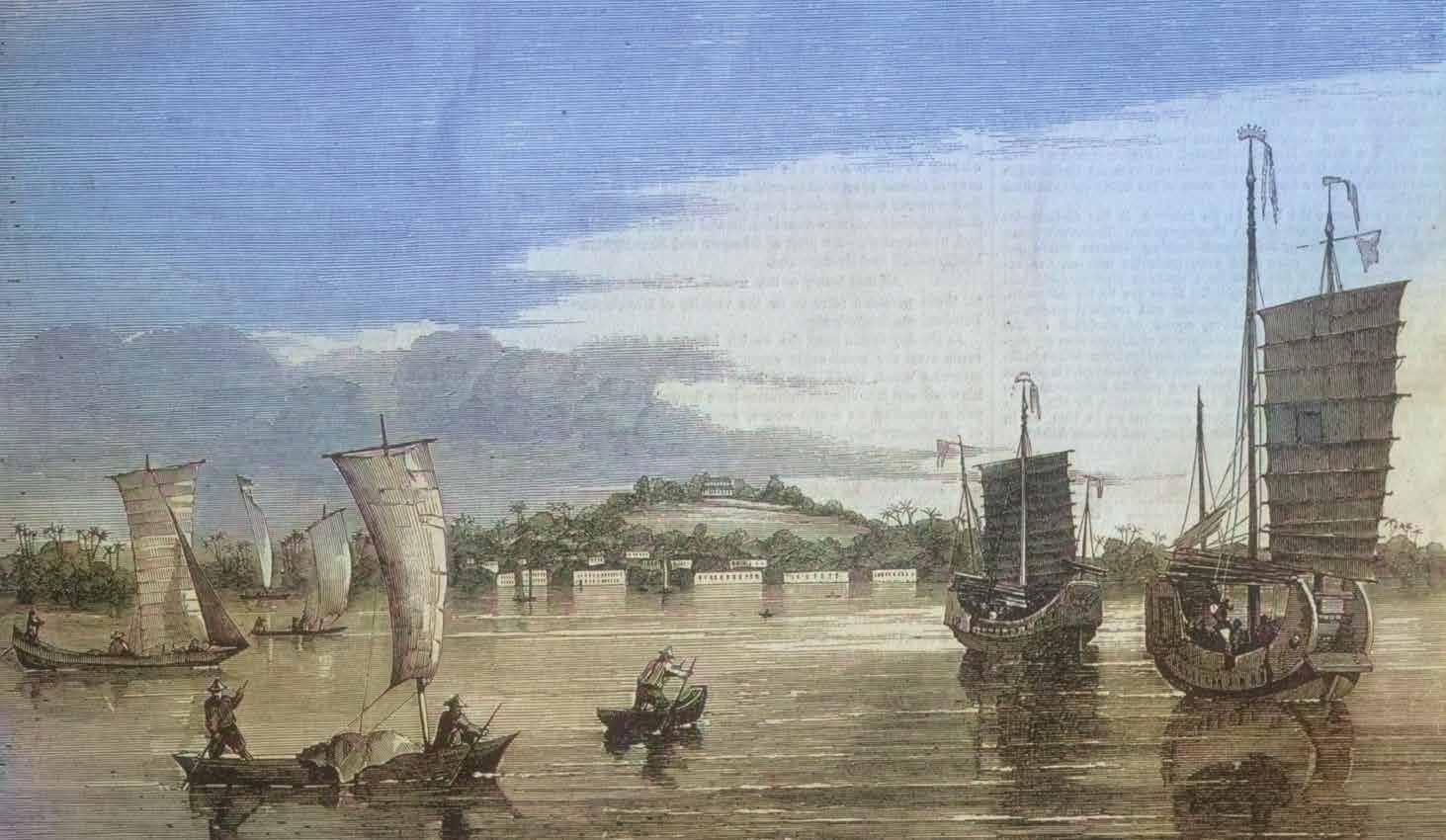
第二章
新加坡河景(1857) Singapore River (1857)
峥嵘岁月 时代印记
诚 信、效忠、回馈、创新是华商精神的四大精
髓,也是总商会的发展基石。身为百年 社团及世纪商团,总商会谨守华商精神,不忘初
心、与时俱进,牢记其社会责任与角色。
就华商精神价值而言,“诚信”包含诚实、守信、
正直等品德;“效忠”具备效命、忠诚、牺牲与奉
献等特质;“回馈”体现助人为善、关怀弱势、资
源分享等作为;“创新”则指创意、革新,具有与
时并进的思维。华商精神是总商会的内在驱动
力,四面并行、特质相赋,也是当今华商的道德 准则和行为规范。
本章透过二战后总商会主导的事件来体现
总商会的华商精神,认识本地华商的成就与作为,
并具体说明他们如何落实“诚信为本、效忠为国、
创新为先、回馈为民”的理念。
Glorious Years: Leaving a Mark in History
Integrity, Loyalty, Giving back to society, and Innovation are four key elements of the Chinese Entrepreneurial Spirit, and the cornerstone of the Chamber’s development.
As a century-old organisation and trade association, the Chamber will strictly uphold the Chinese Entrepreneurial Spirit, not forget its roots while moving with the times, and remember its responsibilities to and role in the society.
As the core values of the spirit, integrity means being honest, keeping promises and being forthcoming in thought and deed; loyalty means committing our lives to the country, being faithful in making sacrifices and contributing to nation-building; giving back to society means doing philanthropic work, helping the needy and
sharing resources; and innovation means crafting new and revolutionary ideas, upgrading with the times and being forward-thinking. The Chinese Entrepreneurial Spirit is the driving force of the Chamber. When all four core values converge into one, blessed with natural qualities, that is the epitome of the Chinese Entrepreneurial Spirit. This chapter outlines the major post-war events that highlight the Chinese Entrepreneurial Spirit. Through these events, we can understand the achievements of the local Chinese businessmen and how they applied the concept of “Integrity, Loyalty to the country, Giving back to Society, and Innovation”. ❖
❖
INTEGRITY
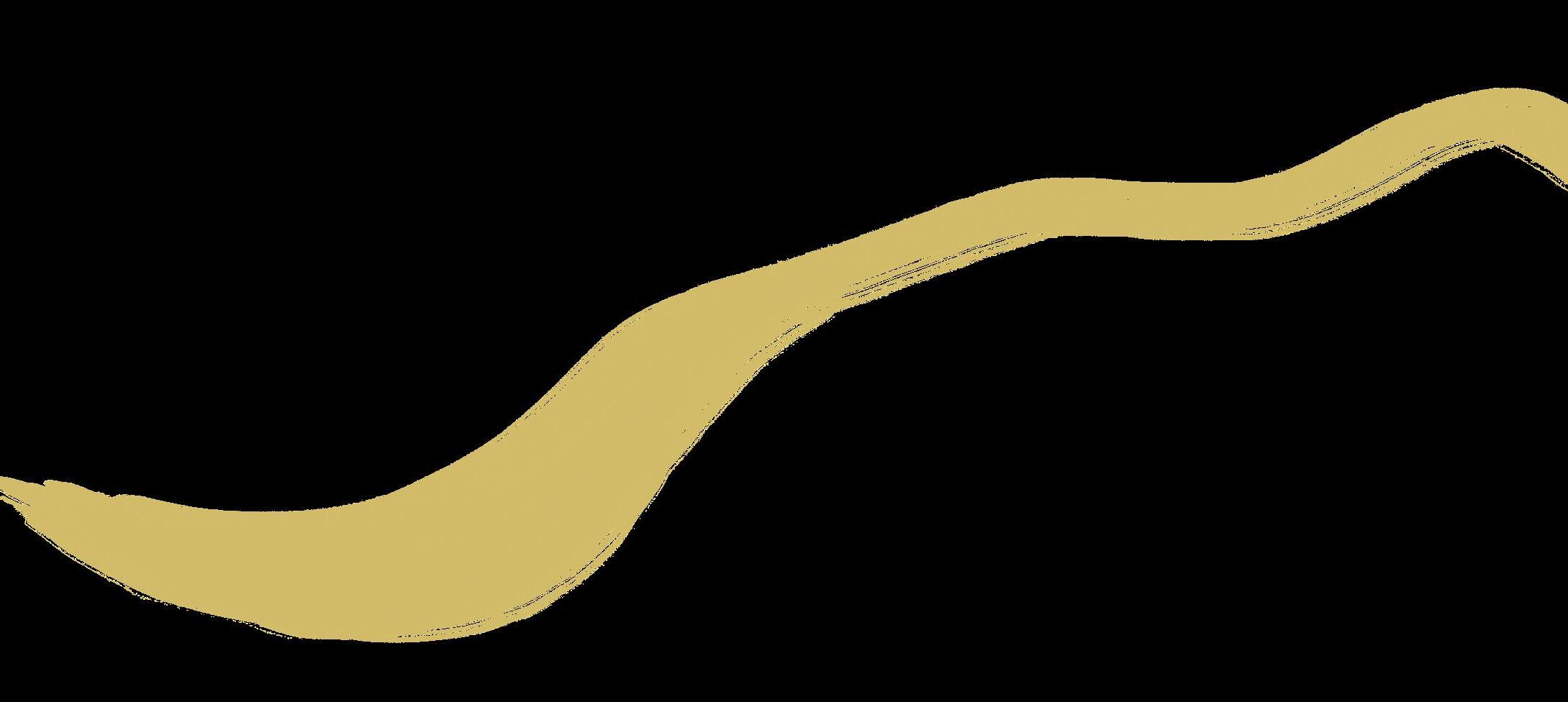
新加坡自治博览会(1959年)
The Singapore Constitution Exposition (1959)
1 959年1月31日,总商会为庆贺新加坡取得 自治邦地位,结束与英国长达140年的殖民地 关系,特别举办“庆祝新加坡自治博览会”。
博览会成功吸引450商家参加,超过30万人参观, 是为东南亚有史以来规模最盛大的博览会。
博览会的成功,意谓着本地华人相信总商会的 诚信领导,支持新加坡自治邦的成立,展现认同本土
On31 January 1959, the Chamber commemorated the attainment of Singapore’s internal selfgovernment, which ended its 140 years of British colonial rule, by specially organising the Constitution Exposition. It successfully attracted 450 exhibitors and over 300,000 visitors, becoming the largest and most spectacular exposition in Southeast Asia’s history.
The success of the exposition implies that the local Chinese believed in the Chamber’s integrity and supported the attainment of Singapore’s internal self-government and demonstrated their localised political identity. Meanwhile, the Chamber also provided a new platform for local businesses to network, created business opportunities and reinforced Singapore’s capability and status as an international trading entrepôt.
的政治立场。与此同时,总商会也为本地商家 提供了新的平台,开拓网络,创造商机,宣示 新加坡作为国际贸易转口港的经济实力与地位。
商家 Exhibitors 1959 年1月31日至3月13日 31 January to 13 March 1959 旧加冷机场 OLD KALLANG AIRPORT 访客 Visitors 450 300,000 第 二 章
峥嵘岁月 时代印记 Chapter Two 95 94
Glorious Years: Leaving a Mark in History
1959年,总商会主办“庆祝新加坡自治博览会”。
The Chamber organised the Singapore Constitution Exposition in 1959.

1959年,总商会主办 “庆祝新加坡自治博览会”, 并出版《庆祝新加坡自治博览会纪念刊》。
The Chamber organised the Constitution Exposition and published the Souvenir of the Singapore Constitution Exposition in 1959.
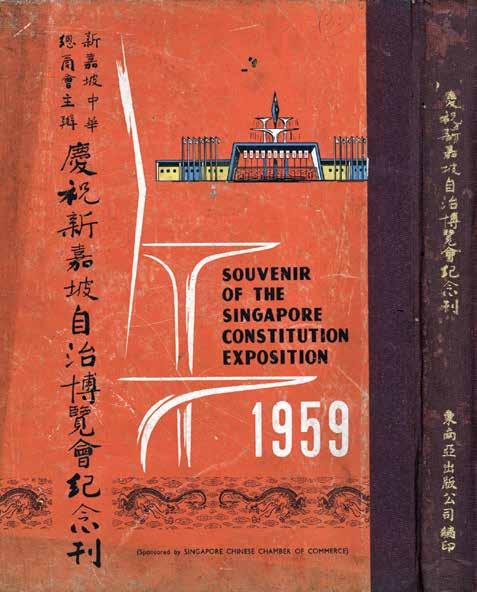
第 二 章
in History 峥嵘岁月 时代印记 Chapter Two 97 96
Glorious Years: Leaving a Mark
商业考察团(1965年) Trade Missions (1965)
Since the establishment of the Commerce Committee in 1965, the Chamber has actively assisted members to move into international markets and organised groups to discover business opportunities overseas. The Chamber has also analysed the trends of the business environment in overseas markets, liaised with the various government agencies for dialogues, arranged members to meet overseas businessmen, and explored opportunities for investment and bilateral cooperation. The Chamber has imprinted its footprints all around the world; besides China and ASEAN countries, the Commerce Committee members have also travelled to South Asia, the Middle East, Africa and Europe.
For over half a century, the Chamber has tirelessly led members to gain a foothold in the local market, explore regional and international markets and seize global business opportunities.
总
商会自1965年成立“贸易考察团小组”以来, 积极为会员拓展国际市场,组团到
海外考察商机,了解当地的商业环境,联系相关
政府部门进行对话,也安排团员跟当地企业家 交流,探讨投资及双边合作的可能性。总商会 的足迹遍及世界,除了中国与亚细安国家,考察 团也远赴南亚、中东、非洲和欧洲。 半个世纪以来,总商会努力不懈,带领会员立足 本地,开拓区域内及国际市场,把握全球商机。
第 二 章 峥嵘岁月 时代印记 98
The Chamber organised a business mission to the United Arab Emirates (UAE) and Qatar in 2007.

The Chamber organised a business mission to Nigeria and South Africa in 2009.
黄山忠会长于2019年率领考察团赴意大利进行考察活动。
The Chamber organised a business mission to Myanmar in 2012.


 2007年,总商会代表团前往阿拉伯联合酋长国 与卡塔尔考察与交流。
总商会于2009年代表团前往非洲的尼日内亚与南非 考察与交流。
2012年,总商会代表团前往缅甸 考察与交流。
2007年,总商会代表团前往阿拉伯联合酋长国 与卡塔尔考察与交流。
总商会于2009年代表团前往非洲的尼日内亚与南非 考察与交流。
2012年,总商会代表团前往缅甸 考察与交流。
第 二 章 Glorious Years: Leaving a Mark in History 峥嵘岁月 时代印记 Chapter Two 101 100
Roland Ng San Tiong, the President of the Chamber, led a delegation to Italy on a business mission in 2019.
运费垄断(1972年)
Blocking the Freight Monopolies (1972)
船 运业是新加坡自开埠以来的经济命脉,
长期由殖民时期所成立的船运公会垄断,
经常面对运费调涨的威胁,严重阻碍新加坡
转口贸易的发展。1964年,总商会成功带领新马
树胶业界发动抵制,迫使海峡及纽约航运公会和
远东班轮公会相继取消涨价的计划。
1967年,总商会联合62个商团组成“船运载费
工作委员会”,重提船运公会费率过高的课题。总商会
首先争取新马政府及商界的支持,成立自己的船运
订载中心,同时也寻求非船运公会成员的协助, 不断与西方的航运公会讨价还价,直到1970年代
初期才成功阻止航运公会随意调高运费的局面。
这个成果说明总商会与政府、商界和跨国企业
之间的关系紧密,透过集体交涉的力量为商家 谋取最大利益。
The Full Report of the Mass Meeting of Representatives of Singapore Trade Organisations on the Question of Freight Rates in 1967.
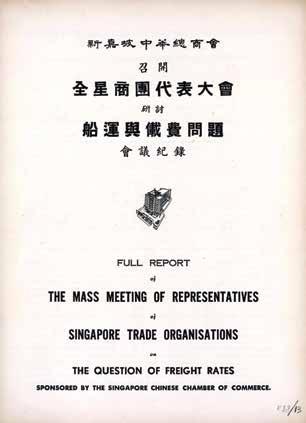
Since the opening of Singapore’s port, the shipping sector has been of critical importance to the economy. However, all freight rates were set by the dominant freight conference system, which had been established since colonial times. The constant threat of rising freight rates seriously hindered the development of Singapore’s re-export trade. In 1964, the Chamber successfully led the rubber industry in resisting the Straits/New York Conference and Far Eastern Freight Conference’s plans of increasing their freight rates. In 1967, the Chamber worked together with the 62 trade associations to form the Freight Fees Working Committee to re-discuss the shipping tariffs issue. The Chamber first sought support from the government of Singapore-Malaysia and the business community and established a booking centre. The Chamber also enlisted the support of non-conference members from overseas to constantly negotiate with the Western shipping conferences for many years. It was in the early 1970s when the Chamber managed to resist them
from monopolising freight rates. This shows the importance of having the Chamber, government, business community and multinational companies coming together to achieve the best results for the business community.
1972年,新加坡全国配货人理事会成立大会。
The inauguration of the Singapore National Shippers’ Council in 1972.

1967年,新加坡中华总商会召开 “全星商团代表大会” 研讨船运与载费问题会议记录。
第 二 章 Glorious Years: Leaving a Mark in History 峥嵘岁月 时代印记 Chapter Two 103 102
黄祖耀
Wee Cho Yaw
我们奋斗的主要目标是废除所谓的合约制度, 摆脱欺压性的垄断。我们要争取自由竞争 的空间。与其他行业相同,唯有通过自由竞争 才能取得公平﹑合理的货运价格。
总商会时任副会长,1967年5月20日
Then Vice-President of the Chamber, 20 May 1967
The main purpose of our campaign must be concentrated on the abolishment of the so-called contract system, on the breakaway from the oppressive monopoly. We must fight for free competition in freight shipping. In common with other lines of businesses, only through fair competition would we be able to secure fair and reasonable freight rates.

第 二 章 Glorious Years: Leaving a Mark in History 峥嵘岁月 时代印记 Chapter Two 105 104
商团大会(2006年)与商团中心(2017年)
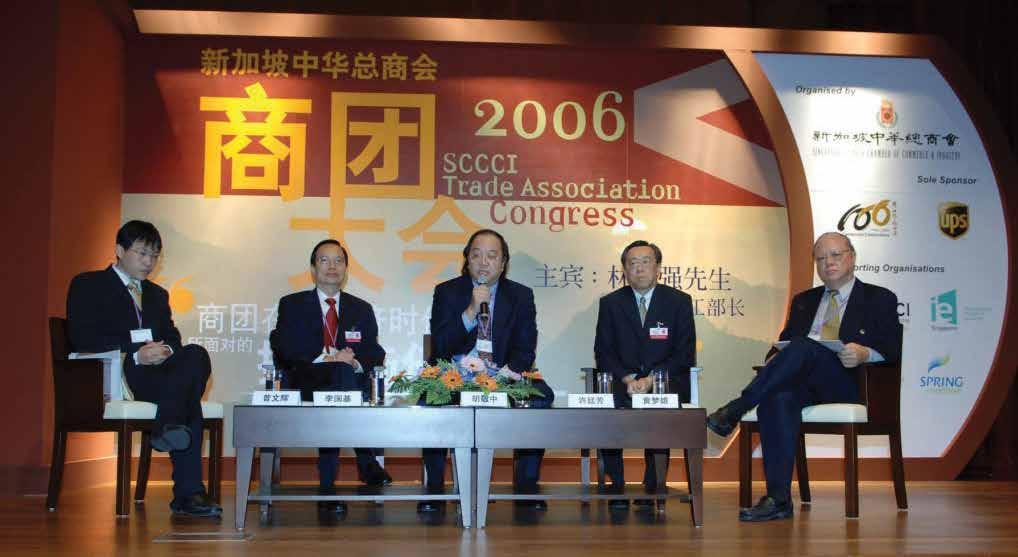
The Trade Congress (2006) and Trade Association Hub (2017)
On 24 June 2006, the Chamber held its first Trade Congress, attracting more than 100 trade associations and more than 600 representatives to discuss the possibility of strengthening the cooperation between the government agencies and enterprises. Since then, the Chamber has been organising many trade congresses. These trade congresses enable trade association members to improve communication and strengthen cooperation with government agencies for industry transformation.
The aim of the TA Hub is to provide a platform for various trade associations to cooperate and share resources. It also leads the trade associations in transformation, innovation and entering overseas markets, contributing greatly to Singapore’s economic development.
总商会于2006年举办的第一届商团大会。
2 006年6月24日,总商会举办的第一届商团 大会,吸引100多个商团公会、600多名代表 与会,共同商讨如何加强企业与政府机构的
合作。此后,总商会多次举办商团大会,协助企业 与商家在快速变幻的经济大环境里,求新求变。
“商团中心”的宗旨在于提供各行各业商团 一个合作的平台,共享资源,同时也协助本地企 业转型、创新、进军海外市场,为国家的经济发展 作出贡献。
第 二 章 Glorious Years: Leaving a Mark in History 峥嵘岁月 时代印记 Chapter Two 107 106
The Chamber held its first Trade Congress in 2006.
总商会于2017年在裕廊集团鼎力支持之下成立“商团中心”,并邀请李显龙总理开幕。
In 2017, the Chamber set up the Trade Association Hub (TA Hub) located at Jurong Town Hall with support from the Jurong Town Corporation. Lee Hsien Loong, the Prime Minister of Singapore, officiated the opening of the TA Hub.

面对日新月异,竞争激烈的商业环境,像商团中心
这样的一个合作平台,能让中小型商家共享知识 和资源,从中受惠。商团之间能够紧密合作,帮助 旗下的中小型企业和会员商家提升实力,开拓 新的合作领域,为国家共创佳绩。
The TA Hub promotes collaboration by bringing the trade associations and chambers together under one roof in the face of a rapidly changing and competitive economy. It offers shared facilities and services to all trade associations and chambers in Singapore at affordable rates.
总理李显龙, 2017年
Lee Hsien Loong, Prime Minister of Singapore, 2017
第 二 章 Glorious Years: Leaving a Mark in History 峥嵘岁月 时代印记 Chapter Two 109 108

第 二 章 Glorious Years: Leaving a Mark in History 峥嵘岁月 时代印记 Chapter Two 113 112
公民权运动(1947至1957年)
The Fight for Citizenship Rights (1947–1957)
战 后英国殖民者复返新马地区,争取公民权的 议题随着全球民族自决浪潮及本土政治 认同转向逐渐浮上台面。1949年新中国成立后,新马
华人与原乡的联系越加疏离,大多数人选择落地生 根,投身反殖、争取独立之路。
1947年英殖民地政府所颁布的新加坡立法议会选
举法,规定非英藉民没有投票资格及被提名权。适逢
总商会前会长连瀛洲受委为市政局议员的任期届满,
总商会推荐连任,但市政局按新条例唯英藉民能担
权事宜向殖民地政府提呈备忘录,此后分别于1951、
人顺利取得公民权。
公民权赋予人民参政的权利及扩大参与公共
事务的资格,为新加坡在1959年通过选举
产生的第一届自治政府铺路。总商会历经十年的
努力,最终在争取公民权运动中取得胜利,使本地
华人成为这块土地的一员,对新加坡产生归属感。
总商会的努力,奠定本地发展成为一个多元种族与
文化社会的基础,对新加坡日后独立建国贡献卓著。
Following the return of the British to Malaya and Singapore, the issue of citizenship gradually came to the fore with the global wave of national self-determination and the turn towards a local political identity. The founding of the People’s Republic of China in 1949 further estranged the Chinese in Malaya from their hometowns in China. The local Chinese decided to reside in Singapore, preparing for the road to decolonisation and the fight for independence. In 1947, the British colonial government announced in the Singapore Legislative Council Election Ordinance that non-British subjects would be ineligible to vote or be nominated as a candidate.
新加坡公民权证书(1958年)。
Certificate of Registration for Singapore citizenship (1958).
杨修灏家属捐赠

任议员,要求另行推举人选。此事让总商会深刻意识 到公民权的重要性,开始投入更多关注。
1947年2月15日,总商会正式为本地华人争取公民
Lien Ying Chow, the Immediate Past President of the Chamber, was appointed as the municipal councillor to represent the Chamber but his term was coming to an end. The Chamber recommended him for re-nomination but the Municipal Council, citing the rule of the new ordinance, requested for the Chamber to put up an eligible candidate. This incident made the Chamber deeply aware of the importance of citizenship and it began to shift its focus on the issue. 1953及1955年再三向政府提出公民权要求,终于促成 “1957年新加坡公民权法令”的制定。1957年11月1日 公民权法令正式生效,总商会和华社团体,协助22万
Donated by Yong Siew Hong’s family
On 15 February 1947, the Chamber officially submitted a memorandum to attain the right for local Chinese to obtain citizenship. The Chamber subsequently submitted requests to the government on the issue of local citizenship in 1951, 1953 and 1955, resulting in the enactment of the 1957 Singapore Citizenship Ordinance, which came into effect in November 1957. The Chamber and the Chinese community immediately assisted the government in the registration of citizenship, facilitating the process for 220,000 people to acquire the status.


Citizenship gives people the right to participate in politics and expand their involvement in public affairs, paving the road for Singapore’s first elected self-government in 1959. After ten years of relentless campaigning, the Chamber finally achieved victory in its bid for citizenship, allowing the local Chinese to become a part of this land and creating a greater sense of belonging to Singapore. The dedication and contributions of the Chamber laid the foundation
for Singapore to steadily develop into a multi-ethnic and multi-cultural society, contributing greatly to nation-building.
1957年,连瀛洲(右三)与高德根(中)于福康宁山的
1957年,总商会协助市民办理公民权登记手续。
In 1957, the Chamber opened its doors to assist locals in the citizenship registration process.
公民权登记中心合影。
Lien Ying Chow (third from right) and Ko Teck Kin (centre) at the citizenship registration centre at Fort Canning in 1957.
第 二 章 Glorious Years: Leaving a Mark in History 峥嵘岁月 时代印记 Chapter Two 115 114
国民服役(1967年)与 国防基金(1968年)
National Service (1967) and Donation of Total Defence Funds (1968)
After Singapore gained its independence, the foremost task of the government was to build our national defence force. In March 1967, the government implemented National Service. The Chamber fully supported and assisted
in the registration of National Service. As an encouragement to Singaporeans, the Chamber subsequently donated 7,500 National Service commemorative medallions to the enlisted youths.
新 加坡独立后务必要建设自己的国防力量。
当政府在1967年3月宣布实施国民服役制,
总商会全力配合、协助宣导和登记事宜,先后捐赠
了7,500枚“尽忠报国”纪念章给入伍青年,以资鼓 励。
1968年2月24日,总商会召开“全国注册社团筹
募国防基金大会”,共有800名出席者代表382机构 与会,支持国防部建军计划,一致通过为国防部
展开国防基金筹募工作,当天现场认捐了164,000 余元。自3月1日起至12月23日,民间在总商会国防
新加坡政府于1967年推行国民服役。总商会特别订制限量版 的纪念章送给入伍青年。纪念章有“尽忠报国”和“National Service”字样。
The Singapore government introduced the National Service Bill in 1967. The Chamber specially made limited edition medallions for the enlisted youths. The medallions feature the words “Jin Zhong Bao Guo” (serving the country with utmost loyalty) and “National Service”.


Lee Kuan Yew, the then Prime Minister (centre), attended a send-off dinner for the National Servicemen at Tanjong Pagar Community Centre (1968).
The Straits Times © Singapore Press Holdings Limited. Reprinted with permission

基金募捐小组的领导下,总共筹得1,232,294.90元。
时任总理李光耀(中间)出席丹戎巴葛区 欢送国民服役青年晚宴(1968年)。
新加坡报业控股旗下海峡时报
第 二 章 Glorious Years: Leaving a Mark in History 峥嵘岁月 时代印记 Chapter Two 117 116
On 24 February 1968, the Chamber organised the Fundraising Meeting of Singapore Registered Trade Associations for the National Defence Foundation at an auditorium to raise funds for the embryonic beginnings of National Service and the Singapore Armed Forces. Almost 800 representatives from 382 business entities donated more than $164,000

on the spot. From 1 March to 23 December, under the leadership of the Chamber National Defence Foundation working committee, the Chamber further helped to raise $1,232,294.90 towards the coffers of national defence to express its loyalty towards the country.
In 1968, the Chamber organised the Fundraising Meeting of Singapore Registered Trade Associations for the National Defence Foundation.
Wee Cho Yaw, the then President of the Chamber (third from right), paying the army a visit in 1972. On his left is Goh Keng Swee, the then Minister for Defence.
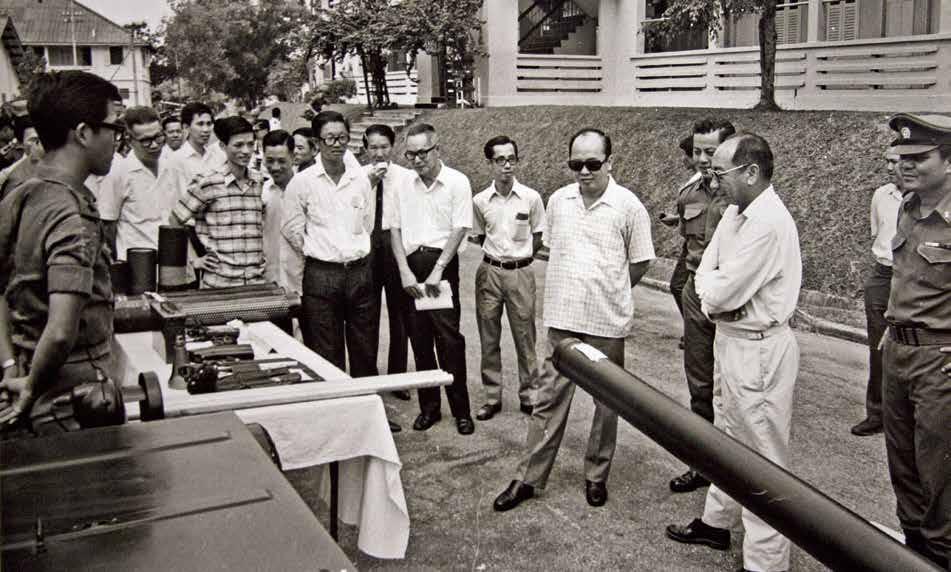
1972年,时任总商会会长黄祖耀(右三)率领商会代表访问兵团。右一为时任国防部长吴庆瑞。
1968年,总商会召开 “全星注册社团筹募国防基金大会”。
第 二 章 Glorious Years: Leaving a Mark in History 峥嵘岁月 时代印记 Chapter Two 119 118
官委议员
Nominated Members of Parliament
总 商会成立以来一直扮演政府与商界的
桥梁角色。殖民时期,总商会会长及董事 经常被授于华人参事局委员、保良局委员、工部 议员、市政局议员等官职。1951年,新加坡总督
邀请总商会派一名代表出席立法会议,董事陈振传
被提名为立法议会代表,为华社和商界发声。
新加坡独立后,当政府于1997年推出官委议员 制度时,总商会第49届会长郑民川成为总商会
第一位受委为新加坡官委议员的会长。时任总商
会社会事务组主任的张齐娥、时任产业组副主任的 庄绍平,均以工商界代表进入立法议会。21世纪
官商之间的了解。政府透过对话会直接掌握到商 界所面对的困难,企业也更深入地理解到政策的 动机和考量,更有效地善用政府提供的援助计划 与配套。总商会作为官商桥梁,充分发挥其沟通
Since its establishment, the Chamber has played the role of a bridge between the government and the business community. In the colonial period, the President and the Council Members of the Chamber frequently held government positions in the Chinese Advisory Board, Po Leung Kuk, Legislative Council and Municipal Commission. In 1951, the Singapore governor invited the Chamber to send a representative to the Legislative Assembly. In 1951, Tan Chin Tuan was nominated as an unofficial member of the Legislative Council, representing the Chinese community and business community.
After Singapore gained independence, the government introduced its Nominated Members of Parliament (NMPs). Tay Beng Chuan, the 49th President of the Chamber, was the first to be
appointed to represent the Chamber as an NMP.
The other two NMPs representing the business community were Claire Chiang, then Chairperson of the Chamber’s Community Relations Committee and Chuang Shaw Peng, then Vice-Chairman of the Property Committee. Entering the 21st century, Teo Siong Seng, the 56th President of the Chamber, and Thomas Chua Kee Seng, the 58th President of the Chamber, were appointed as NMPs. On behalf of the local business community, they raised topics of concern in Parliament as feedback to the government. The Chamber has organised regular dialogue sessions with the various government sectors to help bridge the gap between the business stakeholders and the government. Through these interactions, the government agencies could understand the
界发言,向政府反映企业所关注的课题,供政府 参考。 总商会定期举办与政府各部门的对话,促进
以降,总商会第56届会长张松声及第59届会长蔡其生 也先后受委为官委议员,在国会上代表本地工商
与协调功能,为新加坡的经济转型、商贸发展及 社会稳定作出贡献。
第 二 章 Glorious Years: Leaving a Mark in History 峥嵘岁月 时代印记 Chapter Two 121 120
difficulties faced by the business community and in turn, the business community could then understand the rationale and objectives behind government policies and initiatives. This would help the business community gain more insights to tap on the assistance schemes and policies introduced by
the government. As the official bridge between the government and business community, the Chamber uses its communication and coordination capabilities in dialogue sessions to contribute to Singapore’s economic transformation, industrial development and social stability.
1997年,事业女性小组为本会三位担任官委议员的董事(第49届总商会会长郑民川(左),董事张齐娥(中),董事庄绍平(右))主办 “与本会官委议员有约” 下午茶会。
In 1997, the Chamber’s three Nominated Members of Parliament—the President of the 49 th Council Tay Beng Chuan (left), and Council Members Claire Chiang (centre) and Chuang Shaw Peng (right)—attended the Tea Session with our Nominated Members of Parliament, organised by the Chamber’s Career Women Group.

郑民川于1997年受委为管委议员。
Tay Beng Chuan was elected as an NMP in 1997.
Teo Siong Seng was elected as an NMP in 2009.

蔡其生于2014年受委为管委议员。
Thomas Chua Kee Seng was elected as an NMP in 2014. 张松声于2009年受委为管委议员。


第 二 章
in History 峥嵘岁月 时代印记 Chapter Two 123 122
Glorious Years: Leaving a Mark
军人节宣誓仪式 Singapore Armed Forces (SAF) Day

Combined Rededication Ceremonies
S ince 2016, the Chamber and the Ministry of Defence have jointly held a Singapore Armed Forces (SAF) Day Combined Rededication Ceremony every year on 1 July. This annual event provides an opportunity to reaffirm employers’ commitment and support towards National Defence and recognise their contributions to the security of Singapore.
自 2016年起,总商会与国防部合作,在每年 7月1日举办“军人节集体宣誓仪式”。是日, 工商界、雇主及国民服役人员重申对国家的效忠, 以及对国防建设的全力支持,同时也肯定军人 保家卫国的贡献。
总商会于2016年举办军人节宣誓仪式。国防部长黄永宏(右)与时任会长蔡其声(左)。
第 二 章 Glorious Years: Leaving a Mark in History 峥嵘岁月 时代印记 Chapter Two 125 124
The Chamber organised the SAF Day Combined Rededication Ceremony in 2016. The Minister for Defence Ng Eng Hen (right) and Thomas Chua Kee Seng (left).
军人节宣誓仪式: Singapore Armed Forces (SAF) Day Combined Rededication Ceremonies:





2017 2018 2019 2020 2021
第 二 章 Glorious Years: Leaving a Mark in History 峥嵘岁月 时代印记 Chapter Two 127 126

南洋大学
(1953至1980年) Nanyang University (1953–1980)
1953年1月21日,总商会召开董事会议响应福建

会馆主席陈六使提出兴办南洋大学的倡议,
总商会代表先后担任南大筹备委员会及南大执行 委员会的核心成员,并以总商会名义加入南大会员,
决议协助南大办理一切事宜,为建设中国之外 的第一所中文大学出钱出力。
南洋大学自1955年开学,至1980年与新加坡大学
合并成为新加坡国立大学,历时25年。这段期间,
总商会与南大风雨同舟,包括陈六使、李光前、
连瀛洲、高德根、陈锡九、黄祖耀等各届会长,
担任南大理事会主席,或捐献巨款,对这座肩负
华族文化传承和促进各民族交流的文化堡垒,
鼎力支持。南大为新加坡及区域内各国作育英才,
南大生学有所长,亦不吝于回馈社会和国家。
第 二 章 Glorious Years: Leaving a Mark in History 峥嵘岁月 时代印记 Chapter Two 131 130
On21 January 1953, in response to the proposal by Tan Lark Sye, President of the Hokkien Huay Kuan, to set up Nanyang University, the Chamber held a Council meeting. Representatives of the Chamber held offices as treasurer and secretary in the fundraising and executive committees of Nanyang University. The Chamber also joined the core members of Nanyang University to facilitate and execute the construction of the university. The Chamber contributed financial and material resources to build the first Chinese-medium university outside China.

Nanyang University, which lasted 25 years in history, was opened in 1955 and merged with
the University of Singapore to form the National University of Singapore in 1980. During this period, the Chamber went through thick and thin with Nanyang University. The Presidents of the Chamber, including Tan Lark Sye, Lee Kong Chian, Lien Ying Chow, Ko Teck Tin, Tan Siak Kew and Wee Cho Yaw, either served as the Chairman of Nanyang University or donated generously. They fully supported Nanyang University, an institution that has passed on the legacy of the Chinese culture and promoted interactions among all ethnic groups. Nanyang University has groomed various talents in different sectors in Singapore, and their graduates continuously give back to the society and country.
第 二 章 Glorious Years: Leaving a Mark in History 峥嵘岁月 时代印记 Chapter Two 133 132
新加坡中华总商会基金(1966年)
Singapore Chinese Chamber of Commerce Foundation (1966)

1 964年总商会新大厦落成后,董事会决议将
建设大厦所剩的余款成立“新加坡中华总商会
基金”,并于1966年1月27日完成注册,4月4日对外
公布。总商会基于“取之社会,用之社会”的宗旨, 透过产业委员会盈余及募捐方式来充实基金。
中华总商会基金的主旨在于推动教育、文化、
社区和慈善事业,为我国社会发展作出贡献,
并为孙中山南洋纪念馆筹募资金作修复和管理 之用。
总商会支持本地教育发展,其基金每年颁发奖
学金给学业表现优异的学生,至今已超过2,000人
受惠。为了促进种族和谐,总商会先后于2013年
和2015年与马来回教社区发展理事会及新加坡
1,500万作为大学奖学金基金,分别在本地五所
大学(新加坡国立大学、南洋理工大学、新加坡 管理大学、新加坡科技与设计大学及新加坡理工
大学)设立奖学金,资助本地大学生。
1960至1970年代,新加坡中华总商会基金颁发奖学金典礼后留影。
2016年,大学奖学金捐赠基金成立仪式。
Glorious Years: Leaving a Mark in History

印度人发展协会合作,共同颁发奖学金给友族
大学生。2016年总商会于110周年庆典上,捐款
The University Scholarship Endowment Fund Inauguration Ceremony in 2016.
第 二 章
A group photo taken after the Singapore Chinese Chamber of Commerce Foundation Scholarship Presentation Ceremony in the 1960s and 1970s.
峥嵘岁月 时代印记 Chapter Two 135 134
After the completion of the new Chamber building in 1964, the Council decided to establish the Singapore Chinese Chamber of Commerce Foundation with the remaining funds from the building construction. The foundation was incorporated on 27 January 1966 and announced on 4 April. The Chamber, based on the principle of “taking from the society, giving back to the society”, has been using the surplus from the Property Committee and other fundraising methods to fund the foundation.
The Singapore Chinese Chamber of Commerce Foundation aims to contribute to the community development of Singapore by promoting educational, cultural, community and charitable activities, including raising funds for the restoration and management of the Sun Yat Sen Nanyang Memorial Hall.
The Chamber supports the development of local education. Every year, the foundation awards
scholarships to local students with outstanding academic performance, benefitting more than 2,000 people. The Chamber worked with the Malay Muslim Community Development Council (MENDAKI) and Singapore Indian Development Association (SINDA) in 2013 and 2015 respectively to jointly award scholarships to students of other races to promote racial harmony. In 2016, during the Chamber’s 110th anniversary celebration, the Chamber established the $15 million Singapore Chinese Chamber of Commerce Foundation University Scholarship Endowment Fund for local university students. The scholarship was donated to five local universities, namely, National University of Singapore, Nanyang Technological University, Singapore Management University, Singapore University of Technology and Design and the Singapore Institute of Technology.
We actively invest in the society and education, providing subsidies for needy students, helping disadvantaged groups. As a century-old Chamber, it has always kept abreast of the times, never forgetting the motto of the Chamber and remembering the social responsibilities and roles the Chamber has to shoulder.
Roland Ng San Tiong, 59 th President of the Chamber, 2017
我们积极投入社会和教育事业,包括资助贫寒学生,扶助弱势群体等。
身为百年商会、世纪商团,总商会一直与时并进,不忘初心,
时刻牢记我们所肩负的社会责任和角色。
总商会第59届会长黄山忠,2017年
第 二 章 Glorious Years: Leaving a Mark in History 峥嵘岁月 时代印记 Chapter Two 137 136
日本占领时期死难人民纪念碑(1967年)
The Civilian War Memorial (1967)
日 本占领新加坡时期(1942至1945年),日军
在全岛进行大检证,制造无数冤魂。1962年, 樟宜、武吉知马等地相继发掘大批死难者遗骸。

总商会经商讨决议成立“日本占领时期死难人民
遗骸善后委员会”,负起探查、发掘和迁葬遗骨
的工作,并透过政府要求日本道歉及赔偿,追讨 迟来的正义,同时也建议政府设立“日本占领时期
死难人民纪念碑”告慰亡魂,警惕世人珍惜和平的代 价。
死难人民纪念碑座落在美芝路,碑高67米, 碑身由四根白色柱子组成,代表华族、马来族、
印度族以及欧亚裔四大族群的罹难同胞,支柱上方
During the Japanese Occupation of Singapore (1942–1945), the Japanese military police ( Kempeitai ) carried out Operation Sook Ching , resulting in the death of countless innocent civilians. In 1962, local workers discovered various mass graves containing thousands of human remains at Changi, Bukit Timah and other places. After an internal discussion, the Chamber formed a Disposal of Remains Committee to undertake the investigation and exhumation of the discovered war graves and reburial of the remains. The Chamber demanded for war compensation from Japan and sought justice for the innocent souls through the Singapore government. The Chamber also suggested to the Singapore government to construct the Memorial to the Civilian Victims of the Japanese Occupation, commonly known as the Civilian War Memorial, to seek justice for the innocent souls and remind people of the price of peace as well as to cherish the stability.
The Civilian War Memorial, comprising four columns at a height of 67 metres, is situated along Beach Road. The four columns signify people from the four main ethnic groups in Singapore who perished during the Japanese Occupation—Chinese, Malays, Indians and Eurasians. The convergence of the columns near the top represents the unity of all races and their shared suffering. The Civilian War Memorial sits on a raised platform enclosing a vault that holds the victims’ remains in 606 urns.
In 1985, the government set 15 February as Total Defence Day, marking the anniversary of the fall of Singapore on 15 February 1942, to raise awareness of being vigilant in times of peace and foster an understanding of national defence. Since 2009, the Chamber has partnered with Nexus (MINDEF) to organise the War Memorial Service, promoting national education. On 15 August 2013, the Civilian War Memorial was gazetted as a National Monument.
下方则埋有606名死难者遗骸的骨灰瓮。
采用连接设计,象征各族群团结一致、患难与共,
防卫意识。自2009年开始,死难人民祭礼由总商会 与全面防卫与联系署共同举办,作为推广国民教
家古迹。 第 二 章 Glorious Years: Leaving a Mark in History 峥嵘岁月 时代印记 Chapter Two 139 138
1985年,政府宣布新加坡2月15日的沦陷日亦为 “全面防卫日”,以提醒国人居安思危,加强国民
育的一环。2013年8月15日,这座纪念碑被列为国
我们聚集在此不是为了战争补偿或煽动仇恨。
We meet not to rekindle old fires of hatred, nor to seek settlements for blood debts. We meet to remember the men and women who were the hapless victims of one of the fires of history.
建国总理李光耀,1967年
Lee Kuan Yew, founding Prime Minister, 1967
1967年2月15日,建国总理李光耀受邀主持纪念碑的落成暨开幕仪式。此后每年此日,总商会风雨不改地举办 祭礼,以庄严肃穆的仪式,悼念死难人民,祭奠先人的英灵。
On 15 February 1967, Lee Kuan Yew, the founding Prime Minister, unveiled the Civilian War Memorial. Since then, the Chamber has been holding the solemn War Memorial Service without fail to commemorate civilian victims and to honour the dead.
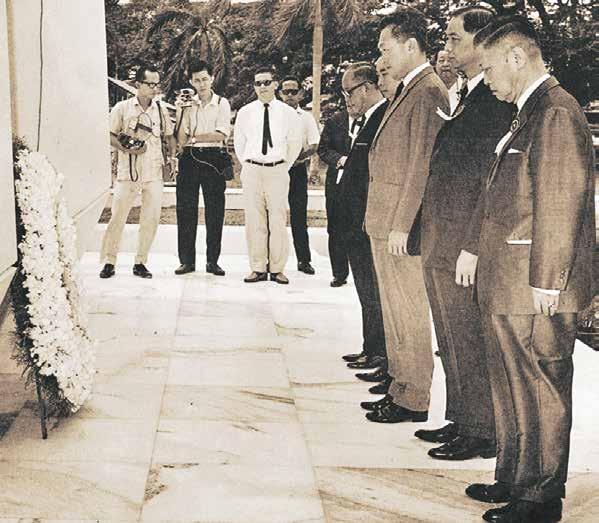
我们在此是要记住那些在战争期间牺牲的无辜受难者。
第 二 章 Glorious Years: Leaving a Mark in History 峥嵘岁月 时代印记 Chapter Two 141 140
在我们眼前的日本占领时期死难人民纪念碑,
见证我们多元文化的密切关系—
新加坡不同种族在二战时期团结和患难与共的精神。
The Civilian War Memorial which stands before us is testament to our multicultural ties—the four tapering columns symbolise the shared experiences and unity among the people of different races in Singapore during the war.

哈莉玛·雅各布总统,2018年
President Halimah Yacob, 2018
第 二 章 Glorious Years: Leaving a Mark in History 峥嵘岁月 时代印记 Chapter Two 143 142
孙中山南洋纪念馆(1996年)
Sun Yat Sen Nanyang Memorial Hall (1966)
晚 晴园落成于1902年,原名明珍庐。1905年 由本地潮商张永福购置这栋双层别墅供
母亲颐养天年,取名为“晚晴园”。当孙中山来到
新加坡宣传革命活动时,张永福征得母亲同意让 给孙中山居住。晚晴园因此成为孙中山在本地筹
划中国三次革命起义的秘密基地,最终更成为南 洋革命总机关。
后来晚晴园几经易手。1937年,本地六位华
商李光前、陈延谦、李振殿、周献瑞、李俊承和
杨吉兆合资购回,向南京国民政府请款修葺后对
Wan Qing Yuan was built in 1902 and its original name was Bin Chan House. In 1905, the Teochew businessman Teo Eng Hock bought the villa as a retirement home for his mother, and renamed it Wan Qing Yuan. When Sun Yat Sen came to Singapore to publicise his revolutionary activities, Teo Eng Hock received support from his mother to let Sun Yat Sen reside in Wan Qing Yuan. Thus, Wan Qing Yuan became Sun Yat Sen’s secret base in Nanyang for the preparation of the three revolutionary activities in China, eventually becoming the headquarters in Nanyang. Subsequently, Wan Qing Yuan has changed ownership several times. In 1937, six Chinese community leaders—Lee Kong Chian, Tan Ean Kiam, Chew Hean Swee, Lee Chin Tian, Lee Choon
Seng and Yeo Kiat Tiow—collectively purchased the estate and requested funds from the Nanjing
government to transform it into a memorial. Wan Qing Yuan was then placed under the care of the Chamber. In 1964, the Chamber revamped Wan Qing Yuan again to commemorate Sun Yat Sen. Two years later, it was renamed the Sun Yat Sen Villa.


外开放,并交由总商会托管。1964年,总商会再度 整修晚晴园,两年后变成“孙逸仙故居”。
第 二 章 Glorious Years: Leaving a Mark in History 峥嵘岁月 时代印记 Chapter Two 145 144
Wan Qing Yuan was gazetted as a National Monument in 1994. Two years later, Wan Qing Yuan was renamed the Sun Yat Sen Nanyang Memorial Hall. The Chamber set up the Sun Yat Sen Nanyang Memorial Hall Co., Ltd. to restore Wan Qing Yuan in 1997 and reopened it to the public in 2001. In 2009, the Chamber collaborated with the National Heritage Board for the Board to take over the management of Wan Qing Yuan to preserve it as a valuable historical heritage building. In 2011, Wan Qing Yuan underwent another phase of restoration. The new exhibition depicts the contributions of the locals in the 1911 Chinese Revolution as well as the formation of the first republic in Asia. It also actively promotes local national education.

晚晴园于1994年被新加坡政府指定为国家古 迹,两年后总商会将晚晴园更名为“孙中山南洋 纪念馆”。1997年,总商会成立孙中山南洋纪念馆 有限公司,修复扩建后晚晴园重新于2001年对外 开放。2009年,总商会进一步与国家文物局合作, 由国家文物局来管理,以保存珍贵的历史遗产。 2011年晚晴园再次完成翻新工程,新展厅以更 全面的视角来叙述本地支持者对中国辛亥革命、
建立第一个亚洲共和国的贡献。晚晴园亦积极 推广本地的国民教育。
时任内阁资政李光耀与时任总商会会长郭令裕于2001年11月12日主持晚晴园——孙中山南洋纪念馆的开幕典礼。
第 二 章 Glorious Years: Leaving a Mark in History 峥嵘岁月 时代印记 Chapter Two 147 146
Lee
Kuan Yew, the then Senior Minister, and Kwek Leng Joo, the then President of the Chamber, officiated the opening of the Sun Yat Sen Nanyang Memorial Hall on 12 November 2001.
INNOVATION

151 150
世界华商大会(1991年)
World Chinese Entrepreneurs Convention (1991)

总 商会于1991年8月首次举办世界华商大会,
该会旨在建立一个全球商业网络平台, 让遍布世界的华商齐聚一堂,加强彼此的商业联
系。世界华商大会为双年会,由各地华商机构轮流 主办,是目前全球华商最具代表性的盛会。
为了确保世界华商大会的延续性,总商会在 新加坡举办第11届大会(2011)时,进一步强化大会
组织结构和定位,设计永久会徽和会旗,以便永续 发展。
世界华商大会已满30周年,如今已茁壮发展
成为一个跨国界、跨领域、规模庞大且具有影响力
的组织,为全球华商提供加强联系的平台、
共同探讨特定主题的场合,也为彼此创造合作的 契机。
The Chamber founded the World Chinese Entrepreneurs Convention (WCEC) in August 1991 to provide overseas Chinese entrepreneurs and business professionals an apolitical networking platform to strengthen economic cooperation and promote mutual understanding. The WCEC is a biennial event hosted by different Chinese Chamber organisations around the world and has become one of the most representative conventions of Chinese entrepreneurs around the world.
The Chamber designed a permanent logo and flag during the 11th WCEC hosted in 2011 by Singapore to ensure the sustainability of the WCEC.
Thirty years after its inception, the WCEC is now recognised as a cross-border, cross-regional,
总商会于1991年8月首次举办世界华商大会,该会旨在建立一个全球商业网络平台,让遍布世界的华商齐聚一堂,加强彼此的商业联系。
The Chamber founded the WCEC in August 1991 to provide overseas Chinese entrepreneurs and business professionals an apolitical networking platform to strengthen economic cooperation and promote mutual understanding.
large-scale and influential communication platform.
world to strengthen their connections and discuss specific themes, laying the foundation for future cooperation. Glorious Years: Leaving a Mark in History 峥嵘岁月 时代印记 Chapter Two
The WCEC also provides a networking platform for Chinese business communities around the 第 二 章
整个世界建立在相互依赖的基础上,贸易、投资和旅行再也 不受海洋、高山或国界的阻碍。如今,新加坡人必须放眼国际。
海外的华人企业家将是在这些国家里很有用的联络人。民族、 文化的情切感能促进联系和信任。海外的华人和其他亚洲人,
特别是印度人,可以协助新加坡人开拓海外市场。
Our world is increasingly interdependent. Trade, investments and travel are no longer impeded by oceans or mountains or national boundaries. Singaporeans now need to go international. Chinese entrepreneurs overseas will be valuable contacts in these countries. Ethnic and cultural empathy facilitates rapport and trust. Chinese and other Asians abroad, especially Indians, can help Singaporeans break into the markets abroad. 时任内阁资政李光耀,1991年
Lee Kuan Yew, then Senior Minister of Singapore, 1991

第 二 章 Glorious Years: Leaving a Mark in History 峥嵘岁月 时代印记 Chapter Two 153 152
The WCEC has been hosted in the following cities:
Vancouver (Canada)
Kuala Lumpur (Malaysia)
Manila (Philippines)
(2005) 首尔(南韩) Seoul (South
(1993) 香港 Hong Kong (2011) 新加坡 Singapore (1999) 墨尔本(澳大利亚) Melbourne
(2017) 仰光(缅甸) Yangon (Myanmar) (2019) 伦敦(英国) London (United Kingdom) (2007) 神户 & 大阪(日本) Kobe
(1995) 曼谷(泰国) Bangkok (Thailand) (2013) 成都(中国) Chengdu (China) (2001) 南京(中国)
历届世界华商大会举办地:
Korea)
(Australia)
& Osaka (Japan)
Nanjing (China)
(2003) 吉隆玻(马来西亚)
(1991) 新加坡 Singapore (2009) 马尼拉(菲律宾)
(1997) 温哥华(加拿大)
(2015) 峇厘岛(印尼)
1 4 13 2 5 14 3 6 7 8 9 10 11 12 15 第 二 章 Glorious Years: Leaving a Mark in History 峥嵘岁月 时代印记 Chapter Two 155 154
Bali (Indonesia)
Abolishing the Clan-Based Election System (1993)
孙炳炎成立“修改章程小组”,却因部份条文无法
达成协议而搁置。
1993年,总商会在郭令裕会长的带领下完成修
由不同帮人选轮流担任,避免特定帮群长期垄断 商会领导层的局面。
过去总商会曾多次检讨分帮选举制的利弊。
早在1920年代,陈嘉庚曾在《南洋商报》发表他
对帮群制的改革期许。1939年,第22届会长李光前
提出修章废除分帮选举的规定,因部分董事反
对而作罢。1950年代,不少董事和会员都提出废除
分帮选举的制度,但始终无法达成共识。废除帮
群论争在1965年至1968年间进入高峰,时任会长
章,终结这一场超过半个世纪的争论。至此,总商会
沿用了87年之久的分帮选制度正式走入历史。此
前,总商会的董事习惯使用各自的方言交流,取
消分帮制度后,大家打破祖籍的划分,统一使用
华文华语,增强总商会的凝聚力,共同因应时代
变化。
总商会适时废除不符合潮流的陈规,说明它的 进取性格和求变精神,积极将组织打造成现代化、
高效率和专业化的机构。
When the Chamber was established, the Council adopted a clan-based election system to ensure that the five dialect groups are represented proportionally in the Committee. Representatives from different dialect groups took turns to hold the post of President, preventing the monopolisation of leadership by any specific dialect group. Over the years, the Chamber repeatedly reviewed the pros and cons of this clan-based election. In the early 1920s, Tan Kah Kee voiced his reservations against the clan-based election in a Nanyang Siang Pau article. In 1939, Lee Kong Chian, the 22nd President of the Chamber, suggested amending the Chamber’s Rules to abolish the clan-based election. However, this was met with objections from several Council Members. In the 1950s, many Council Members resurrected the idea of abolishing the clan-based system but to little effect. The debate intensified between 1965 and 1968. Soon Peng Yam, the then President of the Chamber, headed the Special Review Committee but still failed to reach a consensus.
In 1993, under the leadership of President Kwek Leng Joo, the Chamber amended the Rules and settled the debate after more than half a century. Finally, the 87-year chapter of the clan-based election system was relegated to the Chamber’s history. The Council Members used to communicate in their dialects, but after the clan-based election was abolished, they prescribed the use of Mandarin to break away from clan divisions, fostering stronger ties among the Council Members and changing with times.
The Chamber abolished a system that did not fit the zeitgeist, highlighting that the Chamber is highly motivated to seek and adapt to new changes. This helped the Chamber to transform into a modern, efficient and professional organisation.
1993年,总商会召开特别会员大会,废除帮选举制度。
In 1993, the Chamber held an Extraordinary General Meeting to abolish the clan-based election system.

修章废除分帮选举制度(1993年)
总
商会成立时,董事会采取分帮(方言群) 选举制度,按照帮群人数来分配比例代表,
以确保五大帮群都有代表进入董事会。每届会长
第 二 章 Glorious Years: Leaving a Mark in History 峥嵘岁月 时代印记 Chapter Two 157 156
Kwek Leng Joo

总商会时任会长,1993年
Then President of the Chamber, 1993
No matter which dialect group you come from, we are all Singaporean Chinese! In putting aside minor differences to seek a common ground, racial unity becomes the mission of our generation.
无论你是来自华社的哪一个族群,我们都是 新加坡华人! 求同存异、民族团结是我们 这一代人的历史使命。
郭令裕
第 二 章 Glorious Years: Leaving a Mark in History 峥嵘岁月 时代印记 Chapter Two 159 158
161 160
新加坡中华总商会事业女性组 (1994年)
The SCCCI Career Women’s Group (1994)
1994年7月,在时任总商会会长郭令裕的领导下, 责成张齐娥成立“新加坡中华总商会事业 女性组”。次年,张齐娥与颜诗琴博士双双当选为
总商会第48届董事,打破总商会一贯以男性出任 董事的局面,为总商会注入清新气息。
女性组成立以来,举办各类经贸及社交活动, 并组织代表团与其他国外妇女团体及机构交流,
促进跨国企业合作。自2004年开始,“事业女性组”
亦以联谊晚会形式每年为会员举办国际三八妇女 节庆祝活动。
“事业女性组”的成立,提供本地职业女性一个
相互交流与学习的新平台,同时也广纳具有影响
In July 1994, under the leadership of Kwek Leng Joo, Claire Chiang set up the SCCCI Career Women’s Group. In the subsequent year, Claire Chiang and Gan See Khem were voted into the 48th Council, breaking the long-standing tradition of a male-exclusive Council and injecting new talents into the Council.
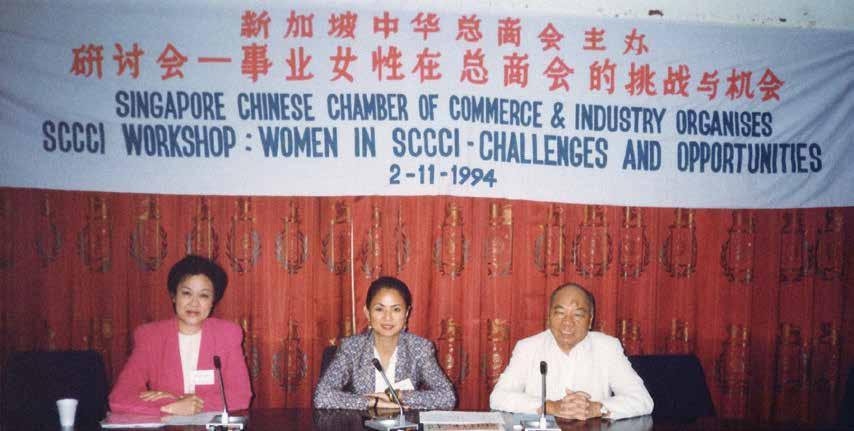
Since its establishment, the SCCCI Career Women’s Group has constantly organised various economic, trade and social activities. It has also organised small delegation groups to interact with women representatives from overseas groups and institutions to strengthen cooperation with multinational corporations. Since 2004, the SCCCI Career Women’s Group has been organising
The Chamber organised a workshop to analyse the challenges and opportunities women in the Chamber faced in 1994.
International Women’s Day networking conferences for its members.
and communicate. Meanwhile, it also congregates influential and successful career women to play a part in giving back to society and contribute to the development of the country. Glorious Years: Leaving a Mark in History 峥嵘岁月 时代印记 Chapter Two
力的成功女性,共同参与公益、回馈社会,为国家 的发展作出贡献。 总商会于1994年主办研讨会探讨事业女性在总商会的挑战与机会。
The SCCCI Career Women’s Group creates a new networking platform for career women to learn 第 二 章
总商会于2019年庆祝国际妇女节暨新加坡中华总商会事业女性组25周年。
The Chamber celebrated International Women’s Day and the 25th anniversary of the SCCCI Career Women’s Group in 2019.

第 二 章 Glorious Years: Leaving a Mark in History 峥嵘岁月 时代印记 Chapter Two 163 162
165 164
新加坡中华总商会管理学院(1996年)
The Singapore Chinese Chamber Institute of Business (1996)
首设微型电脑中心,为会员提供电脑课程。
为 了因应电脑时代的来临,总商会于1981年
1984年,总商会进一步配合政府的人力政策,
成立培训中心推广现代科技的应用,协助 会员及企业提高生产力与管理技能。中心成立 第一年,就有超过3,000人前来接受语言、工商 管理及电脑系统的培训课程。
1996年,总商会将培训中心升格为管理学院, 作为一所专业的教育机构。管理学院配合商界的
需求,在管理培训、语言文化、技能提升等三大
领域推出新课程,透过丰富的内容,协助企业提升 员工的素质、技能及生产力。同时,管理学院也
倡导中华文化的传承。2018年,管理学院获中国 孔子学院总部暨国家汉办委任,成为新加坡唯一 的商务汉语考试中心。
此外,总商会管理学院亦与政府合作开发一系
With the advent of the digital age, the Chamber established the Micro Computer Centre in 1981 to equip its members with computer skills. In 1984, the Chamber further cooperated with the government’s labour policies and founded the Singapore Chinese Chamber Training Centre to assist members and enterprises in increasing their productivity and improving their business management skills. In the first year of the centre’s founding, more than 3,000 people received language, business management and computer skills upgrading courses.
in three areas: business management, language and culture, and skills upgrading. Through its various diversified and quality courses, the SCCIOB continuously assists local businesses to upgrade the skills of the employees, improve productivity and promote the Chinese cultural legacy. In 2018, the Hanban/Confucius Institute Headquarters appointed the SCCIOB as the sole Business Chinese Test (BCT) Centre in Singapore. The SCCIOB also collaborated with the government to launch a series of courses for skills upgrading. These courses equip entrepreneurs and senior management personnel with business management and digitalisation skills, improve work processes as well as enhance the overall expertise of individual businesspeople and the business community. Glorious Years: Leaving a Mark in History 峥嵘岁月 时代印记 Chapter Two
列技能提升课程,协助企业家及企业管理人面对
经济转型、提升经营理念、掌握现代科技、改善 工作流程,进而提高个人及商界整体的素质。
In 1996, the Chamber upgraded its training centre to the Singapore Chinese Chamber Institute of Business (SCCIOB). As a professional educational organisation, it adapts to the needs of the business community and continuously launches new courses 第 二 章
1996年,新加坡中华总商会管理学院启用仪式。
The Chamber launched the Singapore Chinese Chamber Institute of Business in 1996.


Ng Cher Pong, the then Chief Executive of SkillsFuture (second from the left), and Roland Ng, the President of the Chamber (third from the right), at the opening of the Business Chinese Test Centre in 2018.
2016年,时任教育部代部长(高等教育及 技能)兼国防部高级政务部长王乙康参观 新加坡中华总商会管理学院。
Ong Ye Kung, the then Acting Minister for Education (Higher Education and Skills) and Senior Minister of State for Defence, Ministry of Defence, visited the Singapore Chinese Chamber Institute of Business in 2016.
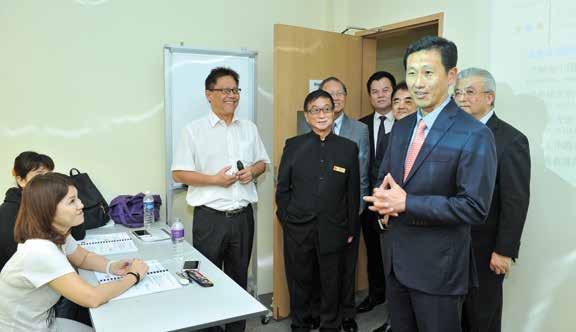
时任 精深技能发展局局长黄子鹏(左二) 和黄山忠会长(右三)于2018年为商务汉语 考试中心主持开幕。
第 二 章 Glorious Years: Leaving a Mark in History 峥嵘岁月 时代印记 Chapter Two 167 166
CHAPTER THREE

第三章
丹戎巴葛(1890年代)
(the
Tanjong Pagar
1890s)
华商精神 薪火相传 Passing on the Chinese Entrepreneurial Spirit Legacy
保存出一份力;迈入21世纪,总商会先后成立通
商中国,在中国设立上海代表处、新加坡进口馆, 促进新中经贸关系。
总商会在过去20年也先后举办百年庆典、建国
50、110周年庆等活动。本章再以60届董事会为
分界点,说明总商会准备迈入下一新篇章。 ❖
新加坡和中国辛亥革命的历史,也为国家古迹
This chapter records the major Chinese and English news events of the Chamber in the past 20 years.
Through these media reports, the reader can draw, from both the headlines and content, the close relationship between Singapore’s development and the Chamber’s growth.
For example, in the 1990s, the Chamber renovated Wan Qing Yuan, connecting the history of Singapore and the 1911 Revolution in China. In doing so, it played a part in contributing to the preservation of a National
Monument in Singapore. In the 21st century, the Chamber has successively established Business China, the Shanghai Representative Office and the Singapore Import Pavilion in China, which are focused on promoting Singapore-China economic relations.
In the past 20 years, the Chamber also organised various celebrations to mark its centennial, SG50, and its 110th anniversary. This chapter uses the 60th Council as the dividing line, showing the Chamber’s readiness in entering a new chapter. ❖
本 章选录本地中英文报章有关总商会近20年 来重大新闻报道。新闻媒体记录了重要 社会事件,读者可以从新闻的标题和内容捕抓到 时代的足迹,这些报道正好说明了总商会和新加坡 的国家发展息息相关。 例如,1990年代总商会重新整修晚晴园,连接起
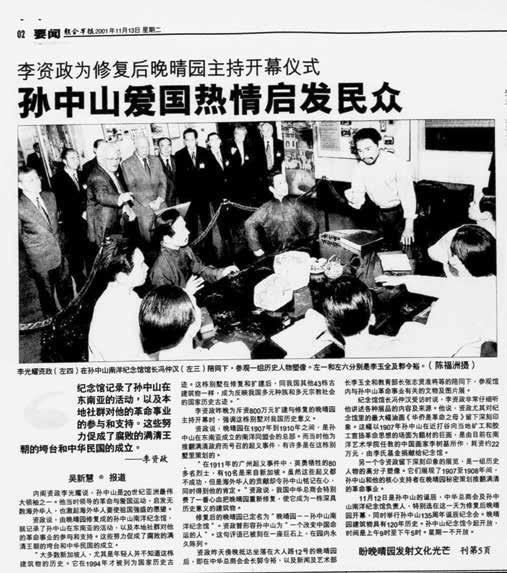




投资 万元 扩建与修复的晚晴园 年历史 纪念馆的建立, 是新加坡历史演变 的自然结果,它和 一个新加坡的 产生息息相关。 由晚晴园修复成 的孙中山纪念馆, 记录了孙中山在 东南亚的活动,以及 本地社群对他的 革命事业的参与和 支持。这些努力促 成了腐败的满清王 朝的垮台和中华民 国的成立。 第 三 章 Passing
Spirit Legacy 华商精神 薪火相传 Chapter Three 173 172 2 0 0 1 2 0 0 1
on the Chinese Entrepreneurial
The restored and expanded Sun Yat Sen Villa in Balestier Road now joins 43 other national monuments, which reflect Singapore’s multi-racial and multicultural society.








第 三 章
华商精神 薪火相传 Chapter Three 175 174 2 0 0 6 2 0 0 1
Passing on the Chinese Entrepreneurial Spirit Legacy
Mr Lee expressed confidence that ‘the same indomitable and pioneering spirit’ will see the Chamber through the next century.

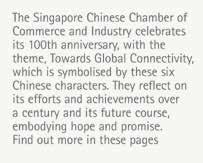


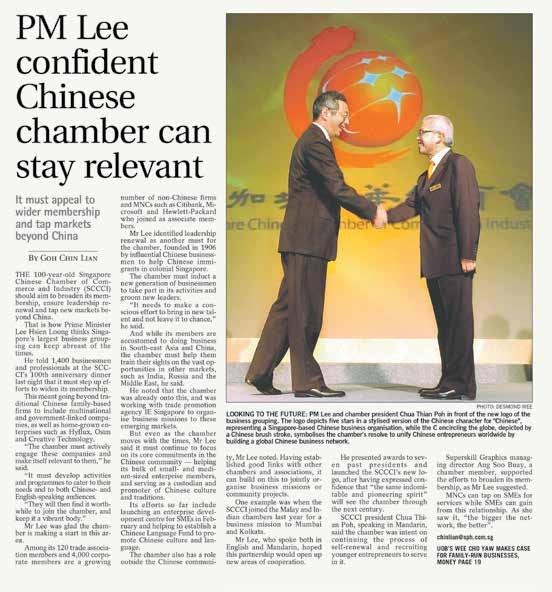
120 trade associations and
4,000 businesses and professionals as members
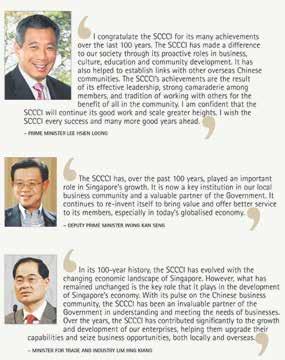
第 三 章 Passing on the Chinese Entrepreneurial Spirit Legacy 华商精神 薪火相传 Chapter Three 177 176 2 0 0 6 2 0 0 6
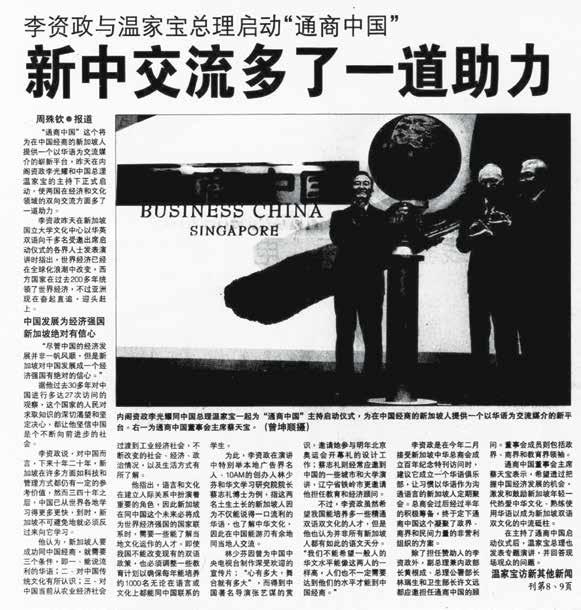









李资政与温家宝 总理启动 ‘通商中国’ , 新中在经济 和文化的双向 交流多了一道 助力。 第 三 章 Passing
华商精神 薪火相传 Chapter Three 179 178 2 0 0 7 2 0 0 7
on the Chinese Entrepreneurial Spirit Legacy
The new office in Shanghai will play matchmaker to Chinese and Singapore companies keen to invest in the other’s country and acting as a catalyst for joint venture projects.









为了协助本地企业 到中国发展, 总商会在上海设立 代表处,建立会员商家
在中国的交流站。
第 三 章 Passing on the Chinese Entrepreneurial Spirit Legacy 华商精神 薪火相传 Chapter Three 181 180 2 0 1 0 2 0 1 0



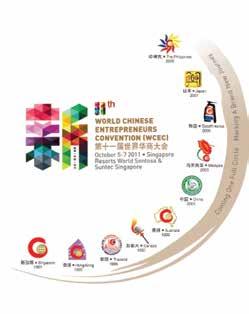


第 三 章 Passing on the
华商精神 薪火相传 Chapter Three 183 182 2 0 1 1 2 0 1 1
Chinese Entrepreneurial Spirit Legacy



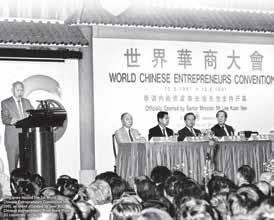



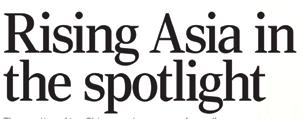

第 三 章 Passing on the
华商精神 薪火相传 Chapter Three 185 184 2 0 1 1 2 0 1 1
Chinese Entrepreneurial Spirit Legacy





现总商会自建国酝酿以来
总商会举办这两大活动, 是为了表彰与肯定建国 华商用于开拓的魄力与 崇高的奉献精神,以及呈
所扮演的角色。
第 三 章 Passing on the Chinese Entrepreneurial Spirit Legacy 华商精神 薪火相传 Chapter Three 187 186 2 0 1 5 2 0 1 5
总商会以华商精神为出发点, 目的是希望通过这种方式,让精诚团结、 不畏逆境的新加坡精神代代相传。
The winners were a representation of the larger Singapore Chinese business community that had contributed to Singapore’s development.




第 三 章 Passing on the Chinese Entrepreneurial Spirit Legacy 华商精神 薪火相传 Chapter Three 189 188 2 0 1 5 2 0 1 5
Singapore’s future is the future of the Chamber.




第 三 章 Passing on the Chinese Entrepreneurial Spirit Legacy 华商精神 薪火相传 Chapter Three 191 190 2 0 1 5 2 0 1 5
The Chamber is committed to grooming the younger generation, passing on the Chinese Entrepreneurial Spirit.




作出贡献。 第 三 章 Passing on the Chinese Entrepreneurial Spirit Legacy 华商精神 薪火相传 Chapter Three 193 192 2 0 1 6 2 0 1 6
总商会继续与时并进, 聚商惠民,推陈出新为 华商、华社服务,同时 积极回馈社会,为促进
国家发展和社会和谐
By Yuen Sin yuensin@sph.com.sg
Singapore
MORE than 20 trade associations are set to collaborate more closely in the national push to grow companies and help them venture overseas, with the launch of the new Trade Association
Hub in Jurong on Wednesday morning.
The refurbished space, which was officially opened by Prime Minister Lee Hsien Loong, contains shared facilities that associations can use to reduce operating costs, including meeting and training areas available on a pay-per-use basis.

At the opening ceremony, PM Lee said that the hub is “not just brick and mortar space”. “It will also help build stronger TAC (Trade Association and Chambers) community, and cultivate a culture of mutual support and collaboration,” he said. The 25 tenants that moved in earlier this year include anchor tenant Singapore Chinese Chamber of Commerce and Industry (SCCCI), the Singapore Food Manufacturers’ Association (SFMA) and Kranji Countryside Association (KCA). The hub was mooted by the SCCCI in 2014.
Thomas Pek, president of SFMA, said that moving operations from their headquarters in Chinatown to the TA Hub in Jurong has helped the
association – which has more than 400 members including brands such as Bee Cheng Hiang to source for new technological solutions.
For example, it was able to partner another tenant at the hub, the Landscape Industry Association (Singapore), to sign a Memorandum of Understanding two months ago with the Waste Management and Recycling Association of Singapore. They will explore how they can share technologies for converting waste into compost and recycling by-products. “We also hope to look for new overseas markets or business partners when the TA Hub hosts trade exhibitions or foreign visitors,” Mr Pek said.
In his speech, PM Lee underlined the important role that the more than 300 TACs in Singapore play. They are “aggregators and multipliers” in the business eco-system, he said. “You are close to the companies, and understand the needs of your industries well. You support small and medium enterprises to overcome the limitations of size by working together, and doing things that would otherwise be difficult for a single company to do alone.”
He added that he hoped to see TACs work together to help Singapore companies venture overseas, and expand their global footprint.
The TA Hub occupies the premises of the 43-year-old Jurong

Town Hall building, which was gazetted as national monument in 2015.
It was formerly the headquarters of the Jurong Town Corporation, and was renamed the iHUB in 2004, serving as an office space for local technology startup companies.
Restoration works in the Jurong Town Hall building started in early 2016 and were completed early this year. The building, which has six levels, has 7,500 sq m of space for trade association offices and almost 5,000 sq m of shared facilities. About half of the space for offices has been occupied, with rental rates at S$32
per sq m. Besides the new hub, the SCCCI will also lead a Trade Association Committee, which includes members from 12 other trade associations and chambers.



It hopes to drive the development of TACs so that they can better work with their members to address industry challenges.
By Annabeth Leow leowhma@sph.com.sg
@AnnabethLeowBT
Singapore
THERE’S no need for MyRepublic to ask who’s on the other end of the line this time: The telecommunications company has picked up a lead investor in its latest funding round.
The injection of S$70 million from financial services firm Makara Capital, announced on Wednesday, will “push the gas” on the telco’s business growth plans, says its chief executive Malcolm Rodrigues also gave an update on the company’s planned consumer mobile services roll-out and public listing.
Makara Capital chief executive and co-founder Ali Ijaz Ahmad told media briefing that his firm was tak-
ing “a substantial stake” in MyRepublic and has not ruled out chipping in again if the investment pans out well.
Makara’s director of investments Kelvin Tan said in a statement that the capital will have “a focus on (intellectual property) management and monetisation, scaling and expansion”.
MyRepublic had kicked off its Series C fund-raising round earlier this year, with an original target of S$100 million, but Mr Rodrigues said that he will now set his sights higher.
The fund-raising could yield “at least S$150 million”, he noted. “It looks like we’ll be fortunate enough to go beyond the S$100 million in terms of the money that we can tap into, and we’ll use that to accelerate our business.”
Mr Rodrigues said that the cash
from the billion-dollar Makara Innovation Fund will “effectively triple the business over the next few years and drive the valuation further”.
“The use of proceeds fundamentally is around growing our consumer business, growing our enterprise business in our four markets, and as well investing in the platform to drive the capability for our growth.”
MyRepublic now operates in Singapore, Indonesia, New Zealand and Australia; it also wants to grow in South-east Asia, and hopes to expand into markets like Myanmar, Thailand, Vietnam and the Philippines.
Mr Rodrigues also said the move would “supercharge” the development of the company’s proprietary cloud platform, which he credited with enabling growth in new markets.
Separately, the “telcotech” player
confirmed that it is eyeing the first quarter of next year for a roll-out of consumer mobile services here, by way of a deal with telecom incumbent.

Last year, MyRepublic lost out to Australia’s TPG Telecom in the contest to be Singapore’s fourth telco. The upcoming launch of its consumer mobile services will be through a mobile virtual network operator (MVNO) tie-up with local telco, which it declined to name at this stage.
The MVNO model entails leasing another company’s capacity like how service provider Circles.Life has partnered M1.
Mr Rodrigues reiterated that MyRepublic is on track to list in the next 18 months: “With Makara taking the lead, with some follow-up investors, we expect to be oversubscribed.”
“We expect that the autonomous vehicles will greatly enhance the accessibility and connectivity of our public transport system, particularly for the elderly, families with young children, and the less mobile. More the development of the technology, but how we can safely incorporate it into our living environment, through appropriate regulations and town planning.” He said autonomous vehicle (AV) The test centre was jointly developed by NTU, LTA and JTC, as part of the Centre of Excellence for Testing & Research of AVs NTU (Cetran), which was launched in August 2016. Mr Khaw said it would provide a
tops
S$70m
Driverless buses to be tested in 3 new towns from 2022 MyRepublic says it will go into a mobile virtual network operator tie-up with a local telco to launch its consumer mobile services. It declined to name its local telco partner for now. BT FILE PHOTO The new Trade Association Hub was officially opened by Prime Minister Lee Hsien Loong on Wednesday morning. It contains shared facilities that associations can use to reduce operating costs. BT PHOTO: KELVIN CHNG They will run in Punggol, Tengah and the Jurong Innovation District during off-peak hours 2 | TOPSTORIES TheBusinessTimes|Thursday,November23,2017
the
closely in the national push to
companies and
firms of different sizes The Chamber represents 第 三 章 Passing on the Chinese Entrepreneurial Spirit Legacy 华商精神 薪火相传 Chapter Three 197 196 2 0 1 7 2 0 1 7
MyRepublic
up
war chest; sets Q1 2018 for mobile launch
With
launch
of the
new Trade Association (TA) Hub, more than 20 trade associations
are
set
to collaborate more
grow
help them venture overseas. 40,000
管好我们的家族和企业,才能国际化、闯天下。
The Chinese Entrepreneurs

Cultural Fund aims to promote the ‘Chinese Entrepreneurial Spirit’.




要修身、齐家,一定要从华商精神做起,做好我们的本分,
2 0 1 9 2 0 1 9 第 三 章 Passing on the Chinese Entrepreneurial Spirit Legacy 华商精神 薪火相传 Chapter Three 199 198
总商会经过一个世纪后作出改革董事




任期的决策,是为了让总商会的决策规划 和长远发展更有延续性和稳定性。

2 0 1 9 2 0 1 9 第 三 章
华商精神 薪火相传 Chapter Three 201 200
Passing on the Chinese Entrepreneurial Spirit Legacy




总商会协助新加坡 商家把握最有经济效益 的线上与线下推广方式, 通过设立在上海、成都 与重庆的三个办事处为 新加坡品牌提供一站式 的服务,以便协助新加坡 品牌抓紧中国市场蓬勃 发展的机遇,扬名海外。 2 0 2 1 2 0 2 1 第 三 章 Passing on the Chinese Entrepreneurial Spirit Legacy 华商精神 薪火相传 Chapter Three 203 202
The Chamber launched its 36-page ebook, The Story of the Civilian War Memorial , containing brief information on how the memorial was erected and some stories of the war.

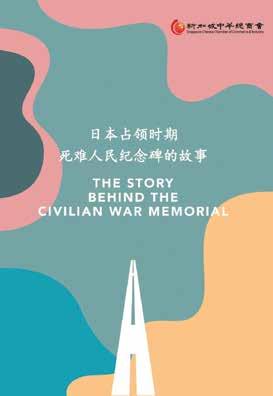




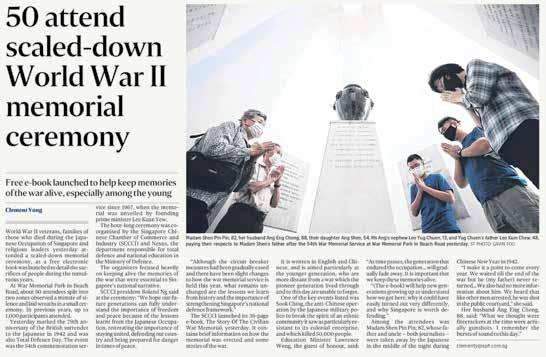
2 0 2 1 2 0 2 1 第 三 章 Passing on the Chinese Entrepreneurial Spirit Legacy 华商精神 薪火相传 Chapter Three 205 204
Singapore River (1900)

结语
CONCLUSION 新加坡河景(1900年)
发挥诚信、效忠、回馈和创新的华商
过 去百余年来,总商会始终秉持创会宗旨,
精神,对新加坡的政治、经济、社会和文化的发展
作出贡献,产生社会影响力,持续至今。
本书以�华商精神 生生不息” 为主题,带领读者
认识总商会创会以来的会长。历届会长如何身体力行
华商精神的信念,与董事会一起来协助会员商家
克服不同时代的困难与挑战。
本书也以总商会重大事件和新闻剪报方式,让
读者进一步了解总商会华商精神故事。每一个
华商精神故事,可以让年轻的国人明白华商先贤
走过的路。 未来,新一代的新加坡华商,可以在总商会华商
精神的根基上,承前启后,以更坚定的信心勇往
直前,为国家的永续发展和社会进步与繁华奉献
心力。 ❖
Over the past hundred years, the Chamber has always adhered to its mission and upheld the Chinese Entrepreneurial Spirit, namely Integrity, Loyalty, Giving back to society, and Innovation. The Chamber has played an important role in the political, economic, societal and cultural arena and has gained social influence that continues to this day.
Through the theme of “the Unwavering Force of the Chinese Entrepreneurial Spirit”, this publication enables readers to learn about the Chamber’s Presidents since its establishment. It also allows the readers to understand ways the Presidents and Council Members have upheld the Chinese Entrepreneurial Spirit while helping the members to overcome the challenges of the different times.
The structure of this publication is based on the Chamber’s major events and newspaper clippings, to allow readers to understand the story of the Chamber Chinese Entrepreneurial Spirit. Each story of the Chinese Entrepreneurial Spirit allows the younger generation to understand the road that our forefathers have been through.
In the future, by building on the Chamber Chinese Entrepreneurial Spirit, a new generation of Singaporean Chinese businessmen will be able to forge ahead with stronger confidence and contribute to the sustainable development, social progress and prosperity of the country. ❖
结语
Conclusion
THE 60 TH SCCCI COUNCIL

第六十届董事会
岌巴港(1900年代) Keppel Harbour (the 1900s)

2019年,新加坡中华总商会第60届董事合影。
A group photograph of the Chamber's 60 th council in 2019.
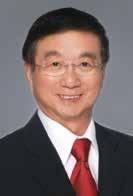




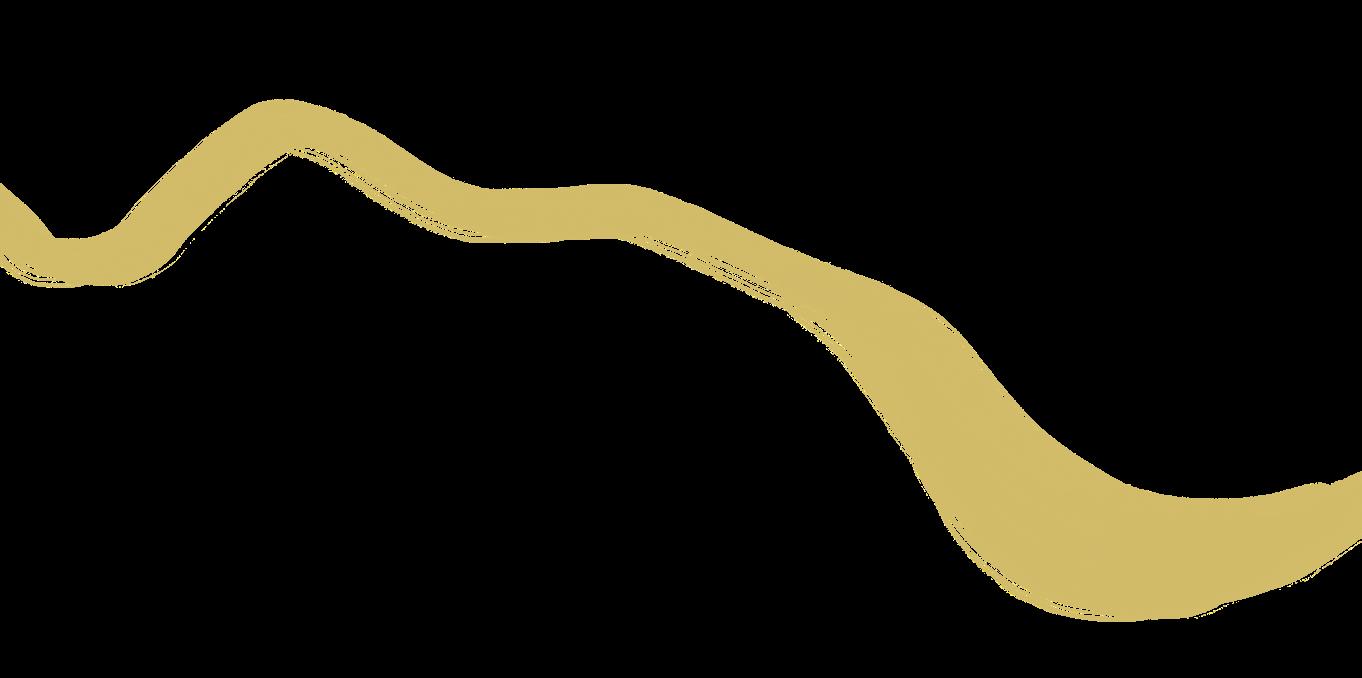 President Roland Ng San Tiong
President Roland Ng San Tiong
副会长 柯文伟 Vice-President
副会长 白连源 Vice-President
副会长 何乃全 Vice-President
第六十届董事会 THE 60 TH SCCCI COUNCIL 2019年3月15日至2022年3月15日 15 MARCH 2019 TO 15 MARCH 2022 The 60 th SCCCI Council 215
Immediate Past President Thomas Chua Kee Seng
Kuah Boon Wee
Pek Lian Guan
Charles Ho Nai Chuen
The 60 th SCCCI Council 第六十届董事会 217 216
总务委员会主席 白毅柏
Chairman, General Affairs Committee
Pek Ee Perh Thomas
财政委员会主席 吴绍均
Chairman, Finance Committee
Ng Siew Quan
文教与社会事务委员会主席 白南泉
Chairman, Culture Education & Community Affairs Committee
Adrian Peh Nam Chuan







商团与会员事务委员会主席 陈睦发
Chairman, Trade Association & Membership Affairs Committee
Tan Bock Huat
工商业委员会主席 李坚辉
Chairman, Commerce & Industry Committee
Mark Lee Kean Phi
产业委员会主席 高泉庆
Chairman, Property Management Committee
青年商务委员会主席 郭益智
Chairman, Youth Business Affairs Committee
总务委员会副主席 吕立岩
Vice-Chairman, General Affairs Committee
研究与出版委员会主席
谢锦发
Chairman, Research & Publications Committee
Chia Kim Huat

外事委员会主席
陈康威
Chairman, External Relations Committee
Anthony Tan Kang Uei




科技委员会主席
黄建铭
Chairman, Technology Committee
Ang Kiam Meng
国际事务委员会主席
翁温钊
Chairman, International Affairs Committee
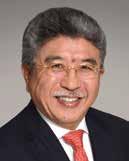
Edward Ang Boon Cheow
Vice-Chairman Finance Committee
Ang Fung Fung
Kho Choon Keng
Sherman Kwek Eik Tse
Paul Loo Lip Giam 财政委员会副主席
文教与社会事务委员会副主席
Vice-Chairman, Culture, Education & Community Affairs Committee
Hwang Yee Cheau


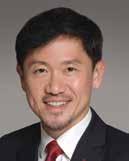
商团与会员事务委员会副主席
Vice-Chairman Culture, Education & Community Affairs Committee
Vice-Chairman, Trade Association & Membership Affairs Committee
洪芳芳
黄亦巧
文教与社会事务委员会副主席 邬春玲
Voo Choon Ling 胡进胜
James Ow Chin Seng
商团与会员事务委员会副主席 陈树生
Vice-Chairman, Trade Association & Membership Affairs Committee
Simon Goh Lian Seah
商团与会员事务委员会副主席
Vice-Chairman, Trade Association & Membership Affairs Committee
Allan Tan Soo Seng







研究与出版委员会副主席
Vice-Chairman, Trade Association & Membership Affairs Committee
Lim Chin Keong





Vice-Chairman, Research & Publication Committee
Zhou Zhao Cheng



Vice-Chairman, International Affairs Committee
Keith Tan Keng Soon
Vice-Chairman, Commerce & Industry Committee
Philip Kia Er Chew
Vice-Chairman, Commerce & Industry Committee
Tew Koon Huat
Vice-Chairman, Property Management Committee
Chia Chor Meng
外事委员会副主席 陈俊文
Vice-Chairman, External Relations Committee
Tan Choon Boon
科技委员会副主席 颜毓瑩
Vice-Chairperson, Technology Committee
Annie Gan Giok Em
国际事务委员会副主席
梁善权
Vice-Chairman, International Affairs Committee
Chris Leong Sin Kuen
国际事务委员会副主席
黄保华
Vice-Chairman, International Affairs Committee
Ng Poh Wah
Vice-Chairman, Youth Business Affairs Committee
Wong Chee Herng
Vice-Chairman, Youth Business Affairs Committee
Ken Koh Kien Chon

Council Member
Wu Hsioh
Council Member
Zhong Sheng Jian
国际事务委员会副主席 陈庆顺
工商业委员会副主席 程宇超
工商业委员会副主席 张群发
产业委员会副主席 谢楚明
青年商务委员会副主席 黄志恒
青年商务委员会副主席 辜健聪
董事 吴学光
Kwang 董事 钟声坚
商团与会员事务委员会副主席 吴令声
林振强
周兆呈
The 60 th SCCCI Council 第六十届董事会 219 218
Council Member
Tay Khiam Back
Council Member
Lee Sze Leong
Council Member Patrick Ng
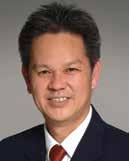

Council Member Chan Hian Siang

Council Member Lim Geok Khoon

Council Member
Yeo Hiang Meng
Council Member Ted Ngo Soo Lin


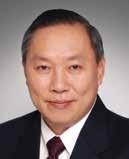


Council Member Tan Aik Hock

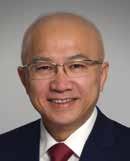
Council Member
John Lim Hwee Chiang
Council Member
Lim Hock Chee

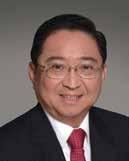
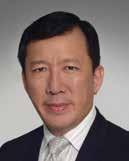
Council Member Pang Lim


Council Member
Francis Ko Oon Joo
Council Member
Ernie Koh Jyh Eng
Council Member
Michael Lim Ah Poh
Council Member
Ong Chu Poh
Council Member
Koh Wee Seng
董事 郑谦木
董事 李思亮
董事 黄健华
董事 曾憲相
董事 林惠璋
董事 林福星
董事 庞琳
董事 高允裕
董事 林玉勤
董事 杨向明
董事 吴斯仁
董事 陈奕福
董事
许志恩
董事 林亚保
董事
王再保
董事 许伟盛
The 60 th SCCCI Council 第六十届董事会 221 220



董事 林日耀 Council Member Jeremy Lim Jit Yaw 董事 石慧宁 Council Member Michelle Cheo Hui Ning 第六十届董事会 222
THE 61 ST SCCCI COUNCIL

PRESIDENT, IMMEDIATE PAST PRESIDENT, AND VICE-PRESIDENTS
2022年3月15日至2025年3月15日

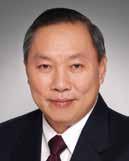


15 MARCH 2022 TO 15 MARCH 2025

President Kho
Roland
副会长 李思亮 Vice-President Lee Sze Leong 副会长 林福星 Vice-President Lim Hock Chee 常务副会长 吴绍均 First Vice-President Ng Siew Quan
Choon Keng Immediate Past President
Ng San Tiong
第六十一届董事会 会长、前任会长、副会长
225 The 61 st SCCCI Council
华商精神 生生不息
THE UNWAVERING FORCE OF CHINESE ENTREPRENEURIAL SPIRIT

新加坡河哥烈码头(1902年)
致谢
View Of Collyer Quay (1902)
ACKNOWLEDGEMENTS
新加坡中华总商会华商文化基金衷心感谢以下机构的支持、 相关人士的文物捐赠及图像使用权:
新加坡中华总商会华商文化基金董事会
The SCCCI Chinese Entrepreneurial Culture Foundation would like to express its appreciation to the following organisations and individuals for their support in the production of this publication:
SCCCI Chinese Entrepreneurial Culture Foundation Board


主席 Chairman 黄山忠 Roland Ng San Tiong
新加坡国家档案馆
National Archives of Singapore
新加坡报业控股
Singapore Press Holdings Limited
杨修灏家属 Family of Yong Siew Hong
Chui Choon Sin
委员 Members 蔡其生 Thomas Chua Kee Seng
吴学光 Wu Hsioh Kwang
白南泉 Adrian Peh Nam Chuan
刘泰山 Lau Tai San
白连源 Pek Lian Guan
吴绍均 Ng Siew Quan
高泉庆
Kho Choon Keng
徐祖燊
Acknowledgements 致谢 231 230
总商会大厦装修小组 Building Renovation Advisory Panel
华商精神 生生不息——
新加坡中华总商会百年华章
顾问 Advisor
主席 Chairman
委员 Members
黄山忠 Roland Ng San Tiong
林惠璋 John Lim Hwee Chiang
高泉庆 Kho Choon Keng
李思亮 Lee Sze Leong
何培斌教授 Professor Ho Puay Peng
张东孝 Daniel Teo Tong How
杨茳善副教授 Associate Professor Yeo Kang Shua
THE UNWAVERING FORCE OF CHINESE ENTREPRENEURIAL SPIRIT—
A CENTENNIAL HISTORY OF THE SINGAPORE CHINESE CHAMBER OF COMMERCE & INDUSTRY
出版 Publisher
新加坡中华总商会华商文化基金
SCCCI Chinese Entrepreneurial Culture Foundation 47 Hill Street, SCCCI Building Singapore 179635
出版统筹 Publication Coordinators
主编 Chief Editor
助理编辑 Assistant Editors
国际书号 ISBN
吕正扬 Lu Cheng Yang
陈星伊 Chin SinYee
陈丁辉博士 Dr Tan Teng Phee
蔡佩雯 Chua Pei Wen
978-981-18-3609-1
庄蕙瑛 Serene Chng Hui Ying
Acknowledgements 致谢 233 232
出版机构
Published by
版权所有,侵权必究。未经新加坡中华总商会许可,不得以任何形式 (电子、 机械、影印、录制或其他方式)复制、存储及传送刊物的任何内容。


All Rights Reserved. No part of this publication may be reproduced, stored in a retrieval system, or transmitted in any form by any means, electronic, mechanical, photocopying, recording or otherwise, without the prior permission of Singapore Chinese Chamber of Commerce & Industry. 所属机构 Owned by
谨以此书献给所有为这一片土地奋斗、奉献的华商们︕
This book is dedicated to all the Chinese entrepreneurs who contributed earnestly to Singapore!
THE UNWAVERING FORCE OF CHINESE ENTREPRENEURIAL SPIRIT A
Centennial History of the Singapore Chinese Chamber of Commerce & Industry
苍黎命脉 继往开来
百年华商 积厚流光
积厚流光
陈志锐 博士
捍卫小权益 取信大社稷
为民复请命 诚信可振邦
响应维新 改革教育
作育栋梁 造福南洋
Reservoir of Light
People inherit the light of before
Chinese businessmen accumulate a century of light for after
Safeguarding our smallest rights
Winning our greatest trust till us unite!
Plead for the population
With truth, revitalise our nation
Pillars that uphold Nanyang
Reform our education!
Open the port of my Sinchew
开埠我星洲 煦色韶光
实业吾民富 引资招商
家国有效忠 鸣凤朝阳
回馈吾乡 取诸更用诸社会
创新求变 还先得远瞩高瞻
立足当下才有未来展望
华商精神必将源远流长
May glory be our view
Import businesses and investments
And prosperity be with our inhabitants
The country sees in everyone a loyal son
Like the phoenix calls to the morning sun
Light up our hometown which we’ve used and taken abound
With great foresight, ascend to new heights
From innovation, to transformation
Secure the present, for the future’s present
The Chinese Entrepreneurial Spirit might always stay alight
Poem by Dr Tan Chee Lay
Translated by Tan Inn Shin

目录 CONTENTS i 会长献词 PRESIDENT S MESSAGE 1 导论 百年华章 为民立命 INTRODUCTION Centennial Chapters: Serving the People 17 第一章 商海领航 帷幄运筹 CHAPTER ONE The Leadership Stories of the SCCCI Presidents 89 第二章 峥嵘岁月 时代印记 CHAPTER TWO Glorious Years: Leaving a Mark in History 169 第三章 华商精神 薪火相传 CHAPTER THREE Passing on the Chinese Entrepreneurial Spirit Legacy 207 结语 CONCLUSION 211 第60届董事会 THE 60TH SCCCI COUNCIL 229 致谢 ACKNOWLEDGEMENTS
会长献词
PRESIDENT’S MESSAGE


新加坡中华总商会会长
Roland Ng San Tiong President Singapore Chinese Chamber of Commerce & Industry

The Singapore Chinese Chamber of Commerce & Industry has always been founded on the Chinese Entrepreneurial Spirit, namely Integrity, Loyalty, Giving back to society, and Innovation. Looking back at the past 116 years, the Chamber’s legacy has been built on the unwavering force of the Chinese Entrepreneurial Spirit. This will continue to be the foundation of our sustainable development in the future.
Since its establishment in 1906, the Chamber has been the apex organisation of Singapore’s Chinese business community. Guided by the mission of safeguarding the interests of the Chinese business community and the general Chinese community, our forefathers have witnessed and participated in the historical events that have defined
黄山忠
新 加坡中华总商会向以 诚信、效忠、回馈和创
新为华商精神的支柱。回顾过 去116年的历史,总商会一直以
“华商精神
生生不息”为传承的
基础,未来亦会以此为永续发 展的基石。 总商会自1906年成立以来,
百年沧桑,不但见证了时代的
President’s Message
一直是新加坡华商最高领导 机构。我们的先贤,本着维护 华商与华社利益的使命,走过
变迁,同时也参与其中。过去
the past century. During this period, 60 Councils and 34 Presidents, all dedicated to leading the Chinese community, have played their roles in various political, economic, social and cultural spheres.
The publication of The Unwavering Force of Chinese Entrepreneurial Spirit — A Centennial History of the Singapore Chinese Chamber of Commerce & Industry encourages us to review Singapore’s history and its interplay with the Chamber’s roles and contributions throughout Singapore’s key historical eras—the British colonial rule, the Japanese Occupation, the fight for self-governance, the merger and separation with Malaysia, and the independence. Readers can then understand how the Chamber, in the post-independence era, worked with the government to
drive economic development, while undergoing a change in identity, transforming from sojourner to citizen.
Today, I am pleased to see the publication of The Unwavering Force of Chinese Entrepreneurial Spirit — A Centennial History of the Singapore Chinese Chamber of Commerce & Industry in print. The title of this book is inspired by the words of Mr Liang Qichao: “A bridge between Chinese culture and Western culture, committed to reviewing the writings of the world”. The term “writings” also refers to the glorious splendour of words and literary works. I deeply hope that while reflecting on the last century’s achievements, the Chamber looks forward to the future and marches into the next century. ❖

一个多世纪,总商会历经60届 董事会、34位会长,致力于带 领华商在政治、经济、社会、 文化等各个领域发挥影响力。 《华商精神生生不息—
章》的出版,正好引领我 们回看新加坡的历史, 认识总商会在殖民、日占、 自治到建国过程的角色扮演,
新加坡中华总商会百年华
以及建国后如何配合政府来 推动经济发展、经历从侨民到
公民的身份变化和认同转向。 今天,我很高兴看到《百年
时,继往开来下一个百年华章 之旅。
President’s Message 会长献词 iii ii
华章》付梓成册。本书书名典 出梁启超先生“两脚踏中西文 化,一心评宇宙华章”之语。 “华章”所指,为词章华丽、精彩 绝伦之意。我深切期待总商会 在回顾上一个百年华章之同
❖

导论 INTRODUCTION 新加坡河景(1830年) Singapore River (1830)
建国总理李光耀(1966年)
 Lee Kuan Yew Founding Prime Minister (1966)
Lee Kuan Yew Founding Prime Minister (1966)
“The history of the Singapore Chinese Chamber of Commerce is a reflection of the history of Singapore.”
“ 新加坡中华总商会的历史 反映着新加坡的历史。 ”
The founding Council of the Chamber (1906).

百年华章 为民立命
Centennial Chapters: Serving the People
The Singapore Chinese Chamber of Commerce
(now known as the Singapore Chinese Chamber of Commerce & Industry, hereinafter referred to as “the Chamber”) was established in 1906. Over the past century, the Chamber has witnessed the changes in Singapore from British colonial
rule, the Japanese Occupation, the fight for self-governance, the merger and separation of Singapore and Malaysia, to the independence of Singapore and other historical developments. Throughout this period, the Chamber has played an influential role that extended into every historical era.
新加坡中华商务总会首届董事合影(1906年)。
力。
新 加坡中华总商会(简称 总商会)成立于1906年, 原称“新加坡中华商务总会”。 一个世纪以来,总商会见证了 新加坡历史的发展轨迹,从英国 殖民时期、日本占领、争取自治、 新马合并到独立建国,在各个 阶段扮演重要角色、发挥影响
导 论
百年华章 为民立命 Introduction 5 4
Centennial Chapters: Serving the People
总商会是本地华商的最高领 导机构。自成立至战前,总商会
一直代表本地华商,发挥团结
内部、开创商机、为民请命的 角色。同时面向中国政府与英国
殖民地政府,亦在华社之间扮演 桥梁的角色。
清末时期,总商会向清廷立
案后着力于办理商照、资助学校、
协调纠纷、筹款赈灾、招商引资 等事务;辛亥革命后支持民国
政府,购买中国债券、举办国货 展览推销大会;抗日救亡运动
时期则响应中国政府的号召,
The Chamber is the apex organisation of the local Chinese business community. After it was established, during the colonial era, the Chamber had been representing the interests of the Chinese business community, unifying its efforts to create business opportunities and safeguard the interests of the local Chinese community. The Chamber also acted as a bridge between the Chinese government and the British colonial government.
In the twilight of China’s Qing Dynasty, the Chamber registered with the Qing government. The Chamber assisted to obtain travel documents for business purposes, build schools, mediate disputes, raise funds and attract investments. After the 1911 Chinese Revolution, the Chamber supported the

1922年3月,总商会董事在马来亚暨婆罗洲商品展览会场,欢迎英皇储访问新加坡。
Republican government, bought China’s bonds and organised the Chinese Trade Fair. The Chamber also responded to the Chinese government’s call to help China fight the
Second Sino-Japanese War (1937–
1945) by donating to oppose the Japanese invasion. At the same time, the Chamber expressed its support for the British colonial government. During the war on the European front, the Chamber donated a fighter aircraft to the British and bought Britain’s war bonds. Through the celebration of the coronation of King George VI, the Chamber expressed its political identity. This dual identity was characteristic of the early Singapore immigrant society, reflecting pragmatism and flexibility.
1935年,总商会国货 扩大展览推销大会开 幕典礼摄影留念。
 The Council Members of the Chamber welcoming the British Crown Prince’s arrival in Singapore at the Borneo Trade Fair in Malaya in March 1922.
The opening ceremony of the Chinese Trade Fair organised by the Chamber in 1935.
The Council Members of the Chamber welcoming the British Crown Prince’s arrival in Singapore at the Borneo Trade Fair in Malaya in March 1922.
The opening ceremony of the Chinese Trade Fair organised by the Chamber in 1935.
出钱出力反对日本的侵略行为。 与此同时,总商会对英国 殖民地政府亦表达支持。欧战爆 发时,总商会以捐赠战机、购买 债券的形式资助英国,并通过 庆祝英王登基来展示政治认 同。这种二元政治认同是早期 新加坡移民社会的特色,充份 体现其务实及弹性。
导 论 Centennial Chapters: Serving the People 百年华章 为民立命 Introduction 7 6
日本占领期 间( 1942 1945年) 总商会会务被 迫停顿。1942年2月15日,英殖民政府宣布投降, 新加坡不幸在华人农历大年初一当天沦陷。
总商会许多参与抗日工作的董事和会员被迫离 开新加坡避难,会务因此暂时停顿。日军占领 新加坡后,留下的华社领袖被迫组织华侨协会
并于1942年9月迁入总商会会所。日本军政府也强迫 华侨协会向新马华社征收5,000万元叻币“奉纳金”。
1945年8月15日,日本宣布无条件投降后, 总商会于9月1日在副会长陈六使领导下恢复会务。
10月份,会长连瀛洲返回新加坡,带领总商会继续 为战后的新加坡做出贡献。
战后新加坡百废待兴,社会普遍面对物资匮 乏、黑市猖獗、治安混乱等问题,总商会因此负起
协调与分配物资的重任,同时也协助殖民政府重
整社会秩序、稳定物价、调解纠纷、重建学校等工
作。当陈六使在新加坡倡办在中国以外的第一所 华文大学—南洋大学时,总商会出钱出力支持。
白思华中将和英国军官前去武吉知马福特工厂投降,标志着日本占 领新加坡的开端。
During the Japanese Occupation (1942–1945), the Chamber temporarily ceased all operations. On 15 February 1942, the British colonial government announced its surrender, which unfortunately was the first day of the Lunar New Year. Many of the Council Members of the Chamber who were involved in the anti-Japanese movements were forced to leave Singapore to avoid Japanese reprisals, resulting in the Chamber temporarily ceasing all its operations.
After Japan occupied Singapore, the remaining Chinese leaders were coerced to form the Overseas

Chinese Association (OCA). In September 1942, the OCA was headquartered at the Chamber. The Japanese imperial government also coerced the OCA to extort $50 million from the Chinese community in Malaya.
Quah We Ho 珍藏,新加坡国家档案馆提供
Quah We Ho Collection, courtesy of National Archives of Singapore
1950年代的新加坡街道。
A street scene in Singapore in the 1950s.

George Tricker
George
On 15 August 1945, the Japanese announced its unconditional surrender. Under the leadership of Tan Lark Sye, the Vice-President of the Chamber, the Chamber resumed operations on 1 September. Lien Ying Chow, the President of the Chamber, returned to Singapore in October and led the Chamber in contributing to a post-war Singapore. The war devastated Singapore and its society. Resources were scarce and problems such as a black market and unrest swept through the city. The Chamber took on the responsibility to coordinate and ration resources. The Chamber also assisted the British colonial government to restore social order, stabilise market prices, mediate disputes, rebuild schools, and more. When Tan Lark Sye proposed to establish Nanyang University in Singapore, the first Chinese-medium university outside of China, the Chamber supported it through donations.
Lieutenant-General Arthur Percival and British officers on the way to Ford Factory at Bukit Timah to surrender to the Japanese, marking the beginning of the Japanese Occupation of Singapore.
珍藏,新加坡国家档案馆提供
Tricker Collection, courtesy of National Archives of Singapore
导 论 Centennial Chapters: Serving the People 百年华章 为民立命 Introduction 9 8
Singapore’s first National Day Parade at the Padang in 1966.

通讯与艺术部珍藏,照片由新加坡国家档案馆提供
Ministry of Information and the Arts Collection, courtesy of the National Archives of Singapore
Centennial Chapters: Serving the People
In the political arena, the Chamber also led the locals in the fight for citizenship, encouraging the migrants to settle in Singapore and make their home here. As Singapore embarked on its journey towards self-governance and subsequently joined the Federation of Malaysia, the Chamber cooperated with the government’s policies by volunteering to assist the youths in registering for National Service. Subsequently, the Chamber organised the Singapore Constitution Exposition, which celebrated Singapore’s attainment of selfgovernment, National Loyalty Week and other large-scale national events, expressing their political identification with Singapore.
At the start of Singapore’s independence journey, Singapore experienced labour disputes, racial riots and Indonesia’s Konfrontasi . Faced with such challenges, the Chamber assisted the government in mediating disputes, stabilising the economy, building up its national defence and promoting national development.
在政治上,总商会也领导
在此落地生根。当新加坡走向 自治继而加入马来西亚,总商会 也配合政府决策,协助办理选 民登记及青年入伍登记,先后 主办“庆祝新加坡自治博览会” 和“国民效忠周”等大型活动, 以宣示对新加坡的认同。 新加坡建国之初,经历工潮 风波、族群冲突、印马对抗等 纷扰,总商会协助政府排解 纷争、稳定社会、巩固国防、
本地的公民权运动,鼓励人们
推动国家建设,共同面对难关。
新加坡首次于1966年在政府大厦大草场 举行国庆庆典。
导 论
百年华章 为民立命 Introduction 11 10
The Chamber set up the Singapore Import Pavilion in Shanghai to help to promote Singapore products in 2021.
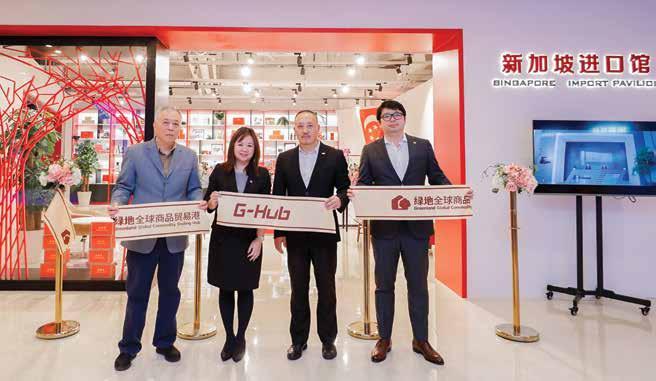
In the 1970s, Singapore faced an oil crisis, and the British withdrew its troops from Singapore. The Chamber worked alongside the government to push industrialisation projects forward, strengthen economic development and assist members in venturing into overseas markets.
In the 1980s, Singapore encountered her first postindependence economic recession. The Chamber cooperated with the government’s industrialisation policy to develop Singapore into a manufacturing hub and foster its development in the trade, transportation, financial and tourism sectors to create an open economy.
In the 1990s, Singapore experienced a third oil crisis and the Asian financial crisis. The Chamber supported the government’s policy on the transformation towards a knowledge-based economy by organising the first World Chinese Entrepreneurs Convention, and actively encouraging local small and medium-sized enterprises (SMEs) to adopt digitalisation.
As it entered the 21st century, Singapore continued to face new challenges. These included the September 11 terrorist attacks in the United States, the severe
Centennial Chapters: Serving the People
acute respiratory syndrome (SARS) outbreak and the United States subprime mortgage crisis, which caused a global financial crisis. The Chamber has since worked with the government to develop a cross-century development strategy, leading SMEs towards a globalised, free trade and digitalised economy.
Since 2010, the government has encouraged businesses to increase productivity, provide highvalue job opportunities for the manufacturing industry, and promote innovation. This is to develop Singapore into a leading smart nation in Asia. The Chamber set up the Trade Association Hub to assist the industrial and commercial sector in industrial transformation, assisting members to expand their businesses and explore global business opportunities. Despite facing the challenges of the COVID-19 pandemic, the Chamber has donated generously as the nation combated the virus. This allowed the Chamber to continue giving back to society. The Chamber also set up the Singapore Import Pavilion in Shanghai to help members to expand their business overseas, and to create more business opportunities.
1970年代新加坡经历石油 危机与英国撤军,总商会亦与 政府并肩,推动工业化生产、强化 经济发展,同时也协助会员开拓 海外市场。 来到1980年代,新加坡面对 建国以来首波经济衰退,总商会 配合政府的产业转型,发展以 制造业为中心的贸易、交通、 金融、旅游等多元化经济。
石油危机与亚洲金融风暴, 总商会首创世界华商大会,支持 政府朝知识密集转型,积极推 动本地中小企业进入电脑化和 网际网络时代。
病毒危机、美国次级房贷危机
总商会配合政府推行跨世纪
1990年代新加坡走过第三次
迈入21世纪,新加坡面对新的 挑战,包括美国911恐袭、SARS
所导致的全球经济放缓等等。
发展策略,带领商家共同迈向
经济国际化、贸易自由化,以及 企业高科技化的目标。 2010年以来,政府鼓励企业 提高生产力,为制造业提供高增 值工作机会,以及推广创新活 动,将新加坡打造成亚洲领先 的环球都市及智慧国。总商会 设立商团中心,继续协助工商界 进行产业转型。即便是在冠病 疫情的挑战下,总商会合力抗 疫、出钱出力,继续回馈社会。 总商会也在中国上海设立新 加坡进口馆,协助会员扩张业 务,开拓商机。 总商会于2021年在上海设立新加坡进口馆,协助推动新加坡产品。
导 论
百年华章 为民立命 Introduction 13 12
李光耀在总商会60周年庆典上说:“新加坡中华 总商会的历史反映着新加坡的历史。”
这本书的内容共分五部分,首先为导论,其次 介绍总商会成立以来的34位会长及其任内主要事
迹。其三则通过二战后总商会主导的16个事件来
说明华商精神故事,其四选录迈入21世纪后有关 总商会的重大新闻。最后是结语。
本书以华商精神为主题,旨在勾勒过去116年 来总商会的历史图像,特别是回到新加坡的历史

脉络,通过历届会长与重要事件来说明总商会的 华商精神故事,让年轻一代认识总商会在新加坡 的发展中所扮演的积极角色。❖
As we follow the historical journey of Singapore since its founding, we can see that the local Chinese business community and Singapore’s development are strongly intertwined. This is especially so after the establishment of the Chamber, demonstrating the Chamber’s close association with the fate of Singapore. As Lee Kuan Yew, the founding Prime Minister, once said during the 60 th anniversary of the Chamber, “The history of the Singapore Chinese Chamber of Commerce is a reflection of the history of Singapore.” This book is divided into five parts. The first part is the introduction. In the second part, we will present the 34 Presidents of the Chamber and their achievements. In the third part, we will delve
into 16 significant events helmed by the Chamber after World War II, demonstrating the stories of the Chinese Entrepreneurial Spirit. The fourth part showcases selected news reports related to the Chamber in the 21 st century. Concluding remarks will be presented in the last part. The theme of the book is the Chinese Entrepreneurial Spirit. It aims to outline the historical image of the Chamber over the past 116 years by reviewing Singapore ’ s historical development. It uses the milestones of the Presidents and major events to explain the Chamber Chinese Entrepreneurial Spirit, allowing the younger generation to learn about the roles that the Chamber played in the country’s development. ❖
当我们跟随新加坡开埠后的历史进程,可以 充分感受到本地华商与新加坡的发展息息相 关。尤其是总商会成立后的历史演变,更是与 新加坡的命运紧密结合在一起。因此,建国总理
导 论 Centennial Chapters: Serving the People 百年华章 为民立命 Introduction 15 14
ONE

第一章
(the 1840s)
CHAPTER
新加坡河景(1840年代) Singapore River
商海领航 帷幄运筹
本 章介绍总商会历届会长及其任内的主要
工作和事跡。会长是总商会组织中的最高 领导人,对外全权代表总商会,对内则负起协调董
事意见、裁定会务、监督贯彻董事会的各项决议,
并于会员常年大会上向全体会员负责。
总商会会长不仅是一名成功的商人,更具备
“才、智、资、望”等社会领袖特质。换言之,才品
方正、熟悉商情、热心公益、具有社会名望及经济 地位,都是总商会领导人的基本素质。会长由董
事中选举产生,贤德者脱颖而出。
我们唯有回到特定的社会脉络与历史时空,
才能理解每一位会长和他所处的时代,以及其任
The Leadership Stories of the SCCCI Presidents
内所面对的考验和挑战。过去一个世纪多以来
总商会可分为:自成立至二战前(1906 1942年)、
日本占领(1942 1945年)、争取自治到新马合并
(1945 1965年)、建国至今(1965― )等各个时期。
在不同会长的带领下,总商会百余年来持续引领
工商界发展,促进新加坡经济繁荣,落实社会服务
热心文化教育及公益活动。让我们跟随每一任会
长的故事,看大时代的缩影,认识总商会与新加坡 历史的关系。 ❖
T his chapter introduces the achievements of the Chamber’s Presidents from different terms.
The President of the Chamber is the leader of the organisation. He represents the Chamber and is responsible for consolidating the various opinions of the Council Members, for making decisions, and for supervising and implementing the decisions made by the Council, and must be accountable to all members at the Annual General Meetings. The President of the Chamber should not only be a successful businessman. He has to possess the characteristics of a leader of the community, namely talent, wisdom, acumen and eminence. In other words, the President should be morally upright, have business acumen, give back to society, and have good economic and social standing. The Council has always elected the President of Chamber based on these exceptional values.
Only when we look at the specific social and historical context can we understand each President, the era in which he led, and the challenges faced. In the past century, the Chamber witnessed the pre-war era (1906–1942), the Japanese Occupation (1942–1945), the fight for independence (1945–1965), and the post-independence years (1965–present). Since 1906, under the leadership of different Presidents, the Chamber has continued to lead the local business community, push Singapore’s economy forward, give back to society, and contribute actively to cultural, educational and philanthropic activities. Let us trace the story of each President and position ourselves in the macrocosm of the Chamber to understand the historical relationship between the Chamber and Singapore’s history. ❖
第一届 (1906-1907年)
及第三届 (1908-1909年)

总理
吴寿珍 Goh Siew Tin
The First (1906–1907) and Third (1908–1909) President of the Chamber
Goh Siew Tin (1854–1909) came from Zhao’an, Fujian province. From a young age, he assisted his father in managing their business, Chop Ann Ho, which dealt in local products, tin slags, wood products and shipping.
During his tenure as President, he mediated disputes among the different dialect groups, donated to build schools, raised funds for disaster relief and encouraged the merchants to invest. He also proposed to the British colonial government to abolish the unfair rule of requiring Chinese passengers entering Singapore to strip naked for physical examination at the quarantine station. He served as a Board Member of Le Shan She and Thian Hock Keng Temple, and rendered services as a Committee Member of Po Leung Kuk under the Chinese Protectorate. He was the Acting Consular General of the Qing consulate in Singapore and a well-known leader in the Chinese community.
吴寿珍(1854 1909年),福建诏安人。自幼随父
经商,管理安和号,经营土产、锡米、木业、 船务等生意。 吴寿珍在总理(会长)任内,协调帮群纠纷、
资助学校、募捐救灾、招商引资,曾向英殖民地
政府提出废除中国旅客裸体检疫的不合理规定。 吴寿珍也出任乐善社、天福宫董事,身兼
第 一 章 The Leadership Stories of the SCCCI Presidents 商海领航 帷幄运筹 Chapter One 21 20
英国殖民地政府华民政务司保良局委员、清朝驻 新加坡代理总领事等职务,为本地知名华社领袖。
Chua Chu Yong (1847–year unknown) came from Chenghai, Guangdong province. In 1874, he came to Singapore and owned businesses dealing in silk and polished rice along South Bridge Road. During his tenure as President, he pushed forward the drafting of the Chamber’s Rules, purchased printing machines to save costs, urged the colonial government to ban opium smoking and fought for the circulation and exchange of old silver coins.
Chua Chu Yong was also a philanthropist. In 1902, he led the local Teochews in donating 30,000 Straits dollars’ worth of rice to provide relief during the rice shortage in Chaozhou. He was a Committee Member of the Chinese Advisory Board.

蔡子庸
第二届
总理
Chua Chu Yong
(1907-1908年)
The Second President of the Chamber (1907–1908)
他担任总理期间,推动建会章程,自购印字 机器以节繁费,呼吁殖民政府禁烟,争取旧式银元 的流通和收换。 蔡子庸为人乐善好施,曾于1902年领导本地 潮侨以时值三万叻币的白米救济潮州米荒。他也 担任华人参事局的委员。 第 一 章 The Leadership Stories of the SCCCI Presidents 商海领航 帷幄运筹 Chapter One 23 22
蔡子庸(1847 不详),广东澄海人。1874年南来 新加坡,于桥南路从事绸缎和白米生意。
林维芳(1863 1910年),广东新宁(台山)人。他所
Lam Wai Fong
Lam Wai Fong (1863–1910) came from Xinning (Taishan), Guangdong province. He started the Kwong Yik Bank, making him a pioneer of the local Chinese banking industry.
During his tenure as President, he revised the Chamber’s Rules, led the fundraising for the Fuzhou typhoon disaster relief, assisted the Chinese merchants to obtain travel documents for business purposes, rescued the poor and sickly, and assisted them on their return to China. He also assisted the Chinese businessmen in Batu Pahat, the state of Johor, Malay Peninsula, to establish their Chamber of Commerce.

同时也协助马来半岛柔佛州峇株巴辖的华商成立 其商会。 林维芳
第四届 (1909-1910年) 总理 The Fourth President of the Chamber (1909–1910) 第 一 章
创立的广益银行,开本地华人银行业之先河。 林维芳在其总理任内,曾修订章程,领导筹赈 福州风灾,办理回华商照,救助贫病者返回中国,
商海领航 帷幄运筹 Chapter One 25 24
The Leadership Stories of the SCCCI Presidents
总理
张善庆 Teo Sian Keng
1916年),福建南靖人。
Teo Sian Keng (1855–1916) came from Nanjing, Fujian province.

During his tenure as President, the Chamber drafted the “Arbitration Guidelines for Closure of Companies’ Operation Issued by the Chamber”, unveiled a Chamber flag, led the relief effort for the Chaozhou drought and opposed the income tax proposed by the British colonial government.
He was once the President of Tao Nan School’s Board. He supported Sun Yat Sen’s revolutionary movement and received the Order of the Golden Harvest medal, awarded by the Chinese government.
The Fifth (1910–1911) and Seventh (1912–1913) President of the Chamber
第五届 (1910-1911年) 及第七届 (1912-1913年)
张善庆(1855
在其两届总理任期内,总商会拟定了《商号 倒闭商会出任仲裁简章》、制定商旗;发动劝募 救济潮汕旱灾;并反对英殖民政府提出的入息 所得)税。 张善庆也出任道南学校总理。他支持孙中山 的革命运动,荣获当时中国政府颁发嘉禾奖章。
第 一 章 The Leadership Stories of the SCCCI Presidents 商海领航 帷幄运筹 Chapter One 27 26
Leow Chia Heng
The Sixth (1911–1912) and Ninth (1914–1915) President of the Chamber

廖正兴(1874
1931年),广东潮安人,四海通银行 创办人。 两届总理任内,他带领总商会协助民国政府
第六届 (1911-1912年) 及第九届 (1914-1915年)
总理
廖正兴
Leow Chia Heng (1874–1931) came from Chao’an, Guangdong province. He founded the Sze Hai Tong Bank and Insurance Company Limited. During his tenure as President, he led the Chamber to assist the Chinese government in disaster relief activities, and was actively involved in donating to safeguard the security in Fujian, providing relief to Guangdong, and funding the return of the poor and sick Chinese to their hometowns. During the outbreak of war on the European front in 1914, the Chamber assisted local businesses to overcome the crisis. In 1915, the Chamber changed its premier system to the presidential system and the term of office was changed from one year to two years. During his tenure, the Chamber also purchased the property at Hill Street where the Chamber is located today. He served as a Committee Member of Po Leung Kuk, a Committee Member of the Chinese Advisory Board and a Justice of the Peace. 赈灾救难,积极投入福建保安和广东救济活动,
并资助贫病华民返乡。1914年欧战爆发后,总商会 大力协助本地商家度过危机。自1915年起将总 理制改为会长制,任期从一年改为两年一任。
第 一 章 The Leadership Stories of the SCCCI Presidents 商海领航 帷幄运筹 Chapter One 29 28
总商会亦在其任内购置禧街的产业,即今会所的所 在。 他也担任过新加坡保良局委员、华人参事局 委员等职,获委为太平局绅。
林秉祥 Lim Peng Siang

The Eighth (1913–1914) and 10th (1915–1917) President of the Chamber
对本地社会的贡献。
Lim Peng Siang (1872–1944) came from Longxi, Fujian province. After coming to Singapore, he studied at St Joseph’s Institution. He then followed in his father’s footsteps to set up businesses. He set up the Ho Hong Company and Ho Hong Bank. His lines of business involved shipping and manufacturing. During his tenure as President, he established a new accounting school and unified the bookkeeping system. In 1915, under his presidency, the Chamber raised funds to donate a fighter aircraft in support of the British war effort in Europe. When the British colonial government increased income taxes to offset war expenditures, the Chamber proposed to tax the landlords to alleviate the burden on the business sector. In the same year, the Chamber also helped to raise funds to relieve the floods in Guangdong. As a result, the Chinese government awarded the Chamber with a commemorative plaque with the phrase “Unifying for the Future” (Qun Ce Kuang Shi). He was appointed as a Committee Member of the Chinese Advisory Board and a Justice of the Peace. Peng Siang Quay in Singapore was named after him to commemorate his contributions to the society.
第八届 (1913-1914年) 总理 及第十届
会长
(1915-1917年)
任内推出新式会计学堂,统一簿记。1915年, 总商会筹款捐赠战机一台支援英军在欧洲的 战事;当殖民政府为抵消欧战开支而增抽入息 税时,总商会建议政府改抽牌租税以减轻商界
林秉祥亦担任华人参事局委员及受委为太平
林秉祥(1872
1944年),福建龙溪人。南来后就读
圣约瑟书院,随父经商,创办实业,开设和丰银行, 经营海运有成。
负担;同年,总商会也协助筹赈广东水灾,获中国 政府颁给“群策匡时”匾额。
局绅。新加坡的“秉祥基”以他的名字命名,纪念他
第 一 章
商海领航 帷幄运筹 Chapter One 31 30
The Leadership Stories of the SCCCI Presidents
陈德润 Tan Teck Joon
The 11th President of the Chamber (1917–1918)
Tan Teck Joon (1859–1918) came from Chao’an, Guangdong province.
He was a successful silk and cloth merchant. In 1908, he initiated the founding of the Teochew Textile Trader’s Association. He was also one of the founders of Sze Hai Tong Bank and Insurance Company Limited and Tuan Mong School.
During his tenure as President, the Chamber encouraged the Chinese in Singapore to return to China and support its industrialisation efforts. At the same time, the Chamber also published articles in the newspaper to encourage the public to purchase Straits Settlements bonds and participated in negotiations on income tax with the government. The Chamber also raised funds via various channels to provide relief for local and overseas disasters.
Tan Teck Joon passed away in March 1918. Tan Jiak Ngoh, a Council Member, succeeded as the acting President.

第十一届 (1917-1918年) 会长
陈德润 (1859 1918年), 广东潮安人。
第 一 章
陈德润是一名成功的布商,于1908年参与 成立新加坡布行商务局,也是四海通银行和端蒙 学校创办人之一。 会长任内,总商会鼓励本坡华民回中国兴办 实业,同时亦登报鼓励认购海峡殖民地军劵,并协 调入息税事宜。此外,总商会亦多方协助国内外 的筹赈活动。
陈德润于1918年3月逝世,会长职缺由董事 陈若愚暂代。
商海领航 帷幄运筹 Chapter One 33 32
The Leadership Stories of the SCCCI Presidents
薛中华 See Tiong Wah
The 12th (1919–1921) and 14th (1923–1925, by-election) President of the Chamber
See Tiong Wah (1886–1940) had ancestral roots in Zhangzhou, Fujian province, and was born in Singapore. He studied at St Joseph’s Institution. After graduation, he joined his father in the Comprador’s Department of The Hongkong and Shanghai Banking Corporation (HSBC) in Singapore.
During his tenure as President, he continued to negotiate with the government regarding income tax, food supply regulation as well as a new Chinese cemetery. He also raised funds to support the Chinese High School and Raffles Institution. In addition, the Chamber also raised funds to provide relief to victims of natural disasters in the different provinces in China. He also held office as a Committee Member of the Chinese Advisory Board and served as the Municipal Commissioner as well as a Justice of the Peace.

第十二届 (1919-1921年) 及第十四届
补选) 会长
(1923-1925年,
薛中华(1886
1940年),祖籍福建漳州,新加坡
业,加入汇丰银行成为买办。
出生,就读于圣约瑟书院,毕业后随父投身银行
会长任内,持续与政府协调入息税、管粮 法令及华人义山等事宜,筹款资助南洋华侨中学 及莱佛士英校、同时也募款救济中国各省灾民。
第 一 章
薛中华亦担任华人参事局委员、市政会议员 及受委为太平局绅等。
商海领航 帷幄运筹 Chapter One 35 34
The Leadership Stories of the SCCCI Presidents
林义顺 Lim Nee Soon
中华总商会月报》。1926年,林义顺反对殖民地邮
Lim Nee Soon (1879–1936) had ancestral roots in Chenghai, Guangdong province, and was born in Singapore. He was homeschooled when he was young and subsequently attended St Joseph’s Institution. His businesses were very successful. He also supported Sun Yat Sen’s revolutionary activities.

The 13th (1921–1923) and 15th (1925–1927) President of the Chamber
主席等职务。
During his tenure as President, in 1922, the Chamber launched The Commercial Monthly. In 1926, Lim Nee Soon opposed the abolition of the policy of allowing letters to be combined into one consignment. He also opposed the increase of the postage rates and proposed to add Chinese names in the railway stations and on the tickets.
He was also known as the “Rubber King” and “Pineapple King”. Furthermore, he also served as a member of the Singapore Rural Board, the first President of the Teochew Poit Ip Huay Kuan and the Chairman of the Ee Hoe Hean Club.
第十三届 (1921-1923年) 及第十五届 (1925-1927年) 会长
出生,幼时先上私塾、后读圣约瑟书院,毕业后经 商有成,积极支持孙中山的革命活动。
林义顺(1879 1936年),祖籍广东澄海,新加坡
1922年,林义顺在其会长任内创办《新加坡
局废止信包及增加邮费的政策、同时也函请政府在 火车站及车票上加写华文。 林义顺享有树胶和黄梨大王美誉,曾出任新加坡 乡村局局员、潮州八邑会馆首届总理、怡和轩
第 一 章
商海领航 帷幄运筹 Chapter One 37 36
The Leadership Stories of the SCCCI Presidents
林推迁 Lim Chwee Chian
Lim Chwee Chian (1868–1923) came from Haicheng, Fujian province. He was involved in shipping, plantation and mining (wolfram). He was known as the “Wolfram King of Malaya”. However, he passed away soon after taking on the role as the President of the Chamber, and See Tiong Wah took over the position. During his tenure as President, the Chamber published notices in newspapers to canvass donations to provide relief for people affected by the Great Kanto earthquake in Japan. He also proposed to the colonial government to gradually phase out the issuing of opium licences. He served as the Chairman of the Thong Chai Medical Institution and Ee Hoe Hean Club, and a Board Member of the Chinese High School and Chung Hwa Girls’ School. He was appointed as a Justice of the Peace and a Committee Member of Po Leung Kuk as well as the Chinese Advisory Board. He was awarded the Order of the Golden Harvest medal by the Chinese government.

第十四届 (1923年) 会长
The 14th President of the Chamber (1923)
林推迁 (1868 1923年),福建海澄人,从事船运业、
接任。任内通过总商会登报劝募,救赈日本地震 灾民,建议殖民地政府逐年取消烟廊牌照。 林推迁曾担任同济医院主席、怡和轩主席、 华侨中学及中华女校董事,也出任太平局绅、
第 一 章 The Leadership Stories of the SCCCI Presidents 商海领航 帷幄运筹 Chapter One 39 38
种植业及钨矿,享有马来亚钨矿大王美誉。 林推迁当选会长后不久便辞世,遗缺由薛中华
保良局委员及华人参事局委员等职,曾获中国政府 颁发嘉禾奖章。
薛武院 See Boon Ih
The 16th President of the Chamber (1927–1929)
See Boon Ih (1873–1940) came from Xiamen, Fujian province. He was involved in the rubber plantation industry.

During his tenure as President, he took the lead in raising funds to provide relief to those affected by the flood in Kuantan, the state of Pahang, Malay Peninsula. He assisted the colonial government in pacifying the unrest caused by the Kreta Ayer Incident, which broke out in Chinatown during the death anniversary of Sun Yat Sen. He also urged the government to repeal the Immigration Restriction Ordinance, protecting the interests of the Chinese community.
He also served as the Chairman of the Chinese Commercial Bank Limited, the Manager of the Oversea-Chinese Banking Corporation Limited, and the President of the Singapore Ho San Kong Hoey.
第十六届 (1927-1929年) 会长
的暴动事件。他也要求政府取消限制移民条例, 维护华社利益。
第 一 章 The Leadership Stories of the SCCCI Presidents 商海领航 帷幄运筹 Chapter One 41 40
薛武院(1873
1940年),福建厦门人,从事树胶
种稙业。 会长任内筹赈马来半岛彭亨州的关丹水灾, 协助殖民地政府平抚孙中山忌日发生在牛车水
他也出任华商银行董事会、华侨银行经理、 新加坡禾山公会会长等职。
李伟南 Lee Wee Nam
Lee Wee Nam (1880–1964) came from Chenghai, Guangdong province. At the age of 16, he set sail for Singapore and worked at Sze Hai Tong Banking and Insurance Company Limited, beginning a career in banking and finance. His tenure coincided with the Great Depression. He contributed significantly to help the needy and alleviate hunger. He petitioned the colonial government to set up a pottery factory for unemployed civilians.
He served as the President of Ngee Ann Kongsi and Teochew Poit Ip Huay Kuan. In
1938, he established the Singapore Kwangtung Hui Kuan and was elected as its first President. He was appointed as a Committee Member of Po Leung Kuk and the Chinese Advisory Board, and as an inspector of the quarantine station on St John’s Island.

第十七届 (1929-1931年) 会长
李伟南(1880
新加坡,任职四海通银行,从事金融业。 会长任内,适逢世界经济大萧条。他慷慨
1964年),广东澄海人,16岁时南来
解囊,救济饥民,极力请求殖民地政府设立平民 工艺厂收纳失业工人。 李伟南曾担任义安公司总理及潮州八邑会馆 总理,并于1938年参与创设广东会馆,出任首任 会长。他亦先后担任保良局委员、华人参事局委员
及棋樟山检疫所巡视员。
第 一 章 The
Presidents 商海领航 帷幄运筹 Chapter One 43 42
The 17th President of the Chamber (1929–1931)
Leadership Stories of the SCCCI
李俊承 Lee Choon Seng
The 18th President of the Chamber (1931–1933)
Lee Choon Seng (1888–1966) came from Yongchun, Fujian province. He was the founder of the Chinese Commercial Bank Limited. During his tenure as President, he established the China Relief Fund for Disasters Committee and held a special discussion on the Aliens Ordinance.
In 1937, Lee Choon Seng, together with other Chinese merchants, jointly bought over the Sun Yat Sen Villa and handed the property rights to the Chamber, preserving Singapore’s history and heritage. This villa was Sun Yat Sen’s former residence.
In 1935, the Governor of the Straits Settlements conferred a medal to him. He also served as the Chairman of the Eng Choon Hway Kuan, President of the Singapore Lee Clan Association, Chairman of the Ee Hoe Hean Club and President of the United Chinese Library.

第十八届 (1931-1933年) 会长
最后将产权交由总商会管理,使新加坡的历史 遗产得以保存。此别墅曾是孙中山故居。 李俊承于1935年荣获海峡殖民地总督颁赐 勋章,他也担任永春会馆主席、陇西李氏总会会长、 怡和轩主席、同德书报社社长等职务。 第 一 章 The Leadership Stories of the SCCCI Presidents 商海领航 帷幄运筹 Chapter One 45 44
李俊承(1888 1966年),福建永春人,华商银行 创办人。 会长任内成立“星洲华侨救济中国惨灾 筹赈会”,亦召开特大讨论“外侨居留条例案”。 1937年,李俊承联合本地华商购置晚晴园,
林文田 Lum Mun Tin
The 19th President of the Chamber (1933–1935)
Lum Mun Tin (1873–1943) came from Taishan, Guangdong province. He came to Singapore at the age of 16 and went into the pawnshop business. During his tenure as President, the Chamber revised its Rules to change the words “Chinese sojourner” to “ethnic Chinese”, signalling the Chinese merchants’ shift in identifying with Singapore as their home, in the pre-war era. In 1934, the Chamber set up the Bukit Ho Swee Fire Relief Committee to help those affected by the fire.
Lum Mun Tin served as the President of the Singapore Pawnbrokers’ Association, a Committee Board Member of the Chinese High School and a Committee Member of Po Leung Kuk and the Chinese Advisory Board.

第十九届 (1933-1935年) 会长
新加坡,经营当铺生意。 会长任内,总商会通过章程修改,将“吾侨” 改为“华人”,代表战前华商已出现本土认同之 转向;总商会亦于1934年成立“救济河水山火灾 委员会”,协助灾黎度过难关。 林文田也担任新加坡当商公会会长、华侨 中学董事、保良局及华人参事局委员等职。 第 一 章 The Leadership Stories of the SCCCI Presidents 商海领航 帷幄运筹 Chapter One 47 46
林文田(1873 1943年),广东台山人,16岁南来
林庆年 Lim Keng Lian
The 20th President of the Chamber (1935–1937)
Lim Keng Lian (1893–1968), a Peking University graduate, came from Anxi, Fujian province. He came to Singapore in 1924 and was involved in the tea trading business.

During his tenure as President, he took the lead and organised the Chinese Trade Fair, and expanded it to Perak, Vietnam, Batavia and other places. The Chamber also assisted the Chinese consulate in registering the Chinese nationals.
Lim Keng Lian also contributed greatly to Singapore’s Chinese education sector. He was a pioneer in promoting Chinese as the medium of instruction in Chinese schools. He helped to establish Sin Nan Public School in Jurong and suggested the implementation of examinations in primary schools.
第二十届 (1935-1937年) 会长
记侨民的工作。
第 一 章 The Leadership Stories of the SCCCI Presidents 商海领航 帷幄运筹 Chapter One 49 48
林庆年(1893 1968年),福建安溪人,北京大学 毕业。1924年南来新加坡,经营茶庄生意。 会长任内扩大举办国货展览推销大会至霹雳、 越南、巴达维亚等地;总商会协助中国领事馆登
林庆年对本地华文教育贡献良多,率先在学校 推动国语教学、推广华语、统一学校语言。 他也参与创办裕廊醒南学校,建议小学实施会考 制度。
陈振贤 Tan Chin Hian
The 21st President of the Chamber (1937–1939)
1964年),广东潮安人。1925年南来
Tan Chin Hian (1893–1964) came from Chao’an, Guangdong province. He came to Singapore in 1925. He served as the Director of Sze Hai Tong Banking and Insurance Company Limited.

During his tenure as President, the Chamber, on one hand, organised events to celebrate the coronation of King George VI. On the other hand, the Chamber bought $50,000 worth of war bonds to support China’s effort in resisting the Japanese invasion. The Chamber also issued a notice to encourage merchants to donate to China. He served as the President of Teochew Poit Ip
Huay Kuan, Vice-President of Ngee Ann Kongsi and a member of the Chinese Advisory Board. He was a well-known leader of the Teochew community.
第二十一届 (1937-1939年) 会长
支持中国抗日,并发表通告鼓励商家捐款救济 中国。
第 一 章 The Leadership Stories of the SCCCI Presidents 商海领航 帷幄运筹 Chapter One 51 50
陈振贤(1893
新加坡,担任四海通银行司理。 会长任内,总商会一方面筹办英皇加冕庆祝 活动,一方面因应日本侵华购买五万元战争债券
陈振贤曾任潮州八邑会馆总理、义安公司副 总理、华人参事局委员,是本地著名的潮社领袖。
李光前 Lee Kong Chian

The 22nd (1939–1941) and 24th (1946–1948) President of the Chamber
Lee Kong Chian (1893–1967) came from Nan’an, Fujian province. In 1903, he came to Singapore and successfully built his business empire. He made a mark in the rubber trade, pineapple, and banking businesses.
During his tenure as President, he assisted the British colonial government by acting as the mediator when the staff at the Singapore General Hospital went on strike. He also supported the Chinese Consulate’s campaign to ban opium smoking. In 1947, he established a task force to discuss the issues on the Malayan Union constitutional report and citizenship before submitting a proposal to the British colonial government.
He was a firm believer in education and public welfare. In 1952, he set up the Lee Foundation. He is well remembered as an outstanding Chinese entrepreneur, educationist and philanthropist.
第二十二届 (1939-1941年) 及第二十四届
(1946-1948年) 会长
工友罢工事件,支持中国驻新总领事推动禁烟
李光前(1893
1967年),福建南安人。1903年南来 新加坡,经商有成,涉足树胶、黄梨、金融等产业。 会长任内,协助英殖民政府调解中央医院
运动。1947年,李光前成立研究小组探讨马来亚制
第 一 章 The Leadership Stories of the SCCCI Presidents 商海领航 帷幄运筹 Chapter One 53 52
宪报告书及公民权事宜,并向英殖民政府递呈意 见书。 李光前一生热心教育和公益。1952年,他 设立李氏基金,被誉为杰出的华人企业家、教育 家和慈善家。
连瀛洲 Lien Ying Chow
The 23rd President of the Chamber (1941–1946)
连瀛洲(1906 2004年),广东潮阳人。14岁南来
Lien Ying Chow (1906–2004) came from Chaoyang, Guangdong province. He arrived in Singapore when he was 14 and later started the Overseas Union Bank.

Lien Ying Chow was the youngest in the Chamber’s history to be elected president. He assumed the role of President of the Chamber on the eve of the outbreak of the Pacific War. He represented the views of the businessmen to oppose the colonial government from raising income tax. He established the Relief Fund Committee to deal with the food distribution issue. He also urged businesses to remain open to safeguard and protect the interests of the public.
Lien Ying Chow served as the President of Ngee Ann Kongsi. He also played a key role in the founding of Ngee Ann College and Nanyang University. In 1966, he served as the Singapore High Commissioner to Malaysia.
第二十三届 (1941-1946年) 会长
新加坡,后创办华联银行。 连瀛洲是总商会最年轻的会长。会长任内, 正值太平洋战争爆发前夕,他代表商家反对入 息税,同时也成立“星华救护委员会”,处理粮食 分配问题。他也劝请商家照常开市,维护和保障 社会大众的利益。 连瀛洲曾担任义安公司总理,他也是义安学 院创办人之一。此外,他也积极推动南洋大学的 创立。他于1966年出任新加坡驻马来西亚最高专 员。 第 一 章 The Leadership Stories of the SCCCI Presidents 商海领航 帷幄运筹 Chapter One 55 54
杨溢璘 Yong Yit Lin
The 25th President of the Chamber (1948–1950)
总商会致函辅政司
Yong Yit Lin (1896–1950) came from Meixian, Guangdong province. He was involved in the construction industry.

During his tenure as President, in 1949, the Chamber campaigned to donate to the poor and sick who were forced to repatriate by the British colonial government during the Malayan Emergency. Meanwhile, the Chamber wrote to the Colonial Secretary of Singapore to oppose the charges of the landing permit. The Chamber also encouraged Chinese who were British subjects to register as citizens to be able to vote in the Legislative Council election.
He also served as the President of Ying Fo
Fui Kun, President of the Singapore Contractors Association, a member of the Chinese Advisory Board and a Justice of the Peace.
第二十五届 (1948-1950年) 会长
及家属义捐”,以协助马来亚紧急状态时期被英国
第 一 章
杨溢璘(1896 1950年),广东梅县人,从事建筑业。 会长任内,总商会于1949年发动“被遣离穷苦
殖民地政府遣返回中国的民众;
反对登岸证收费。总商会亦鼓励英籍华人登记为 公民,以便在立法议员选举中取得投票权。 他也曾担任新加坡应和会馆总理、新加坡 建筑商公会会长、华人参事局委员、太平局绅等
职。
商海领航 帷幄运筹 Chapter One 57 56
The Leadership Stories of the SCCCI Presidents
陈六使 Tan Lark Sye
1953年,陈六使再以个人名义捐赠五百万元给
Tan Lark Sye (1897–1972) came from Tong’an, Fujian province. He came to Singapore at the age of 18, establishing his business in the rubber industry. During his tenure as President, he donated $500,000 in the name of the Chamber to the University of Malaya Foundation. He raised funds to provide relief for victims of the Kampong Bugis fire. He also led the Chamber in the fight for citizenship rights.

The 26th President of the Chamber (1950–1952)
In 1953, he personally donated $5 million to Nanyang University to fully support the establishment of the first Chinese-medium university to nurture local talents.
He also served as the President of the Hokkien Huay Kuan, the Chairman of the Rubber Trade Association of Singapore and the Chairman of the Ee Ho Hean Club.
第二十六届 (1950-1952年) 会长
陈六使(1897 1972年),福建同安人。18岁南来 新加坡,从事树胶业。 会长任内,陈六使以总商会名义捐款五十万 作为马来亚大学基金。他也在任内拨款救济武义 村大火的灾民; 带领总商会积极争取公民权。
南洋大学,全力支持第一所华文大学的创立,为本 地作育英才。 陈六使也担任福建会馆主席、新加坡树胶
第 一 章
工会主席、怡和轩主席等职务。
商海领航 帷幄运筹 Chapter One 59 58
The Leadership Stories of the SCCCI Presidents
陈锡九 Tan Siak Kew
The 27th (1952–1954) and 29th (1956–1958) President of the Chamber
Tan Siak Kew (1903–1977) came from Chao’an, Guangdong province. He came to Singapore in 1910 and received his education from St Anthony’s Boys’ School and Raffles Institution. His business was involved in trading and banking.
During his tenure as President, he supported the Public Service Commission Ordinance and led the Chamber to assist the government in building up Singapore’s national defence. The Chamber assisted 300 youths in the registration for National Service. He also set up a registration booth in the Chamber, allowing secretariat staff to assist locals in the citizenship application process. He held important positions in the Chinese Advisory Board, Ngee Ann Kongsi and Teochew Poit Ip Huay Kuan. In 1965, he was appointed as Singapore’s first ambassador to Thailand.

第二十七届 (1952-1954年) 及第二十九届
(1956-1958年) 会长
陈锡九(1903 1977年),广东潮安人。1910年南来,
会长任内,陈锡九拥护民众服务法案,带领总
就读圣安东尼小学、莱佛士书院,经营百货贸易 及银行。
入伍登记。他亦在总商会设立公民权登记站,让 秘书处义务协助民众填写申请表格。 陈锡九也出任华人参事局委员、义安公司、
为新加坡首任驻泰国大使。 第 一 章 The Leadership Stories of the SCCCI Presidents 商海领航 帷幄运筹 Chapter One 61 60
商会协助政府建军、办理首批为数300人的青年
潮州八邑会馆总理等重要职务。他在1965年受委
Ko Teck Kin
The 28th (1954–1956), 30th (1958–1960), 31st (1960–1962) and 32nd (1962–1965)
President of the Chamber
Ko Teck Kin (1911–1966) came from Longxi, Fujian province. He followed in his father’s footsteps to manage businesses. His businesses were involved in the shipping, rubber plantation and other industries. During his tenure as President, he created the Citizenship Rights Committee and encouraged the public to register as electors to vote in the 1955 Singapore General Election. In 1959, the Chamber also organised the Singapore Constitution Exposition to commemorate the internal selfgovernment of Singapore, and it was the largest exposition in Southeast Asia. In 1964, the Chamber also completed the construction project of the new Chamber building.
Ko Teck Kin served as the Chairman of the Ee Ho Hean Club, Chairman of Chung Cheng High School’s Board, President of the Singapore Koh Clan Association and President of the Singapore Leong Khay Huay Kuan. He was appointed as the first High Commissioner to Malaysia in 1965.

第二十八届 (1954-1956年) 第三十届 (1958-1960年) 第三十一届 (1960-1962年) 及第三十二届 (1962-1965年) 会长
高德根
总商会也在1964年顺利完成新会所重 建工程。 高德根也担任怡和轩主席、中正中学董事
第 一 章 The Leadership Stories of the SCCCI Presidents 商海领航 帷幄运筹 Chapter One 63 62
高德根(1911 1966年),福建龙溪人,随父从商, 从事船运、树胶等业务。 会长任内,总商会成立“推动选民选举 委员会”,鼓励民众登记成为选民,行使1955年 议会选举的投票权。1959年,总商会举办“庆祝 新加坡自治博览会”,成为当时东南亚最大的 展销会
主席、高氏公会以及龙溪会馆主席等职。1965年 他受委为第一任新加坡驻马来西亚最高专员。
孙炳炎 Soon Peng Yam
日本占领时期死难人民纪念碑在总商会推动下 揭幕。1968年总商会亦为国防部筹募国防基金
Soon Peng Yam (1912–2002) came from Tong’an, Fujian province. At the age of 14, he came to Singapore. He was involved in the timber industry before diversifying into other industries such as trade, property, plantations and mining.
During his tenure as President, he set up an Overseas Mission Taskforce to strengthen the Chamber’s external networks and improve trade.
The 33rd (1965–1967) and 34th (1967–1969) President of the Chamber
123万余元,支持国防力量。 孙炳炎也担任怡和轩主席、同时为福建会馆、 中华医院、圣约翰救伤队、中华游泳会等重要社团 服务。
In 1967, the Civilian War Memorial, which the Chamber campaigned for, was unveiled. In 1968, the Chamber raised more than $1.23 million towards national defence.
He served as the Chairman of the Ee Hoe Hean Club, the President of Hokkien Huay Kuan, the Chairman of the Chung Hwa Free Clinic Trust Foundation, and the President of District A of St John Ambulance Brigade, the Chinese Swimming Club and other social welfare organisations.

第三十三届 (1965-1967年) 及第三十四届 (1967-1969年) 会长
新加坡,先从事林木业,后扩展到贸易、房地产、 种植及采矿等事业。 孙炳炎在会长任内成立“贸易考察团小组”, 以加强总商会的对外联系、促进贸易。1967年,
孙炳炎(1912 2002年),福建同安人。14岁南来
第 一 章 The Leadership Stories of the SCCCI Presidents 商海领航 帷幄运筹 Chapter One 65 64
黄祖耀 Wee Cho Yaw
The 35th (1969–1971), 36th (1971–1973) and 39th (1977–1979) President of the Chamber
Wee Choo Yaw (1930– ) was born in Jinmen, Fujian province. At the age of eight, he reunited with his father in Kuching, Sarawak. He came to Singapore a year later to receive his education. The outbreak of World War II forced him to suspend his education. After the war, he joined the family business and eventually became a banker. During his tenure as President, he rallied various parties in Singapore and Malaysia to break the monopolistic practices in the freight industry. The Chamber helped the victims from Malaysia and East Pakistan and organised a delegation to visit the Socialist Republic of Vietnam. The Chamber also amended its Rules to add “Industry” to the Chamber’s English name to reflect the increasing number of members belonging to the manufacturing sector.
He served as the first President of the Singapore Federation of Chambers of Commerce and Industry, the President of Hokkien Huay Kuan and the founding President of the Singapore Federation of Chinese Clan Associations.

第三十五届 (1969-1971年) 第三十六届 (1971-1973年) 及第三十九届 (1977-1979年) 会长
接他到砂拉越的古晋团聚。一年后,再安排到
战后,加入家族事业,最终成为银行家。 会长任内,总商会团结新马各界打破航运 垄断的斗争,也募捐救济马来西亚及东巴基斯坦的 灾民,并组团访问越南社会主义共和国。同时,
黄祖耀也出任新加坡工商总会首任会长、
第 一 章 The Leadership Stories of the SCCCI Presidents 商海领航 帷幄运筹 Chapter One 67 66
黄祖耀(1930年 ― ),福建金门人。八岁时,他的父亲
新加坡接受教育。二战爆发时,被迫停学。
提出章程修改,在总商会之英文全称上加入 “Industry”,以代表逐年增加的工业会员。
福建会馆会长、新加坡宗乡会馆联合总会会长 等职务。
陈共存 Tan Keong Choon
The 37th (1973–1975), 38th (1975–1977), 42nd (1983–1985) and 43rd (1985–1987) President of the Chamber
Tan Keong Choon (1918–2015) came from Xiamen, Fujian province. He was the nephew of Tan Kah Kee, and was involved in the rubber plantation industry. During his tenure as President, the Chamber set up a $2 million education foundation to assist the development of science and technology education in Singapore. He also organised the first local Chinese Computer Exhibition and the largest ever Trade & Industry Fair in 1985. He also served as the Vice-Chairman of the Singapore National Shippers’ Council, VicePresident of the Rubber Trade Association of Singapore, Chairman of the Chinese High School’s Board, and a Council Member of Hokkien Huay Kuan, and held leadership roles in various banks.

第三十七届 (1973-1975年) 第三十八届 (1975-1977年) 第四十二届 (1983-1985年) 及第四十三届 (1985-1987年) 会长
“工商展览会85”。
第 一 章 The Leadership Stories of the SCCCI Presidents 商海领航 帷幄运筹 Chapter One 69 68
陈共存(1918 2015年),福建厦门人,陈嘉庚侄儿, 从事树胶贸易。 会长任内,总商会拨款二百万成立教育 基金,协助科学技术教育在新加坡的发展,并举
办了本地最早的“中文电脑展览会”及规模最大的
陈共存也曾出任新加坡配货人理事会副主席、 新加坡树胶公会副会长、华侨中学、福建会馆以及
多家银行的董事职务。
林继民 Lim Kee Ming
The 40th (1979–1981) and 41st (1981–1983) President of the Chamber
Lim Kee Ming (1927–2015) had ancestral roots in Chao’an, Guangdong province, and was born in Singapore. He was involved in the import and export trade industry and became Chairman of the Lim Teck Lee Group after inheriting his father’s business.

During his tenure as President, the Chamber worked with the government to assist local businesses with industry transformation. The Chamber also pushed forward the Speak Mandarin Campaign and set up a training centre to provide bilingual (English-Chinese) courses.
He also served as the President of Ngee Ann Kongsi, President of the Singapore Teochew Poit
Ip Huay Kuan, Chairman of the Singapore AntiTuberculosis Association, a Committee Member of the Economic Development Board and Singapore Trade Development Board, and Chairman of the Preservation of Monuments Board.
第四十届 (1979-1981年) 及第四十一届 (1981-1983年) 会长
集团主席。
发展高科技,支持商家朝机械化转型,同时协助 政府推广华语运动。总商会也设立语言中心, 提供中英语文课程。 林继民也担任义安公司总理、潮州八邑会馆 总理、新加坡防痨协会主席、经济发展局和贸易 发展局委员会委员、古迹保存局主席等职务。 第 一 章 The Leadership Stories of the SCCCI Presidents 商海领航 帷幄运筹 Chapter One 71 70
林继民(1927 2015年),祖籍广东潮安,新加坡 出生,从事进出口贸易,继承父业后出任林德利
会长任内,总商会配合政府协助本地企业
林荫华 Linn In Hua
The 44th (1987–1989) and 45th (1989) President of the Chamber
Linn In Hua (1924–1998) came from Jinmen, Fujian province. He went to Malaya in 1938 and later came to Singapore to set up East Machinery Group, which dealt in the trading of heavy machinery and equipment.
During his tenure as President, the Chamber and the Singapore Malay Chamber of Commerce & Industry established a joint working committee to set up an Economics, Education as well as Culture and Sports Sub-Committee to promote the Chambers’ cooperation and interaction in these areas. In 1989, he proposed the unprecedented idea of organising the World Chinese Entrepreneurs Convention. Shortly after, Linn In Hua handed over the role of President to Tan Eng Joo because of health reasons.

第四十四届 (1987-1989年) 及第四十五届 (1989年) 会长
从事机械设备贸易。
第 一 章 The Leadership Stories of the SCCCI Presidents 商海领航 帷幄运筹 Chapter One 73 72
林荫华(1924 1998年),福建金门人。1938年南来 马来亚,再移民到新加坡,成立东风机械有限公司
会长任内,总商会与马来商会成立联合工作 委员会,下设经济、教育及文化体育小组,促进 两会在相关领域的合作与互动。他于1989年 首倡举办世界华商大会的概念。随后,因健 康关系卸下会长职务,由陈永裕接任。
陈永裕 Tan Eng Joo
The 45th (1989–1991) and 46th (1991–1993) President of the Chamber
2011年),祖籍福建同安,新加坡
Tan Eng Joo (1919–2011) had ancestral roots in Tong’an, Fujian province, and was born in Singapore. He was the nephew of Tan Lark Sye. After studying in America, he returned to Singapore and set up Tan Eng Joo Holdings Pte. Ltd. to deal in the trading of rubber.
During his tenure as President, in 1991, the Chamber organised the first World Chinese Entrepreneurs Convention. The Chamber also signed a contract with Rotterdam to jointly set up the Singapore Trade & Distribution Centre (Rotterdam) B.V. to promote Singapore products in the European market. The Chamber actively participated in the ASEAN-CCI meetings. He served as the President of the Democratic Party, Chairman of the Rubber Association of Singapore, Chairman of the International Rubber Association and Chairman of the International Chamber of Shipping.

第四十五届 (1989-1991年) 及第四十六届 (1991-1993年) 会长
陈永裕(1919
出生,为陈六使的侄儿。留美归来后成立陈永裕工 程有限公司,也从事树胶生意。
鹿特丹贸易与分销中心有限公司”,向欧洲市场 促销新加坡的产品。总商会也积极参与亚细安工 商总会会议。 陈永裕也担任民主党主席、新加坡树胶公会
第 一 章
Presidents 商海领航 帷幄运筹 Chapter One 75 74
1991年,总商会成功举办第一届世界华商大会; 亦与荷兰鹿特丹市签署合约,联合经营“新加坡
主席、国际橡胶公会主席、国际航运公会主席等职。
The Leadership Stories of the SCCCI
郭令裕 Kwek Leng Joo
The 47th (1993–1995), 48th (1995–1997), 51st (2001–2003) and 52nd (2003–2005) President of the Chamber
Kwek Leng Joo (1953–2015) had ancestral roots in Tong’an, Fujian province, and was born in Singapore. He was involved in real estate and investment.

During his tenure as President, in 1993, the Chamber amended the Rules to abolish the clanbased election system and affirmed the role of the Chinese language in the Chamber. The Chamber also promoted the SME Computerisation Project and the Career Women’s Group. In 2001, the refurbished
Sun Yat Sen Nanyang Memorial Hall was unveiled at a ceremony officiated by Singapore’s founding
Prime Minister Lee Kuan Yew and reopened to the public. In 2004, Kwek Leng Joo launched the SCCCI Young Entrepreneurs Network to nurture younger entrepreneurs.
He served as an Honorary Council Member of Hokkien Huay Kuan, President of the Singapore Compact for Corporate Social Responsibility and other roles. He was also a successful businessman, philanthropist and an enthusiastic photographer.
第四十七届 (1993-1995年) 第四十八届 (1995-1997年) 第五十一届
及第五十二届 (2003-2005年) 会长
(2001-2003年)
郭令裕(1953
生,从事房地产开发及贸易投资。
修改,废除分帮选举制度,并确立华文华语在 总商会的地位。总商会也推动中小型企业电脑化 计划,并成立事业女性组;2001年,晚晴园整修后 由建国总理李光耀开幕,重新对外开放。2004年, 郭令裕成立青年企业家联系网,培养年轻一代 的企业才俊。 郭令裕曾担任新加坡福建会馆名誉理事、 新加坡企业社会责任协会会长等职务,是一名成
第 一 章
2015年),祖籍福建同安,新加坡出
1993年,郭令裕在其会长任内通过章程
功的企业家、慈善家,热爱摄影艺术。
商海领航 帷幄运筹 Chapter One 77 76
The Leadership Stories of the SCCCI Presidents
郑民川 Tay Beng Chuan
The 49th (1997–1999) and 50th (1999–2001) President of the Chamber
郑民川(1939年
― ),祖籍福建漳州,印度尼西亚
联盟以获取重要商机;成立孙中山南洋纪念馆有
Tay Beng Chuan (1939– ) has ancestral roots in Zhangzhou, Fujian province, and was born in Palembang, Indonesia. After the war, he came to Singapore. His family business was involved in the shipping industry. After receiving his education in Australia, he set up Uni-Navigation Pte. Ltd., and expanded into real estate and the insurance premium funding business.
举办首届华语“中小型企业大会”;推动漆街三十层 办公大楼的联合发展项目。
郑民川于1997年成为总商会第一位受委为 新加坡官委议员的会长,并连任至2001年。
During his tenure as President, the Chamber organised the International Trade & Industry Fair (ITIF) for local businesses to network and obtain business opportunities. The Chamber also set up the Sun Yat Sen Nanyang Memorial Hall Company Limited, for the renovation and management of the Sun Yat Sen Nanyang Memorial Hall; launched the inaugural Mandarin SMEs Conference; and commenced the joint development of the 30-storey office building at Church Street.

第四十九届 (1997-1999年) 及第五十届 (1999-2001年) 会长
He was the first President in the Chamber to be appointed as a Nominated Member of Parliament in Singapore in 1997 and served till 2001. 运业,留澳归来创立联航有限公司,再扩大从事房 地产、保费融资等事业。
巨港出生,战后移居新加坡。郑民川家族经营航
会长任内,总商会举办国际工商展,建立策略
第 一 章 The Leadership Stories of the SCCCI Presidents 商海领航 帷幄运筹 Chapter One 79 78
限公司,由总商会负起晚晴园的整修和管理;
蔡天宝 Chua Thian Poh
百年庆典。2007年,总商会与新加坡政府携手创
立“通商中国”,以促进新中两国的经贸发展。
蔡天宝于2005年受委为太平绅士。他也
出任新加坡宗乡会馆联合总会会长、新加坡福建 会馆会长、通商中国主席、仁慈医院主席等重要
Chua Thian Poh (1948– ) has ancestral roots in Jinjiang, Fujian province, and was born in Singapore. He is involved in real estate and is currently the Executive Chairman of the Ho Bee Group.

The 53th (2005–2007) and 54th (2007–2009) President of the Chamber
职务,并于2015年受委为新加坡驻马尔代夫共和 国非常驻大使,2019年则受委为总统顾问理事会
理事。
During his tenure as President, the Chamber set up the Singapore Enterprise Centre, launched the Chamber’s new logo, organised the first Trade Association Congress and celebrated the centennial anniversary of the Chamber. In 2007, the Chamber set up Business China with the support of the government to strengthen ties between Singapore and China.
In 2005, he was appointed as a Justice of the Peace. He also served as the President of the Singapore Federation of Chinese Clan Associations, President of Hokkien Huay Kuan, Chairman of Business China, Chairman of Ren Ci Hospital and various other important appointments. He was appointed as the Non-Resident Ambassador of Singapore to the Republic of Maldives in 2015. He was appointed as a full member of the Council of Presidential Advisers in 2019.
第五十三届 (2005-2007年) 及第五十四届 (2007-2009年) 会长
蔡天宝(1948年 ― ),祖籍福建晋江,新加坡出生 从事房地产开发事业,现为和美集团执行主席。 会长任内,总商会成立了企业发展中心,推出 崭新的会徽,也举办了第一届商团大会及总商会
第 一 章 The Leadership Stories of the SCCCI Presidents 商海领航 帷幄运筹 Chapter One 81 80
Teo Siong Seng
The 55th (2009–2011) and 56th (2011–2013) President of the Chamber
至2014年。2014年他出任新加坡工商联合会主席。
Teo Siong Seng (1955– ) has ancestral roots in Jinmen, Fujian province, and was born in Singapore. Currently, he is the Executive Chairman and Managing Director of Pacific International Lines (Pte) Ltd, and Chairman and Chief Executive Officer of Singamas Container Holdings Limited.
During his tenure as President, the Chamber led several business missions to India, South Africa and Nigeria to explore opportunities in trade and investment, and formed the Immigrants Liaison Group. The Chamber also hosted the 11th World Chinese Entrepreneurs Convention in 2011, and jointly organised networking activities with the Malay and Indian chambers to promote business and cultural interactions between the different races. In 2009, the Chamber handed over the management and refurbishment of the Sun Yat Sen Nanyang Memorial Hall (SYSNMH) to the National Heritage Board. The refurbished SYSNMH was reopened on the 100th anniversary of the 1911 Revolution. He was appointed as a Nominated Member of Parliament in 2009 and served till 2014. In 2014, he served as the Chairman of the Singapore Business Federation.

第五十五届 (2009-2011年) 及第五十六届 (2011-2013年) 会长
张松声
尼日利亚等国考察商机;增设了“移民联系组”。此外 总商会于2011年举办了第11届世界华商大会 亦与马来商会及印度商会联合举办联谊活动 以促进各族群之间的商业与文化交流。2009年 总商会将晚晴园交由国家文物局管理和整修 并于辛亥革命100周年对外开放。 张松声于2009年受委为官委议员,连任一届
张松声(1955年 ― ),祖籍福建金门,新加坡出生 现为太平船务(私人)有限公司执行主席及
胜狮货柜企业有限公司主席兼首席行政总监。 会长任内,总商会带领商家远赴印度、南非、
第 一 章
商海领航 帷幄运筹 Chapter One 83 82
The Leadership Stories of the SCCCI Presidents
蔡其生 Thomas Chua Kee Seng
The 57th (2013–2015) and 58th (2015–2017) President of the Chamber
Thomas Chua Kee Seng (1954– ) has ancestral roots in Jinmen, Fujian province, and was born in Singapore. He graduated from Nanyang University. He is currently the Chairman and Managing Director of Teckwah Industrial Corporation Ltd. During his tenure as President, the Chamber played the role of a bridge between the government and business organisations, assisting SMEs and family businesses to overcome the challenges faced during economic restructuring and upgrade. The Chamber supported businesses and members to plan for a better future. The Chamber set up the University Scholarship Endowment Fund, awarding scholarships to outstanding university students. The Chamber signed a Memorandum of Understanding with JTC Corporation on the setting up of a Trade Association Hub to promote industry upgrading and collaboration in 2015. He was appointed as a Nominated Member of Parliament in 2014 and served till 2018. In 2021, he assumed the roles of the President of Hokkien Huay Kuan, and President of the Singapore Federation of Chinese Clan Associations.

第五十七届 (2013-2015年) 及第五十八届
(2015-2017年) 会长
会长任内,总商会扮演政商桥梁,协助中小企
规划企业未来。总商会也设立奖学金颁赠基金, 颁发奖学金给表现优异的大专学生。总商会 于2015年与裕廊集团签署备忘录,联合设立 商团中心,以推动行业转型及合作。 蔡其生于2014年受委为官委议员,连任一届 至2018年。2021年他出任新加坡福建会馆会长、 新加坡宗乡会馆联合总会会长。 第 一 章 The Leadership Stories of the SCCCI Presidents 商海领航 帷幄运筹 Chapter One 85 84
蔡其生(1954年 ― ),祖籍福建金门,新加坡出生 毕业于南洋大学,现为德华工业控股有限公司主
席兼董事经理。
业经济重组及自我提升,支持商家及会员更好地
黄山忠 Roland Ng San Tiong
基金的设立、总商会华商文化馆的筹备工作,以 弘扬华商精神和华商文化;总商会购买了漆街三
星大厦的一层楼面。 总商会于2019年会员大会上通过章程修改
将董事任期从每届两年延长至三年,赋予董事会
Roland Ng San Tiong (1952– ) has ancestral roots in Anxi, Fujian province, and was born in Singapore. After studying in the United Kingdom, he inherited his father’s business. He is currently the Managing Director of Tat Hong Holdings Ltd.

The 59th (2017–2019) and 60th (2019–2022) President of the Chamber
更充裕的时间来筹划会务、贯彻议程,加强工作
的执行力度。 黄山忠于2019年受委为新加坡驻东帝汶非常
驻大使。
During his tenure as President, the Trade Association Hub was officially inaugurated. The Chamber pushed forward its building renovation project, the initiation of the SCCCI Chinese Entrepreneurial Culture Foundation, and the SCCCI Chinese Business Culture Hub, promoting the Chamber Chinese Entrepreneurial Spirit and business culture. The Chamber also purchased a floor of Samsung Hub at Church Street.
In 2019, the Chamber amended the Rules during the Annual General Meeting, extending the term of service for the Council from two years to three years per term. This allows the Council to have ample time for planning, implementation and enforcement.
In 2019, Roland Ng San Tiong was appointed as Singapore’s Non-Resident Ambassador to the Democratic Republic of Timor-Leste.
第五十九届 (2017-2019年) 及第六十届 (2019-2022年) 会长
黄山忠(1952年 ― ),祖籍福建安溪,新加坡出生 留英归来继承父业,现为达丰控股有限公司董事 经理。
会长任内,商团中心正式开幕,投入运作;
积极推动总商会大厦翻新工程、总商会华商文化
第 一 章 The Leadership Stories of the SCCCI Presidents 商海领航 帷幄运筹 Chapter One 87 86
CHAPTER TWO

第二章
新加坡河景(1857) Singapore River (1857)
峥嵘岁月 时代印记
诚 信、效忠、回馈、创新是华商精神的四大精
髓,也是总商会的发展基石。身为百年 社团及世纪商团,总商会谨守华商精神,不忘初
心、与时俱进,牢记其社会责任与角色。
就华商精神价值而言,“诚信”包含诚实、守信、
正直等品德;“效忠”具备效命、忠诚、牺牲与奉
献等特质;“回馈”体现助人为善、关怀弱势、资
源分享等作为;“创新”则指创意、革新,具有与
时并进的思维。华商精神是总商会的内在驱动
力,四面并行、特质相赋,也是当今华商的道德 准则和行为规范。
本章透过二战后总商会主导的事件来体现
总商会的华商精神,认识本地华商的成就与作为,
并具体说明他们如何落实“诚信为本、效忠为国、
创新为先、回馈为民”的理念。
Glorious Years: Leaving a Mark in History
Integrity, Loyalty, Giving back to society, and Innovation are four key elements of the Chinese Entrepreneurial Spirit, and the cornerstone of the Chamber’s development.
As a century-old organisation, the Chamber will strictly uphold the Chinese Entrepreneurial Spirit, not forgetting its roots while moving with the times, and remembering its responsibilities and roles in the society.
As the core values of the Spirit, integrity means being honest, keeping promises and being forthcoming in thought and deed; loyalty means committing our lives to the country, being faithful in making sacrifices and contributing to nation-building; giving back to society means doing philanthropic work, helping the needy and
sharing resources; and innovation means crafting new and revolutionary ideas, upgrading with the times and being forward-thinking. The Chinese Entrepreneurial Spirit is the driving force of the Chamber. When all four core values converge into one, blessed with natural qualities, that is the epitome of the Chinese Entrepreneurial Spirit. This chapter outlines the major post-war events that highlight the Chinese Entrepreneurial Spirit. Through these events, we can understand the achievements of the local Chinese businessmen and how they applied the concept of “Integrity, Loyalty to the country, Giving back to Society, and Innovation”. ❖
❖
INTEGRITY

新加坡自治博览会(1959年)
The Singapore Constitution Exposition (1959)
1 959年1月31日,总商会为庆贺新加坡取得 自治邦地位,结束与英国长达140年的殖民地 关系,特别举办“庆祝新加坡自治博览会”。
博览会成功吸引450商家参加,超过30万人参观, 是为东南亚有史以来规模最盛大的博览会。
博览会的成功,意谓着本地华人相信总商会的 诚信领导,支持新加坡自治邦的成立,展现认同本土
On31 January 1959, the Chamber commemorated the attainment of Singapore’s internal selfgovernment, which ended its 140 years of British colonial rule, by specially organising the Singapore Constitution Exposition. It successfully attracted 450 exhibitors and over 300,000 visitors, becoming the largest and most spectacular exposition in Southeast Asia’s history.
The success of the exposition implies that the local Chinese believed in the Chamber’s integrity and leadership, supported the attainment of Singapore’s internal self-government and demonstrated their localised political identity. Meanwhile, the Chamber also provided a new platform for local businesses to network, created business opportunities and reinforced Singapore’s capability and status as an international trading entrepôt.
的政治立场。与此同时,总商会也为本地商家 提供了新的平台,开拓网络,创造商机,宣示 新加坡作为国际贸易转口港的经济实力与地位。
商家 Exhibitors 1959 年1月31日至3月13日 31 January to 13 March 1959 旧加冷机场 OLD KALLANG AIRPORT 访客 Visitors 450 300,000 第 二 章
峥嵘岁月 时代印记 Chapter Two 95 94
Glorious Years: Leaving a Mark in History
1959年,总商会主办“庆祝新加坡自治博览会”。
The Chamber organised the Singapore Constitution Exposition in 1959.

The Chamber published the Souvenir Of The Singapore Constitution Exposition in 1959.

1959年,总商会出版《庆祝新加坡自治博览会纪念刊》。
第 二 章 Glorious Years: Leaving a Mark in History 峥嵘岁月 时代印记 Chapter Two 97 96
商业考察团(1965年) Trade Missions (1965)
Since the establishment of the Commerce Committee in 1965, the Chamber has actively assisted members to move into international markets and organised groups to discover business opportunities overseas. The Chamber has also analysed the trends of the business environment in overseas markets, liaised with the various government agencies for dialogues, arranged members to meet overseas businessmen, and explored opportunities for investment and bilateral cooperation. The Chamber has imprinted its footprints all around the world; besides China and ASEAN countries, the Chamber has also travelled to South Asia, the Middle East, Africa and Europe.
For over half a century, the Chamber has tirelessly led members to gain a foothold in the local market, explore regional and international markets and seize global business opportunities.
总
商会自1965年成立“贸易考察团小组”以来, 积极为会员拓展国际市场,组团到
海外考察商机,了解当地的商业环境,联系相关
政府部门进行对话,也安排团员跟当地企业家 交流,探讨投资及双边合作的可能性。总商会 的足迹遍及世界,除了中国与亚细安国家,考察 团也远赴南亚、中东、非洲和欧洲。 半个世纪以来,总商会努力不懈,带领会员立足 本地,开拓区域内及国际市场,把握全球商机。
第 二 章 峥嵘岁月 时代印记 98
The Chamber organised a business mission to the United Arab Emirates (UAE) and Qatar in 2007.

The Chamber organised a business mission to Nigeria and South Africa in 2009.
2019年,黄山忠会长率领考察团赴意大利进行考察活动。
The Chamber organised a business mission to Myanmar in 2012.


 2007年,总商会代表团前往阿拉伯联合酋长国 与卡塔尔考察与交流。
2009年,总商会代表团前往非洲的尼日内亚与南非 考察与交流。
2012年,总商会代表团前往缅甸 考察与交流。
2007年,总商会代表团前往阿拉伯联合酋长国 与卡塔尔考察与交流。
2009年,总商会代表团前往非洲的尼日内亚与南非 考察与交流。
2012年,总商会代表团前往缅甸 考察与交流。
第 二 章 Glorious Years: Leaving a Mark in History 峥嵘岁月 时代印记 Chapter Two 101 100
Roland Ng San Tiong, the President of the Chamber, led a delegation to Italy on a business mission in 2019.
运费垄断(1972年)
Blocking the Freight Monopolies (1972)
船 运业是新加坡自开埠以来的经济命脉,
长期由殖民时期所成立的船运公会垄断,
经常面对运费调涨的威胁,严重阻碍新加坡
转口贸易的发展。1964年,总商会成功带领新马
树胶业界发动抵制,迫使海峡及纽约航运公会和
远东班轮公会相继取消涨价的计划。
1967年,总商会联合62个商团组成“船运载费
工作委员会”,重提船运公会费率过高的课题。总商会
首先争取新马政府及商界的支持,成立自己的船运
订载中心,同时也寻求非船运公会成员的协助,
不断与西方的航运公会讨价还价,直到1970年代
初期才成功阻止航运公会随意调高运费的局面。
这个成果说明总商会与政府、商界和跨国企业
新加坡中华总商会召开全新商团代表大会研讨船运与
Full Report of the Mass Meeting of Representatives of Singapore Trade Organisations on the Question of Freight Rates (1967).

Since the opening of Singapore’s port, the shipping sector has been of critical importance to the economy. However, all freight rates were set by the dominant freight conference system, which had been established since colonial times. The constant threat of rising freight rates seriously hindered the development of Singapore’s re-export trade. In 1964, the Chamber successfully led the rubber industry in resisting the Straits/New York Conference and Far Eastern Freight Conference’s plans of increasing their freight rates. In 1967, the Chamber worked together with the 62 trade associations to form the Freight Fees Working Committee to re-discuss the shipping tariffs issue. The Chamber first sought support from the government of Singapore-Malaysia and the business community and established a booking centre. The Chamber also enlisted the support of non-conference members from overseas to constantly negotiate with the Western shipping conferences for many years. It was in the early 1970s when the Chamber managed to resist them
from monopolising freight rates. This shows the importance of having the Chamber, government, business community and multinational companies coming together to achieve the best results for the business community.
The inauguration of Singapore National Shippers’ Council in 1972.

之间的关系紧密,透过集体交涉的力量为商家 谋取最大利益。
1972年,新加坡全国配货人理事会成立大会。
载费问题会议记录 (1967年)。
第 二 章 Glorious Years: Leaving a Mark in History 峥嵘岁月 时代印记 Chapter Two 103 102
黄祖耀 Wee Cho Yaw
我们奋斗的主要目标是废除所谓的合约制度, 摆脱欺压性的垄断。我们要争取自由竞争 的空间。与其他行业相同,唯有通过自由竞争 才能取得公平﹑合理的货运价格。
时任总商会副会长,1967年5月20日

Then Vice-President of the Chamber, 20 May 1967
The main purpose of our campaign must be concentrated on the abolishment of the so-called contract system, on the breakaway from the oppressive monopoly. We must fight for free competition in freight shipping. In common with other lines of businesses, only through fair competition would we be able to secure fair and reasonable freight rates.
第 二 章 Glorious Years: Leaving a Mark in History 峥嵘岁月 时代印记 Chapter Two 105 104
2
商团大会(2006年)与商团中心(2017年)

The Trade Association Congress (2006) and Trade Association Hub (2017)
n 24 June 2006, the Chamber held its first Trade Association Congress, attracting more than 100 trade associations and more than 600 representatives to discuss the possibility of strengthening the cooperation between the government agencies and enterprises. Since then, the Chamber has been organising many trade congresses. These Trade Association Congresses enable trade association members to improve communication and strengthen cooperation with government agencies for industry transformation.
The aim of the TA Hub, set up in 2017, is to provide a platform for various trade associations to cooperate and share resources. It also leads the trade associations in transformation, innovation and entering overseas markets, contributing greatly to Singapore’s economic development.
2006年,总商会举办第一届商团大会。
006年6月24日,总商会举办的第一届商团 大会,吸引100多个商团公会、600多名代表 与会,共同商讨如何加强企业与政府机构的 合作。此后,总商会多次举办商团大会,协助企业 与商家在快速变化的经济大环境里,求新求变。
2017年,总商会成立“商团中心”,其宗旨在 于提供各行各业商团一个合作的平台,共享资 源,同时也协助本地企业转型、创新、进军海外 市场,为国家的经济发展作出贡献。
O
第 二 章 Glorious Years: Leaving a Mark in History 峥嵘岁月 时代印记 Chapter Two 107 106
The Chamber held its first Trade Association Congress in 2006.
2017年,总商会在裕廊集团鼎力支持之下成立“商团中心”,并邀请李显龙总理开幕。
In 2017, the Chamber set up the Trade Association Hub (TA Hub) located at Jurong Town Hall with support from the Jurong Town Corporation. Lee Hsien Loong, the Prime Minister of Singapore, officiated the opening of the TA Hub.

面对日新月异,竞争激烈的商业环境,像商团中心
这样的一个合作平台,能让中小型商家共享知识 和资源,从中受惠。商团之间能够紧密合作,帮助 旗下的中小型企业和会员商家提升实力,开拓 新的合作领域,为国家共创佳绩。
The TA Hub promotes collaboration by bringing the trade associations and chambers together under one roof in the face of a rapidly changing and competitive economy. It offers shared facilities and services to all trade associations and chambers in Singapore at affordable rates.
总理李显龙, 2017年
Lee Hsien Loong, Prime Minister of Singapore, 2017
第 二 章 Glorious Years: Leaving a Mark in History 峥嵘岁月 时代印记 Chapter Two 109 108

公民权运动(1947至1957年)
The Fight for Citizenship Rights (1947–1957)
战 后英国殖民者复返新马地区,争取公民权的 议题随着全球民族自决浪潮及本土政治 认同转向逐渐浮上台面。1949年新中国成立后,新马
华人与原乡的联系越加疏离,大多数人选择落地生 根,投身反殖、争取独立之路。
1947年英殖民地政府所颁布的新加坡立法议会选
举法,规定非英籍民没有投票资格及被提名权。适逢
总商会前会长连瀛洲受委为市政局议员的任期届满,
总商会推荐连任,但市政局按新条例唯英籍民能担
人顺利取得公民权。
公民权赋予人民参政的权利及扩大参与公
共事务的资格,为新加坡在1959年通过选举
产生的第一届自治政府铺路。总商会历经十年的
努力,最终在争取公民权运动中取得胜利,使本地
华人成为这块土地的一员,对新加坡产生归属感。
总商会的努力,奠定本地发展成为一个多元种族与
Following the return of the British to Malaya and Singapore, the issue of citizenship gradually came to the fore with the global wave of national self-determination and the turn towards a local political identity. The founding of the People’s Republic of China in 1949 further estranged the Chinese in British Malaya from their hometowns in China. The local Chinese decided to reside in Singapore, preparing for the road to decolonisation and the fight for independence. In 1947, the British colonial government announced in the Singapore Legislative Council Election Ordinance that non-British subjects would be ineligible to vote or be nominated as a candidate.
1947年2月15日,总商会正式为本地华人争取公民
文化社会的基础,对新加坡日后独立建国贡献卓著。
Lien Ying Chow, the Immediate Past President of the Chamber, was appointed as the municipal councillor to represent the Chamber but his term was coming to an end. The Chamber recommended him for re-nomination but the Municipal Council, citing the rule of the new ordinance, requested for the Chamber to put up an eligible candidate. This incident made the Chamber deeply aware of the importance of citizenship and it began to shift its focus on the issue.
新加坡公民权证书(1958年)。
Certificate of Registration for citizenship of Singapore (1958).

杨修灏家属捐赠
Donated by Yong Siew Hong’s family
任议员,要求另行推举人选。此事让总商会深刻意识 到公民权的重要性,开始投入更多关注。
1953及1955年再三向政府提出公民权要求,终于促成 “1957年新加坡公民权法令”的制定。1957年11月1日 公民权法令正式生效,总商会和华社团体协助22万
权事宜向殖民地政府提呈备忘录,此后分别于1951、
第 二 章 Glorious Years: Leaving a Mark in History 峥嵘岁月 时代印记 Chapter Two 113 112
On 15 February 1947, the Chamber officially submitted a memorandum to attain the right for local Chinese to obtain citizenship. The Chamber subsequently submitted requests to the government on the issue of local citizenship in 1951, 1953 and 1955, resulting in the enactment of the 1957 Singapore Citizenship Ordinance, which came into effect on 1 November 1957. The Chamber and the Chinese organisations immediately assisted the government in the registration of citizenship, facilitating the process for 220,000 people to acquire the status.


Citizenship gave people the right to participate in politics and expanded their involvement in public affairs, paving the road for Singapore’s first elected self-government in 1959. After ten years of relentless campaigning, the Chamber finally achieved victory in its bid for citizenship, allowing the local Chinese to become a part of this land and creating a greater sense of belonging to Singapore. The dedication and contributions of the Chamber laid the foundation
for Singapore to steadily develop into a multi-ethnic and multi-cultural society, contributing greatly to nation-building.
1957年,连瀛洲(右三)与高德根(中)于福康宁山的
1957年,总商会协助市民办理公民权登记手续。
In 1957, the Chamber opened its doors to assist locals in the citizenship registration process.
公民权登记中心合影。
Lien Ying Chow (third from right) and Ko Teck Kin (centre) at the citizenship registration centre at Fort Canning in 1957.
第 二 章 Glorious Years: Leaving a Mark in History 峥嵘岁月 时代印记 Chapter Two 115 114
国民服役(1967年)与 国防基金(1968年)
National Service (1967) and National Defence Fund (1968)
新 加坡独立后务必要建设自己的国防力量。
当政府在1967年3月宣布实施国民服役制,
总商会全力配合、协助宣导和登记事宜,先后捐赠
了7,500枚“尽忠报国”纪念章给入伍青年,以资鼓 励。
1968年2月24日,总商会召开“全新注册社团筹
募国防基金大会”,共有800名出席者代表382机构 与会,支持国防部建军计划,一致通过为国防部
展开国防基金筹募工作,当天现场认捐了164,000 余元。自3月1日起至12月23日,民间在总商会国防
1967年,新加坡政府推行国民服役。总商会特别订制限量版 的纪念章送给入伍青年。纪念章有“尽忠报国”和“National Service”字样。
The Singapore government introduced the National Service Bill in 1967. The Chamber specially made limited edition medallions for the enlisted youths. The medallions feature the words “Jin Zhong Bao Guo” (serving the country with utmost loyalty) and “National Service”.


After Singapore gained its independence, the foremost task of the government was to build our national defence force. In March 1967, the government implemented National Service. The Chamber fully supported and assisted 1968年,时任总理李光耀(中间)出席

in the registration of National Service. As an encouragement to Singaporeans, the Chamber subsequently donated 7,500 National Service commemorative medallions to the enlisted youths.
Lee Kuan Yew, the then Prime Minister (centre), attended a send-off dinner for the National Servicemen at Tanjong Pagar Community Centre in 1968.
The Straits Times © SPH Media Limited. Reprinted with permission
基金募捐小组的领导下,总共筹得1,232,294.90元。
丹戎百加区欢送国民服役青年晚宴。
新加坡报业控股旗下海峡时报
第 二 章 Glorious Years: Leaving a Mark in History 峥嵘岁月 时代印记 Chapter Two 117 116
On 24 February 1968, the Chamber organised the Fundraising Meeting of Singapore Registered Trade Associations for the National Defence Fund in its auditorium to raise funds for the embryonic beginnings of National Service and the Singapore Armed Forces. About 800 representatives from 382
business entities donated more than $164,000 on the spot. From 1 March to 23 December, under the leadership of the Chamber National Defence Fund working committee, the Chamber further helped to raise $1,232,294.90 towards the coffers of national defence to express its loyalty towards the country.
In 1968, the Chamber organised the Fundraising Meeting of Singapore Registered Trade Associations for the National Defence Fund in its auditorium.

Wee Cho Yaw, the then President of the Chamber (third from right), paying the army a visit in 1972. On his left is Goh Keng Swee, the then Minister for Defence.

1972年,时任总商会会长黄祖耀(右三)率领商会代表访问兵团。右一为时任国防部长吴庆瑞。
1968年,总商会在嘉庚堂内召开 “全新注册社团筹募国防基金大会”。
第 二 章 Glorious
Leaving a Mark in History 峥嵘岁月 时代印记 Chapter Two 119 118
Years:
官委议员
Nominated Members of Parliament
总 商会成立以来一直扮演政府与商界的
桥梁角色。殖民时期,总商会会长及董事
经常被授于华人参事局委员、保良局委员、市政 局议员等官职。1951年,新加坡总督邀请总商会派
一名代表出席立法会议,董事陈振传被提名为立法
议会代表,为华社和商界发声。
新加坡独立后,当政府于1997年推出官委议员
制度时,总商会第49届会长郑民川成为总商会 第一位受委为新加坡官委议员的会长。时任总商
会社会事务组主任的张齐娥、时任产业组副主任的 庄绍平,均以工商界代表进入立法议会。21世纪
官商之间的了解。政府透过对话会直接掌握到商
界所面对的困难,企业也更深入地理解到政策的
动机和考量,更有效地善用政府提供的援助计划 与配套。总商会作为官商桥梁,充分发挥其沟通
Since its establishment, the Chamber has played the role of a bridge between the government and the business community. In the colonial period, the President and the Council Members of the Chamber frequently held government positions in the Chinese Advisory Board, Po Leung Kuk, and Municipal Commission. In 1951, the Singapore governor invited the Chamber to send a representative to the Legislative Assembly. Tan Chin Tuan was nominated as an unofficial member of the Legislative Council, representing the Chinese community and business community.
After Singapore gained independence, the government introduced its Nominated Members of Parliament (NMPs) in 1997. Tay Beng Chuan, the 49th President of the Chamber, was the first to be
appointed to represent the Chamber as an NMP.
The other two NMPs representing the business community were Claire Chiang, then Chairperson of the Chamber’s Community Relations Committee and Chuang Shaw Peng, then Vice-Chairman of the Property Committee. Entering the 21st century, Teo Siong Seng, the 55th President of the Chamber, and Thomas Chua Kee Seng, the 57th President of the Chamber, were appointed as NMPs. On behalf of the local business community, they raised topics of concern in Parliament as feedback to the government. The Chamber has organised regular dialogue sessions with the various government sectors to help bridge the gap between the business stakeholders and the government. Through these interactions, the government agencies could understand the
以降,总商会第55届会长张松声及第57届会长蔡其生
参考。
也先后受委为官委议员,在国会上代表本地工商 界发言,向政府反映企业所关注的课题,供政府
总商会定期举办与政府各部门的对话,促进
与协调功能,为新加坡的经济转型、商贸发展及 社会稳定作出贡献。
第 二 章 Glorious Years: Leaving a Mark in History 峥嵘岁月 时代印记 Chapter Two 121 120
difficulties faced by the business community and in turn, the business community could then understand the rationale and objectives behind government policies and initiatives. This would help the business community gain more insights to tap on the assistance schemes and policies introduced by
the government. As the official bridge between the government and business community, the Chamber uses its communication and coordination capabilities in dialogue sessions to contribute to Singapore’s economic transformation, industrial development and social stability.
1997年,事业女性小组为本会三位担任官委议员的董事(第49届总商会会长郑民川(左),董事张齐娥(中),董事庄绍平(右))主办 “与本会官委议员有约” 下午茶会。
The Chamber’s three Nominated Members of Parliament—the President of the 49 th Council Tay Beng Chuan (left), and Council Members Claire Chiang (centre) and Chuang Shaw Peng (right)—attended the Tea Session with our Nominated Members of Parliament, organised by the Chamber’s Career Women Group in 1997.

郑民川于1997年受委为官委议员。
Tay Beng Chuan was appointed as an NMP in 1997. 蔡其生于2014年受委为官委议员。
Teo Siong Seng was appointed as an NMP in 2009.
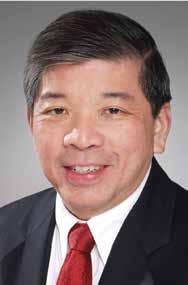
Thomas Chua Kee Seng was appointed as an NMP in 2014. 张松声于2009年受委为官委议员。


第 二 章
in
峥嵘岁月 时代印记 Chapter Two 123 122
Glorious Years: Leaving a Mark
History
Glorious Years: Leaving a Mark in History
军人节宣誓仪式
Singapore Armed Forces (SAF) Day
Combined Rededication Ceremony
S ince 2016, the Chamber and the Ministry of Defence have jointly held a Singapore Armed Forces (SAF) Day Combined Rededication Ceremony every year on 1 July. This annual event provides an opportunity to reaffirm employers’ commitment and support towards National Defence and recognise their contributions to the security of Singapore.
The Chamber organised the SAF Day Combined Rededication Ceremony in 2016. This picture depicts the Minister for Defence, Ng Eng Hen (right), and the then President of the Chamber, Thomas Chua

自 2016年起,总商会与国防部合作,在每年 7月1日举办“军人节集体宣誓仪式”。是日, 工商界、雇主及国民服役人员重申对国家的效忠, 以及对国防建设的全力支持,同时也肯定军人 保家卫国的贡献。
2016年,总商会举办军人节宣誓仪式。图为国防部长黄永宏(右)与时任总商会会长蔡其生(左)留影。
第 二 章
Kee Seng (left), taking a group photograph.
峥嵘岁月 时代印记 Chapter Two 125 124
军人节宣誓仪式: Singapore Armed Forces (SAF) Day Combined Rededication Ceremonies:





2017 2018 2019 2020 2021
第 二 章 Glorious Years: Leaving a Mark in History 峥嵘岁月 时代印记 Chapter Two 127 126
GIVING BACK TO SOCIETY

南洋大学
(1953至1980年) Nanyang University (1953–1980)
1953年1月21日,总商会召开董事会议响应福建 会馆主席陈六使提出兴办南洋大学的倡议。

总商会代表先后担任南大筹备委员会及南大执行 委员会的核心成员,并以总商会名义加入南大会员,
决议协助南大办理一切事宜,为建设中国之外 的第一所中文大学出钱出力。
南洋大学自1955年开学,至1980年与新加坡大学
合并成为新加坡国立大学,历时25年。这段期间,
总商会与南大风雨同舟,包括陈六使、李光前、
连瀛洲、高德根、陈锡九、黄祖耀等各届会长,
担任南大理事会主席,或捐献巨款,对这座肩负
华族文化传承和促进各民族交流的文化堡垒,
鼎力支持。南大为新加坡及区域内各国作育英才,
南大生学有所长,亦不吝于回馈社会和国家。
第 二 章 Glorious Years: Leaving a Mark in History 峥嵘岁月 时代印记 Chapter Two 131 130
On21 January 1953, in response to the proposal by Tan Lark Sye, the President of Hokkien Huay Kuan, to set up Nanyang University, the Chamber held a Council meeting. Representatives of the Chamber held offices as treasurer and secretary in the fundraising and executive committees of Nanyang University. The Chamber also joined the core members of Nanyang University to facilitate and execute the construction of the university. The Chamber contributed financial and material resources to build the first Chinese-medium university outside China.

Nanyang University, which lasted 25 years in history, was opened in 1955 and merged with
the University of Singapore to form the National University of Singapore in 1980. During this period, the Chamber went through thick and thin with Nanyang University. The Presidents of the Chamber, including Tan Lark Sye, Lee Kong Chian, Lien Ying Chow, Ko Teck Tin, Tan Siak Kew and Wee Cho Yaw, either served as the Chairman of Nanyang University or donated generously. They fully supported Nanyang University, an institution that has passed on the legacy of the Chinese culture and promoted interactions among all ethnic groups. Nanyang University has groomed various talents in different sectors in Singapore, and their graduates continuously give back to the society and country.
第 二 章 Glorious Years: Leaving a Mark in History 峥嵘岁月 时代印记 Chapter Two 133 132
新加坡中华总商会基金(1966年)
Singapore Chinese Chamber of Commerce Foundation (1966)
1 964年总商会新大厦落成后,董事会决议将
建设大厦所剩的余款成立“新加坡中华总商会
基金”,并于1966年1月27日完成注册,4月4日对外
公布。总商会基于“取之社会,用之社会”的宗旨, 透过产业委员会盈余及募捐方式来充实基金。
中华总商会基金的主旨在于推动教育、文化、
社区和慈善事业,为我国社会发展作出贡献,
并为孙中山南洋纪念馆筹募资金作修复和管理 之用。
总商会支持本地教育发展,其基金每年颁发奖
学金给学业表现优异的学生,至今已超过2,000人
受惠。为了促进种族和谐,总商会先后于2013年
和2015年与马来回教社区发展理事会及新加坡
1,500万作为大学奖学金基金,分别在本地五所
大学(新加坡国立大学、南洋理工大学、新加坡 管理大学、新加坡科技与设计大学及新加坡理工
大学)设立奖学金,资助本地大学生。
1970年代,新加坡中华总商会基金颁发奖学金典礼后留影。
A group photo taken after the Singapore Chinese Chamber of Commerce Foundation Scholarship Presentation Ceremony in the 1970s.

2016年,大学奖学金捐赠基金成立仪式。
Glorious Years: Leaving a Mark in History

印度人发展协会合作,共同颁发奖学金给友族
大学生。2016年总商会于110周年庆典上,捐款
The University Scholarship Endowment Fund Inauguration Ceremony in 2016.
第 二 章
峥嵘岁月 时代印记 Chapter Two 135 134
After the completion of the new Chamber building in 1964, the Council decided to establish the Singapore Chinese Chamber of Commerce Foundation with the remaining funds from the building construction. The foundation was incorporated on 27 January 1966 and announced on 4 April. The Chamber, based on the principle of “taking from the society, giving back to the society”, has been using the surplus from the Property Committee and other fundraising methods to fund the foundation.
The Singapore Chinese Chamber of Commerce Foundation aims to contribute to the community development of Singapore by promoting educational, cultural, community and charitable activities, including raising funds for the restoration and management of the Sun Yat Sen Nanyang Memorial Hall.
The Chamber supports the development of local education. Every year, the foundation awards
scholarships to local students with outstanding academic performance, benefitting more than 2,000 people. The Chamber worked with the Malay Muslim Community Development Council (MENDAKI) and Singapore Indian Development Association (SINDA) in 2013 and 2015 respectively to jointly award scholarships to students of other races to promote racial harmony. In 2016, during the Chamber’s 110th anniversary celebration, the Chamber established the $15 million Singapore Chinese Chamber of Commerce Foundation University Scholarship Endowment Fund for local university students. The scholarship was donated to five local universities, namely, National University of Singapore, Nanyang Technological University, Singapore Management University, Singapore University of Technology and Design and the Singapore Institute of Technology.
We actively invest in the society and education, providing subsidies for needy students, helping disadvantaged groups. As a century-old Chamber, it has always kept abreast of the times, never forgetting the motto of the Chamber and remembering the social responsibilities and roles the Chamber has to shoulder.
Roland Ng San Tiong, 59 th President of the Chamber, 2017
我们积极投入社会和教育事业,包括资助贫寒学生,扶助弱势群体等。
身为百年商会、世纪商团,总商会一直与时并进,不忘初心,
时刻牢记我们所肩负的社会责任和角色。
总商会第59届会长黄山忠,2017年
第 二 章 Glorious Years: Leaving a Mark in History 峥嵘岁月 时代印记 Chapter Two 137 136
日本占领时期死难人民纪念碑(1967年)
The Civilian War Memorial (1967)
日 本占领新加坡时期(1942至1945年),日军
在全岛进行大检证,制造无数冤魂。1962年, 樟宜、武吉知马等地相继发掘大批死难者遗骸。

总商会经商讨决议成立“日本占领时期死难人民
遗骸善后委员会”,负起探查、发掘和迁葬遗骨
的工作,并透过政府要求日本道歉及赔偿,追讨 迟来的正义,同时也建议政府设立“日本占领时期
死难人民纪念碑”告慰亡魂,警惕世人珍惜和平的代 价。
死难人民纪念碑座落在美芝路,碑高67米, 碑身由四根白色柱子组成,代表华族、马来族、
印度族以及欧亚裔四大族群的罹难同胞,支柱上方
During the Japanese Occupation of Singapore (1942–1945), the Japanese military police ( Kempeitai ) carried out Operation Sook Ching , resulting in the death of countless innocent civilians. In 1962, local workers discovered various mass graves containing thousands of human remains at Changi, Bukit Timah and other places. After an internal discussion, the Chamber formed the Disposal of Remains Committee to undertake the investigation and exhumation of the discovered war graves and reburial of the remains. The Chamber demanded for war compensation from Japan and sought justice for the innocent souls through the Singapore government. The Chamber also suggested to the Singapore government to construct the Memorial to the Civilian Victims of the Japanese Occupation, commonly known as the Civilian War Memorial, to seek justice for the innocent souls and remind people of the price of peace as well as to cherish the stability.
The Civilian War Memorial, comprising four columns at a height of 67 metres, is situated along Beach Road. The four columns signify people from the four main ethnic groups in Singapore who perished during the Japanese Occupation—Chinese, Malays, Indians and Eurasians. The convergence of the columns near the top represents the unity of all races and their shared suffering. The Civilian War Memorial sits on a raised platform enclosing a vault that holds the victims’ remains in 606 urns.
In 1985, the government set 15 February as Total Defence Day, marking the anniversary of the fall of Singapore on 15 February 1942, to raise awareness of being vigilant in times of peace and foster an understanding of national defence. Since 2009, the Chamber has partnered with Nexus (MINDEF) to organise the War Memorial Service, promoting national education. On 15 August 2013, the Civilian War Memorial was gazetted as a National Monument.
下方则埋有606名死难者遗骸的骨灰瓮。
采用连接设计,象征各族群团结一致、患难与共,
防卫意识。自2009年开始,死难人民祭礼由总商会 和国防部全面防卫与联系署共同举办,作为推广
列为国家古迹。 第 二 章 Glorious Years: Leaving a Mark in History 峥嵘岁月 时代印记 Chapter Two 139 138
1985年,政府宣布新加坡2月15日的沦陷日亦为 “全面防卫日”,以提醒国人居安思危,加强国民
国民教育的一环。2013年8月15日,这座纪念碑被
我们聚集在此不是为了战争补偿或煽动仇恨。
We meet not to rekindle old fires of hatred, nor to seek settlements for blood debts. We meet to remember the men and women who were the hapless victims of one of the fires of history.
建国总理李光耀,1967年
Lee Kuan Yew, founding Prime Minister, 1967
1967年2月15日,建国总理李光耀受邀主持纪念碑的落成暨开幕仪式。此后每年此日,总商会风雨不改地举办 祭礼,以庄严肃穆的仪式,悼念死难人民,祭奠先人的英灵。
On 15 February 1967, Lee Kuan Yew, the founding Prime Minister, unveiled the Civilian War Memorial. Since then, the Chamber has been holding the solemn War Memorial Service without fail to commemorate civilian victims and to honour the dead.

我们在此是要记住那些在战争期间牺牲的无辜受难者。
第 二 章 Glorious Years: Leaving a Mark in History 峥嵘岁月 时代印记 Chapter Two 141 140
在我们眼前的日本占领时期死难人民纪念碑,
见证我们多元文化的密切关系—
新加坡不同种族在二战时期团结和患难与共的精神。
The Civilian War Memorial which stands before us is testament to our multicultural ties—the four tapering columns symbolise the shared experiences and unity among the people of different races in Singapore during the war.

哈莉玛·雅各布总统,2018年
President Halimah Yacob, 2018
第 二 章 Glorious Years: Leaving a Mark in History 峥嵘岁月 时代印记 Chapter Two 143 142
孙中山南洋纪念馆(1996年)
Sun Yat Sen Nanyang Memorial Hall (1996)
晚 晴园落成于1902年,原名明珍庐。1905年 由本地潮商张永福购置这栋双层别墅供
母亲颐养天年,取名为“晚晴园”。当孙中山来到
新加坡宣传革命活动时,张永福征得母亲同意让 给孙中山居住。晚晴园因此成为孙中山在本地筹
划中国三次革命起义的秘密基地,最终更成为南 洋革命总机关。
后来晚晴园几经易手。1937年,本地六位华
商李光前、陈延谦、李振殿、周献瑞、李俊承和
杨吉兆合资购回,向南京国民政府请款修葺后对
Wan Qing Yuan was built in 1902 and its original name was Bin Chan House. In 1905, the Teochew businessman Teo Eng Hock bought the villa as a retirement home for his mother, and renamed it Wan Qing Yuan. When Sun Yat Sen came to Singapore to publicise his revolutionary activities, Teo Eng Hock received support from his mother to let Sun Yat Sen reside in Wan Qing Yuan. Thus, Wan Qing Yuan became Sun Yat Sen’s secret base in Nanyang for the preparation of the three revolutionary activities in China, eventually becoming the headquarters in Nanyang. Subsequently, Wan Qing Yuan has changed ownership several times. In 1937, six Chinese community leaders—Lee Kong Chian, Tan Ean Kiam, Lee Chin Tian, Chew Hean Swee, Lee Choon
Seng and Yeo Kiat Tiow—collectively purchased the estate and requested funds from the Nanjing
government to transform it into a memorial. Wan Qing Yuan was then placed under the care of the Chamber. In 1964, the Chamber revamped Wan Qing Yuan again to commemorate Sun Yat Sen. Two years later, it was renamed the Sun Yat Sen Villa.


外开放,并交由总商会托管。1964年,总商会再度 整修晚晴园,两年后变成“孙逸仙故居”。
第 二 章 Glorious Years: Leaving a Mark in History 峥嵘岁月 时代印记 Chapter Two 145 144
Wan Qing Yuan was gazetted as a National Monument in 1994. Two years later, Wan Qing Yuan was renamed the Sun Yat Sen Nanyang Memorial Hall. The Chamber set up the Sun Yat Sen Nanyang Memorial Hall Co., Ltd. to restore Wan Qing Yuan in 1997 and reopened it to the public in 2001. In 2009, the Chamber collaborated with the National Heritage Board (NHB) for the NHB to take over the management of Wan Qing Yuan to preserve it as a valuable historical heritage building. In 2011, Wan Qing Yuan underwent another phase of restoration. The new exhibition depicts the contributions of the locals in the 1911 Chinese Revolution as well as the formation of the first republic in Asia. It also actively promotes local national education.

晚晴园于1994年被新加坡政府指定为国家古 迹,两年后总商会将晚晴园更名为“孙中山南洋 纪念馆”。1997年,总商会成立孙中山南洋纪念馆 有限公司,修复扩建后晚晴园重新于2001年对外 开放。2009年,总商会进一步与国家文物局合作, 由国家文物局来管理,以保存珍贵的历史遗产。 2011年晚晴园再次完成翻新工程,新展厅以更 全面的视角来叙述本地支持者对中国辛亥革命、
建立第一个亚洲共和国的贡献。晚晴园亦积极 推广本地的国民教育。
2001年11月12日,时任内阁资政李光耀(左)主持晚晴园——孙中山南洋纪念馆的开幕典礼,右一为时任总商会会长郭令裕。
第 二 章 Glorious Years: Leaving a Mark in History 峥嵘岁月 时代印记 Chapter Two 147 146
Lee
Kuan Yew, the then Senior Minister (left), officiated the opening of the Sun Yat Sen Nanyang Memorial Hall on 12 November 2001. On the right was Kwek Leng Joo, the then President of the Chamber.
INNOVATION

151 150
世界华商大会(1991年)
World Chinese Entrepreneurs Convention (1991)

该会旨在建立一个全球商业网络平台,
总 商会于1991年8月首次举办世界华商大会,
让遍布世界的华商齐聚一堂,加强彼此的商业联
系。世界华商大会为双年会,由各地华商机构轮流 主办,是目前全球华商最具代表性的盛会。
总商会于2011年在新加坡举办第11届大会
时,为了进一步强化大会组织结构和定位,设计
永久会徽和会旗,以便永续发展。
世界华商大会已满30周年,如今已茁壮发展
成为一个跨国界、跨领域、规模庞大且具有影响力
The Chamber founded the World Chinese Entrepreneurs Convention (WCEC) in August 1991 to provide overseas Chinese entrepreneurs and business professionals an apolitical networking platform to strengthen economic cooperation and promote mutual understanding. The WCEC is a biennial event hosted by different Chinese Chamber organisations around the world and has become one of the most representative conventions of Chinese entrepreneurs around the world.
The Chamber designed a permanent logo and flag during the 11th WCEC hosted in Singapore to ensure the sustainability of the WCEC in 2011.
Thirty years after its inception, the WCEC is now recognised as a cross-border, cross-regional,
1991年8月,总商会首次举办世界华商大会,该会旨在建立一个全球商业网络平台,让遍布世界的华商齐聚一堂,加强彼此的商业联系。
The Chamber founded the WCEC in August 1991 to provide overseas Chinese entrepreneurs and business professionals an apolitical networking platform to strengthen economic cooperation and promote mutual understanding.
large-scale and influential communication platform.
world to strengthen their connections and discuss specific themes, laying the foundation for future cooperation. Glorious Years: Leaving a Mark in History 峥嵘岁月 时代印记 Chapter Two
的组织,为全球华商提供加强联系的平台、
契机。
共同探讨特定主题的场合,也为彼此创造合作的
The WCEC also provides a networking platform for Chinese business communities around the 第 二 章
整个世界建立在相互依赖的基础上,贸易、投资和旅行再也 不受海洋、高山或国界的阻碍。如今,新加坡人必须放眼国际。
海外的华人企业家将是在这些国家里很有用的联络人。民族、 文化的亲切感能促进联系和信任。海外的华人和其他亚洲人,
特别是印度人,可以协助新加坡人开拓海外市场。
Our world is increasingly interdependent. Trade, investments and travel are no longer impeded by oceans or mountains or national boundaries. Singaporeans now need to go international. Chinese entrepreneurs overseas will be valuable contacts in these countries. Ethnic and cultural empathy facilitates rapport and trust. Chinese and other Asians abroad, especially Indians, can help Singaporeans break into the markets abroad. 时任内阁资政李光耀,1991年
Lee Kuan Yew, then Senior Minister of Singapore, 1991

第 二 章 Glorious Years: Leaving a Mark in History 峥嵘岁月 时代印记 Chapter Two 153 152
The WCEC has been hosted in the following cities:
2005 首尔(南韩) Seoul (South Korea) 1993 香港 Hong Kong 2011 新加坡 Singapore 1999 墨尔本(澳大利亚) Melbourne (Australia) 2017 仰光(缅甸) Yangon (Myanmar) 2019 伦敦(英国) London (United Kingdom) 2007 神户和大阪(日本) Kobe & Osaka (Japan) 1995 曼谷(泰国) Bangkok (Thailand) 2013 成都(中国) Chengdu (China) 2001 南京(中国) Nanjing (China) 历届世界华商大会举办地:
2003 吉隆玻(马来西亚) Kuala
1991 新加坡 Singapore 2009 马尼拉(菲律宾) Manila (Philippines) 1997 温哥华(加拿大) Vancouver
2015 峇厘岛(印尼) Bali (Indonesia) 1 4 13 2 5 14 3 6 7 8 9 10 11 12 15 第 二 章 Glorious Years: Leaving a Mark in History 峥嵘岁月 时代印记 Chapter Two 155 154
Lumpur (Malaysia)
(Canada)
Abolishing the Clan-Based Election System (1993)
孙炳炎成立“修改章程小组”,却因部份条文无法
达成协议而搁置。
1993年,总商会在郭令裕会长的带领下完成修
由不同帮推选轮流担任,避免特定帮群长期垄断 商会领导层的局面。
过去总商会曾多次检讨分帮选举制的利弊。
早在1920年代,陈嘉庚曾在《南洋商报》发表他
对帮群制的改革期许。1939年,第22届会长李光前
提出修章废除分帮选举的规定,因部分董事反
对而作罢。1950年代,不少董事和会员都提出废除
分帮选举的制度,但始终无法达成共识。废除帮
群论争在1965年至1968年间进入高峰,时任会长
章,终结这一场超过半个世纪的争论。至此,总商会
沿用了87年之久的分帮选制度正式走入历史。此
前,总商会的董事习惯使用各自的方言交流,取
消分帮制度后,大家打破祖籍的划分,统一使用
华文华语,增强总商会的凝聚力,共同因应时代
变化。
总商会适时废除不符合潮流的陈规,说明它的 进取性格和求变精神,积极将组织打造成现代化、
高效率和专业化的机构。
When the Chamber was established, the Council adopted a clan-based election system to ensure that the five dialect groups are represented proportionally in the Committee. Representatives from different dialect groups took turns to hold the post of President, preventing the monopolisation of leadership by any specific dialect group. Over the years, the Chamber repeatedly reviewed the pros and cons of this clan-based election. In the early 1920s, Tan Kah Kee voiced his reservations against the clan-based election in a Nanyang Siang Pau article. In 1939, Lee Kong Chian, the 22nd President of the Chamber, suggested amending the Chamber’s Rules to abolish the clan-based election. However, this was met with objections from several Council Members. In the 1950s, many Council Members resurrected the idea of abolishing the clan-based system but to little effect. The debate intensified between 1965 and 1968. Soon Peng Yam, the then President of the Chamber, headed the Special Review Committee but still failed to reach a consensus.
In 1993, under the leadership of President Kwek Leng Joo, the Chamber amended the Rules and settled the debate after more than half a century. Finally, the 87-year chapter of the clan-based election system was relegated to the Chamber’s history. The Council Members used to communicate in their dialects, but after the clan-based election was abolished, they prescribed the use of Mandarin to break away from clan divisions, fostering stronger ties among the Council Members and changing with times.
The Chamber abolished a system that did not fit the zeitgeist, highlighting that the Chamber is highly motivated to seek and adapt to new changes. This helped the Chamber to transform into a modern, efficient and professional organisation.
In 1993, the Chamber held an Extraordinary General Meeting to abolish the clan-based election system.

修章废除分帮选举制度(1993年)
1993年,总商会召开特别会员大会,废除分帮选举制度。
总
商会成立时,董事会采取分帮(方言群) 选举制度,按照帮群人数来分配比例代表,
以确保五大帮群都有代表进入董事会。每届会长
第 二 章 Glorious Years: Leaving a Mark in History 峥嵘岁月 时代印记 Chapter Two 157 156
Kwek Leng Joo
时任总商会会长,1993年

Then President of the Chamber, 1993
No matter which dialect group you come from, we are all Singaporean Chinese! In putting aside minor differences to seek a common ground, racial unity becomes the mission of our generation.
无论你是来自华社的哪一个族群,我们都是 新加坡华人! 求同存异、民族团结是我们 这一代人的历史使命。
郭令裕
第 二 章 Glorious Years: Leaving a Mark in History 峥嵘岁月 时代印记 Chapter Two 159 158
161 160
新加坡中华总商会事业女性组 (1994年)
The SCCCI Career Women’s Group (1994)
1994年7月,在时任总商会会长郭令裕的领导下, 责成张齐娥成立“新加坡中华总商会事业 女性组”。次年,张齐娥与颜诗琴博士双双当选为
总商会第48届董事,打破总商会一贯以男性出任 董事的局面,为总商会注入清新气息。
事业女性组成立以来,举办各类经贸及社交活动, 并组织代表团与其他国外妇女团体及机构交流,
促进跨国企业合作。自2004年开始,事业女性组
亦以联谊晚会形式每年为会员举办国际三八妇女 节庆祝活动。
事业女性组的成立,提供本地职业女性一个
相互交流与学习的新平台,同时也广纳具有影响
力的成功女性,共同参与公益、回馈社会,为国家 的发展作出贡献。
In July 1994, under the leadership of Kwek Leng Joo, the then President of the Chamber, Claire Chiang set up the SCCCI Career Women’s Group. In the subsequent year, Claire Chiang and Gan See Khem were voted into the 48th Council, breaking the long-standing tradition of a male-exclusive Council and injecting new talents into the Council.

Since its establishment, the SCCCI Career Women’s Group has constantly organised various economic, trade and social activities. It has also organised small delegation groups to interact with women representatives from overseas groups and institutions to strengthen cooperation with multinational corporations. Since 2004, the SCCCI Career Women’s Group has been organising
1994年,总商会主办研讨会探讨事业女性在总商会的挑战与机会。
The Chamber organised a workshop to analyse the challenges and opportunities women in the Chamber faced in 1994.
International Women’s Day networking conferences for its members.
and communicate. Meanwhile, it also congregates influential and successful career women to play a part in giving back to society and contribute to the development of the country. Glorious Years: Leaving a Mark in History 峥嵘岁月 时代印记 Chapter Two
The SCCCI Career Women’s Group creates a new networking platform for career women to learn 第 二 章


2019年,总商会庆祝国际妇女节暨新加坡中华总商会事业女性组25周年。 The Chamber celebrated International Women’s Day and the 25th anniversary of the SCCCI Career Women’s Group in 2019. Iridescent 25 A Commemorative Publication of SCCCI Career Women’s Group 新加坡中华总商会事业女性组25周年纪念刊 Iridescent 25 1994 – 2019 第 二 章 Glorious Years: Leaving a Mark in History 峥嵘岁月 时代印记 Chapter Two 163 162
165 164
新加坡中华总商会管理学院(1996年)
The Singapore Chinese Chamber Institute of Business (1996)
首设微型电脑中心,为会员提供电脑课程。
为 了因应电脑时代的来临,总商会于1981年
1984年,总商会进一步配合政府的人力政策,
成立培训中心推广现代科技的应用,协助 会员及企业提高生产力与管理技能。中心成立 第一年,就有超过3,000人前来接受语言、工商 管理及电脑系统的培训课程。
1996年,总商会将培训中心升格为管理学院, 作为一所专业的教育机构。管理学院配合商界的
需求,在管理培训、语言文化、技能提升等三大
领域推出新课程,透过丰富的内容,协助企业提升 员工的素质、技能及生产力。同时,管理学院也
倡导中华文化的传承。2018年,管理学院获中国 孔子学院总部暨国家汉办委任,成为新加坡唯一 的商务汉语考试中心。
此外,总商会管理学院亦与政府合作开发一系
With the advent of the digital age, the Chamber established the Micro Computer Centre in 1981 to equip its members with computer skills. In 1984, the Chamber further cooperated with the government’s labour policies and founded the Singapore Chinese Chamber Training Centre to assist members and enterprises in increasing their productivity and improving their business management skills. In the first year of the centre’s founding, more than 3,000 people received language, business management and computer skills upgrading courses.
in three areas: business management, language and culture, and skills upgrading. Through its various diversified and quality courses, the SCCIOB continuously assists local businesses to upgrade the skills of the employees, improve productivity and promote the Chinese cultural legacy. In 2018, the Hanban/Confucius Institute Headquarters appointed the SCCIOB as the sole Business Chinese Test (BCT) Centre in Singapore. The SCCIOB also collaborated with the government to launch a series of courses for skills upgrading. These courses equip entrepreneurs and senior management personnel with business management and digitalisation skills, improve work processes as well as enhance the overall expertise of individual businesspeople and the business community. Glorious Years: Leaving a Mark in History 峥嵘岁月 时代印记 Chapter Two
列技能提升课程,协助企业家及企业管理人面对
经济转型、提升经营理念、掌握现代科技、改善 工作流程,进而提高个人及商界整体的素质。
In 1996, the Chamber upgraded its training centre to the Singapore Chinese Chamber Institute of Business (SCCIOB). As a professional educational organisation, it adapts to the needs of the business community and continuously launches new courses 第 二 章
1996年,时任总商会会长郭令裕(中)与新加坡国立大学和南洋理工大学签署备忘录,为管理学院提供密集培训课程。
Kwek Leng Joo, the then President of the Chamber, signing MOUs with the National University of Singapore and Nanyang Technological University to provide intensive training courses for the Singapore Chinese Chamber Institute of Business in 1996.

Ng Cher Pong, the then Chief Executive of SkillsFuture (second from the left), and Roland Ng, the President of the Chamber (third from the right), at the opening of the Business Chinese Test Centre in 2018.

2016年,时任教育部代部长(高等教育及 技能)兼国防部高级政务部长王乙康参观 新加坡中华总商会管理学院。
Ong Ye Kung, the then Acting Minister for Education (Higher Education and Skills) and Senior Minister of State for Defence, Ministry of Defence, visited the Singapore Chinese Chamber Institute of Business in 2016.

2018年,时任精深技能发展局局长黄子鹏 (左二)和总商会会长黄山忠(右三) 为商务汉语考试中心主持开幕。
第 二 章 Glorious Years: Leaving a Mark in History 峥嵘岁月 时代印记 Chapter Two 167 166
CHAPTER THREE

第三章
丹戎巴葛(1890年代)
Tanjong Pagar (the 1890s)
华商精神 薪火相传 Passing on the Chinese Entrepreneurial Spirit Legacy
保存出一份力;迈入21世纪,总商会先后成立通
商中国,在中国设立上海代表处、新加坡进口馆, 促进新中经贸关系。
总商会在过去20年也先后举办百年庆典、建国 50、110周年庆等活动。本章再以60届董事会为
分界点,说明总商会准备迈入下一新篇章。 ❖
新加坡和中国辛亥革命的历史,也为国家古迹
This chapter records the major Chinese and English news events of the Chamber in the past 20 years.
Through these media reports, the reader can draw, from both the headlines and content, the close relationship between Singapore’s development and the Chamber’s growth.
For example, in the 1990s, the Chamber renovated Wan Qing Yuan, connecting the history of Singapore and the 1911 Revolution in China. In doing so, it played a part in contributing to the preservation of a National
Monument in Singapore. In the 21st century, the Chamber has successively established Business China, the Shanghai Representative Office and the Singapore Import Pavilion in China, which are focused on promoting Singapore-China economic relations.
In the past 20 years, the Chamber also organised various celebrations to mark its centennial, SG50, and its 110th anniversary. This chapter uses the 60th Council as the dividing line, showing the Chamber’s readiness in entering a new chapter. ❖
本 章选录总商会近20年来重大新闻报道
社会事件,读者可以从新闻的标题和内容捕抓到 时代的足迹,这些报道正好说明了总商会和新加坡 的国家发展息息相关。 例如,1990年代总商会重新整修晚晴园,连接起
的中英文报章。新闻媒体记录了重要





由晚晴园修复成 的孙中山南洋纪念馆, 记录了孙中山在 东南亚的活动,以及 本地社群对他的 革命事业的参与和支 持。这些努力促 成了腐败的满清王朝 的垮台和中华民国的 成立。 投入 万元 扩建与修复晚晴园 年历史 纪念馆的建立, 是新加坡历史演变 的自然结果,它和 一个现代新加坡的 产生息息相关。 第 三 章
华商精神 薪火相传 Chapter Three 173 172 2 0 0 1 2 0 0 1
Passing on the Chinese Entrepreneurial Spirit Legacy
The restored and expanded Sun Yat Sen Villa in Balestier Road now joins 43 other national monuments, which reflect Singapore’s multi-racial and multi-cultural society.







第 三 章 Passing on the Chinese Entrepreneurial Spirit Legacy 华商精神 薪火相传 Chapter Three 175 174 2 0 0 6 2 0 0 1
Mr Lee expressed confidence that ‘the same indomitable and pioneering spirit’ will see the Chamber through the next century.




120 trade associations and
4,000 businesses and professionals as members

第 三 章 Passing on the Chinese Entrepreneurial Spirit Legacy 华商精神 薪火相传 Chapter Three 177 176 2 0 0 6 2 0 0 6










通商中国使两国在
的双向交流方面 多一道助力。 第 三 章
经济和文化领域
华商精神 薪火相传 Chapter Three 179 178 2 0 0 7 2 0 0 7
Passing on the Chinese Entrepreneurial Spirit Legacy
The new office in Shanghai will play matchmaker to Chinese and Singapore companies keen to invest in the other’s country and acting as a catalyst for joint venture projects.









为了协助本地企业 到中国发展, 总商会在上海设立 代表处,建立会员商家
在中国的交流站。
第 三 章 Passing on the Chinese Entrepreneurial Spirit Legacy 华商精神 薪火相传 Chapter Three 181 180 2 0 1 0 2 0 1 0







第 三 章 Passing on
华商精神 薪火相传 Chapter Three 183 182 2 0 1 1 2 0 1 1
the Chinese Entrepreneurial Spirit Legacy









第 三 章 Passing on the
华商精神 薪火相传 Chapter Three 185 184 2 0 1 1 2 0 1 1
Chinese Entrepreneurial Spirit Legacy





总商会举办这两大活动, 是为了表彰与肯定建国 华商用于开拓的魄力与 崇高的奉献精神,以及呈 现总商会自建国酝酿期 以来所扮演的角色。
第 三 章 Passing on the Chinese Entrepreneurial Spirit Legacy 华商精神 薪火相传 Chapter Three 187 186 2 0 1 5 2 0 1 5
总商会以华商精神为出发点, 目的是希望通过这种方式,让精诚团结、 不畏逆境的新加坡精神代代相传。
The winners were a representation of the larger Singapore Chinese business community that had contributed to Singapore’s development.




第 三 章 Passing on the Chinese Entrepreneurial Spirit Legacy 华商精神 薪火相传 Chapter Three 189 188 2 0 1 5 2 0 1 5
Singapore’s future is the future of the Chamber.




第 三 章 Passing on the Chinese Entrepreneurial Spirit Legacy 华商精神 薪火相传 Chapter Three 191 190 2 0 1 5 2 0 1 5
The Chamber is committed to grooming the younger generation, passing on the Chinese Entrepreneurial Spirit.




作出贡献。 第 三 章 Passing on the Chinese Entrepreneurial Spirit Legacy 华商精神 薪火相传 Chapter Three 193 192 2 0 1 6 2 0 1 6
总商会继续与时并进,
聚商惠民,推陈出新为 华商、华社服务,同时 积极回馈社会,为促进
国家发展和社会和谐
By Yuen Sin yuensin@sph.com.sg
Singapore
MORE than 20 trade associations are set to collaborate more closely in the national push to grow companies and help them venture overseas, with the launch of the new Trade Association
Hub in Jurong on Wednesday morning.
The refurbished space, which was officially opened by Prime Minister Lee Hsien Loong, contains shared facilities that associations can use to reduce operating costs, including meeting and training areas available on a pay-per-use basis.

At the opening ceremony, PM Lee said that the hub is “not just brick and mortar space”. “It will also help build stronger TAC (Trade Association and Chambers) community, and cultivate a culture of mutual support and collaboration,” he said. The 25 tenants that moved in earlier this year include anchor tenant Singapore Chinese Chamber of Commerce and Industry (SCCCI), the Singapore Food Manufacturers’ Association (SFMA) and Kranji Countryside Association (KCA). The hub was mooted by the SCCCI in 2014.
Thomas Pek, president of SFMA, said that moving operations from their headquarters in Chinatown to the TA Hub in Jurong has helped the
association – which has more than 400 members including brands such as Bee Cheng Hiang to source for new technological solutions.
For example, it was able to partner another tenant at the hub, the Landscape Industry Association (Singapore), to sign a Memorandum of Understanding two months ago with the Waste Management and Recycling Association of Singapore. They will explore how they can share technologies for converting waste into compost and recycling by-products. “We also hope to look for new overseas markets or business partners when the TA Hub hosts trade exhibitions or foreign visitors,” Mr Pek said.
In his speech, PM Lee underlined the important role that the more than 300 TACs in Singapore play. They are “aggregators and multipliers” in the business eco-system, he said. “You are close to the companies, and understand the needs of your industries well. You support small and medium enterprises to overcome the limitations of size by working together, and doing things that would otherwise be difficult for a single company to do alone.”
He added that he hoped to see TACs work together to help Singapore companies venture overseas, and expand their global footprint.
The TA Hub occupies the premises of the 43-year-old Jurong

Town Hall building, which was gazetted as national monument in 2015.
It was formerly the headquarters of the Jurong Town Corporation, and was renamed the iHUB in 2004, serving as an office space for local technology startup companies.
Restoration works in the Jurong Town Hall building started in early 2016 and were completed early this year. The building, which has six levels, has 7,500 sq m of space for trade association offices and almost 5,000 sq m of shared facilities. About half of the space for offices has been occupied, with rental rates at S$32
per sq m. Besides the new hub, the SCCCI will also lead a Trade Association Committee, which includes members from 12 other trade associations and chambers.



It hopes to drive the development of TACs so that they can better work with their members to address industry challenges.
By Annabeth Leow leowhma@sph.com.sg
@AnnabethLeowBT
Singapore
THERE’S no need for MyRepublic to ask who’s on the other end of the line this time: The telecommunications company has picked up a lead investor in its latest funding round.
The injection of S$70 million from financial services firm Makara Capital, announced on Wednesday, will “push the gas” on the telco’s business growth plans, says its chief executive Malcolm Rodrigues also gave an update on the company’s planned consumer mobile services roll-out and public listing.
Makara Capital chief executive and co-founder Ali Ijaz Ahmad told media briefing that his firm was tak-
ing “a substantial stake” in MyRepublic and has not ruled out chipping in again if the investment pans out well.
Makara’s director of investments Kelvin Tan said in a statement that the capital will have “a focus on (intellectual property) management and monetisation, scaling and expansion”.
MyRepublic had kicked off its Series C fund-raising round earlier this year, with an original target of S$100 million, but Mr Rodrigues said that he will now set his sights higher.
The fund-raising could yield “at least S$150 million”, he noted. “It looks like we’ll be fortunate enough to go beyond the S$100 million in terms of the money that we can tap into, and we’ll use that to accelerate our business.”
Mr Rodrigues said that the cash
from the billion-dollar Makara Innovation Fund will “effectively triple the business over the next few years and drive the valuation further”.
“The use of proceeds fundamentally is around growing our consumer business, growing our enterprise business in our four markets, and as well investing in the platform to drive the capability for our growth.”
MyRepublic now operates in Singapore, Indonesia, New Zealand and Australia; it also wants to grow in South-east Asia, and hopes to expand into markets like Myanmar, Thailand, Vietnam and the Philippines.
Mr Rodrigues also said the move would “supercharge” the development of the company’s proprietary cloud platform, which he credited with enabling growth in new markets.
Separately, the “telcotech” player
confirmed that it is eyeing the first quarter of next year for a roll-out of consumer mobile services here, by way of a deal with telecom incumbent.

Last year, MyRepublic lost out to Australia’s TPG Telecom in the contest to be Singapore’s fourth telco. The upcoming launch of its consumer mobile services will be through a mobile virtual network operator (MVNO) tie-up with local telco, which it declined to name at this stage.
The MVNO model entails leasing another company’s capacity like how service provider Circles.Life has partnered M1.
Mr Rodrigues reiterated that MyRepublic is on track to list in the next 18 months: “With Makara taking the lead, with some follow-up investors, we expect to be oversubscribed.”
“We expect that the autonomous vehicles will greatly enhance the accessibility and connectivity of our public transport system, particularly for the elderly, families with young children, and the less mobile. More the development of the technology, but how we can safely incorporate it into our living environment, through appropriate regulations and town planning.” He said autonomous vehicle (AV) The test centre was jointly developed by NTU, LTA and JTC, as part of the Centre of Excellence for Testing & Research of AVs NTU (Cetran), which was launched in August 2016. Mr Khaw said it would provide a
tops
S$70m
Driverless buses to be tested in 3 new towns from 2022 MyRepublic says it will go into a mobile virtual network operator tie-up with a local telco to launch its consumer mobile services. It declined to name its local telco partner for now. BT FILE PHOTO The new Trade Association Hub was officially opened by Prime Minister Lee Hsien Loong on Wednesday morning. It contains shared facilities that associations can use to reduce operating costs. BT PHOTO: KELVIN CHNG They will run in Punggol, Tengah and the Jurong Innovation District during off-peak hours 2 | TOPSTORIES TheBusinessTimes|Thursday,November23,2017
the
closely in the national push to
companies and
firms of different sizes The Chamber represents 第 三 章 Passing on the Chinese Entrepreneurial Spirit Legacy 华商精神 薪火相传 Chapter Three 197 196 2 0 1 7 2 0 1 7
MyRepublic
up
war chest; sets Q1 2018 for mobile launch
With
launch
of the
new Trade Association (TA) Hub, more than 20 trade associations
are
set
to collaborate more
grow
help them venture overseas. 40,000
管好我们的家族和企业,才能国际化、闯天下。
The Chinese Entrepreneurs

Cultural Fund aims to promote the ‘Chinese Entrepreneurial Spirit’.




要修身、齐家,一定要从华商精神做起,做好我们的本分,
2 0 1 9 2 0 1 9 第 三 章 Passing on the Chinese Entrepreneurial Spirit Legacy 华商精神 薪火相传 Chapter Three 199 198
总商会经过一个世纪后作出改革董事




任期的决策,是为了让总商会的决策规划 和长远发展更有延续性和稳定性。

2 0 1 9 2 0 1 9 第 三 章
华商精神 薪火相传 Chapter Three 201 200
Passing on the Chinese Entrepreneurial Spirit Legacy
总商会协助新加坡商家把握最有经济效益的线上与线

下推广方式,通过设立在上海、成都与重庆的三个办
事处为新加坡品牌提供一站式的服务,以便协助新加

坡品牌抓紧中国市场蓬勃发展的机遇,扬名海外。

2 0 2 1 2 0 2 1 第 三 章 Passing on the Chinese Entrepreneurial Spirit Legacy 华商精神 薪火相传 Chapter Three 203 202
The Chamber launched its 36-page e-book, The Story of the Civilian War Memorial , containing brief information on how the memorial was erected and some stories of the war.







2 0 2 1 2 0 2 1 第 三 章 Passing on the Chinese Entrepreneurial Spirit Legacy 华商精神 薪火相传 Chapter Three 205 204
Singapore River (1900)

结语
CONCLUSION 新加坡河景(1900年)
发挥诚信、效忠、回馈和创新的华商
过 去百余年来,总商会始终秉持创会宗旨,
精神,对新加坡的政治、经济、社会和文化的发展
作出贡献,产生社会影响力,持续至今。
本书以�华商精神 生生不息” 为主题,带领读者
认识总商会创会以来的会长。历届会长如何身体力行
华商精神的信念,与董事会一起来协助会员商家
克服不同时代的困难与挑战。
本书也以总商会重大事件和新闻剪报方式,让
读者进一步了解总商会华商精神故事。每一个
华商精神故事,可以让年轻的国人明白华商先贤
走过的路。 未来,新一代的新加坡华商,可以在总商会华商
精神的根基上,承前启后,以更坚定的信心勇往
直前,为国家的永续发展和社会进步与繁华奉献
心力。 ❖
Over the past hundred years, the Chamber has always adhered to its mission and upheld the Chinese Entrepreneurial Spirit, namely Integrity, Loyalty, Giving back to society, and Innovation. The Chamber has played an important role in the political, economic, societal and cultural arena and has gained social influence that continues to this day.
Through the theme of “the Unwavering Force of Chinese Entrepreneurial Spirit”, this publication enables readers to learn about the Chamber’s Presidents since its establishment. It also allows the readers to understand ways the Presidents and Council Members have upheld the Chinese Entrepreneurial Spirit while helping the members to overcome the challenges of the different times.
The publication is based on the Chamber’s major events and newspaper clippings, to allow readers to understand the story of the Chamber Chinese Entrepreneurial Spirit. Each story of the Chinese Entrepreneurial Spirit allows the younger generation to understand the road that our forefathers have been through.
In the future, by building on the Chamber Chinese Entrepreneurial Spirit, a new generation of Singaporean Chinese businessmen will be able to forge ahead with stronger confidence and contribute to the sustainable development, social progress and prosperity of the country. ❖
结语
Conclusion
THE 60 TH SCCCI COUNCIL
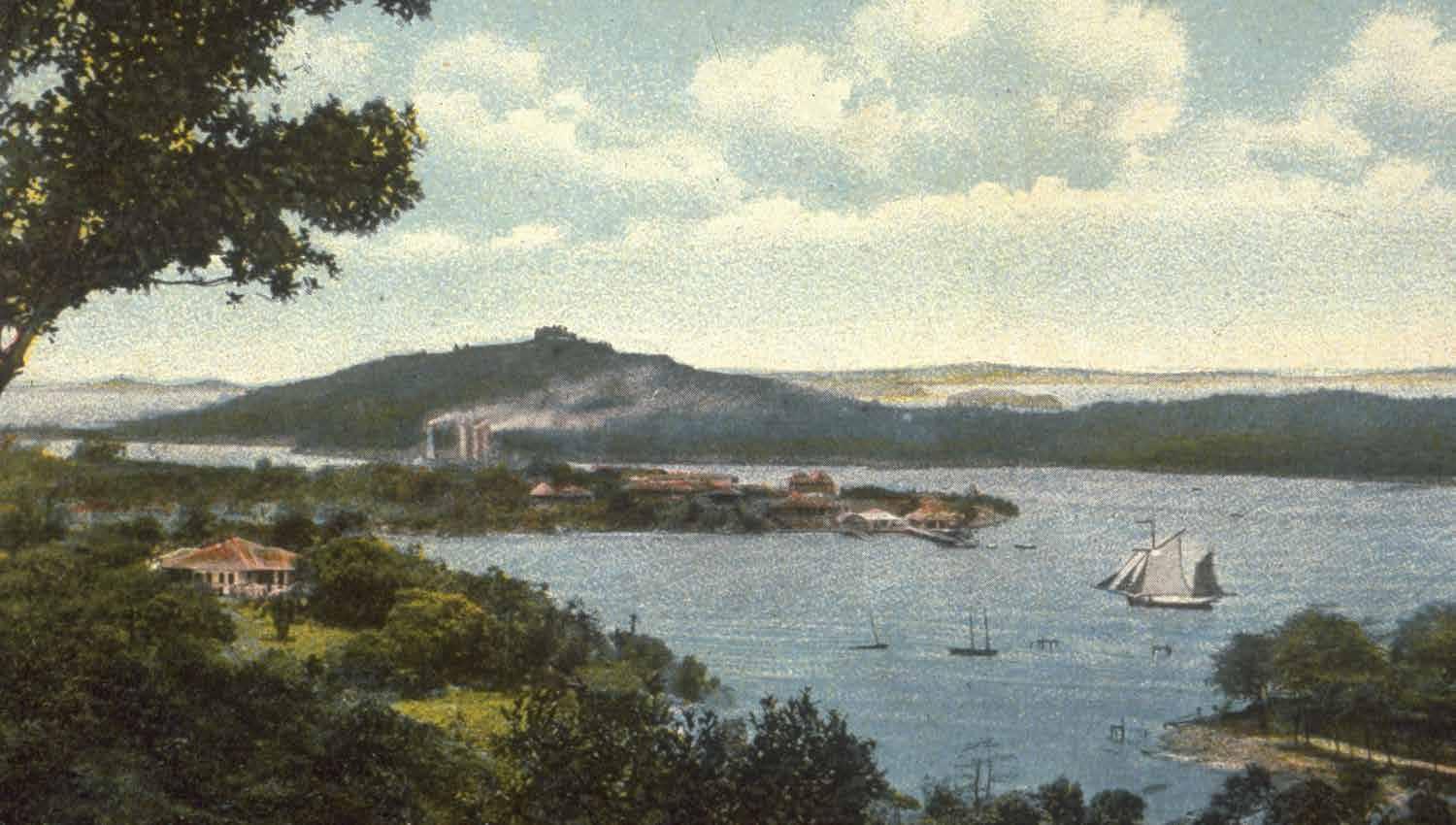
第六十届董事会
岌巴港(1900年代) Keppel Harbour (the 1900s)

2019年,新加坡中华总商会第60届董事合影。
A group photograph of the Chamber's 60 th Council in 2019.





 President Roland Ng San Tiong
President Roland Ng San Tiong
副会长 柯文伟 Vice-President
副会长 白连源 Vice-President
副会长 何乃全 Vice-President
第六十届董事会 THE 60 TH SCCCI COUNCIL 2019年3月15日至2022年3月15日 15 MARCH 2019 TO 15 MARCH 2022 The 60 th SCCCI Council 215
Immediate Past President Thomas Chua Kee Seng
Kuah Boon Wee
Pek Lian Guan
Charles Ho Nai Chuen
总务委员会主席 白毅柏
Chairman, General Affairs Committee
Pek Ee Perh Thomas
财政委员会主席 吴绍均
Chairman, Finance Committee
Ng Siew Quan
文教与社会事务委员会主席 白南泉
Chairman, Culture, Education & Community Affairs Committee
Adrian Peh Nam Chuan





商团与会员事务委员会主席 陈睦发
Chairman, Trade Association & Membership Affairs Committee
Tan Bock Huat
工商业委员会主席 李坚辉
Chairman, Commerce & Industry Committee
Mark Lee Kean Phi
产业委员会主席 高泉庆
Chairman, Property Management Committee
青年商务委员会主席 郭益智
Chairman, Youth Business Affairs Committee
总务委员会副主席 吕立岩
Vice-Chairman, General Affairs Committee
研究与出版委员会主席
谢锦发
Chairman, Research & Publications Committee
Chia Kim Huat

外事委员会主席
陈康威
Chairman, External Relations Committee
Anthony Tan Kang Uei


科技委员会主席
黄建铭
Chairman, Technology Committee
Ang Kiam Meng
国际事务委员会主席
翁温钊
Chairman, International Affairs Committee

Edward Ang Boon Cheow
Vice-Chairperson, Finance Committee
Ang Fung Fung
Kho Choon Keng
Sherman Kwek Eik Tse
Paul Loo Lip Giam 财政委员会副主席
文教与社会事务委员会副主席
Vice-Chairperson, Culture, Education & Community Affairs Committee
Hwang Yee Cheau



文教与社会事务委员会副主席 邬春玲
Vice-Chairperson, Culture, Education & Community Affairs Committee
Voo Choon Ling
Vice-Chairman, Trade Association & Membership Affairs Committee
James Ow Chin Seng




洪芳芳
黄亦巧
商团与会员事务委员会副主席 胡进胜
The 60 th SCCCI Council 第六十届董事会 217 216
Vice-Chairman, Trade Association & Membership Affairs Committee
Simon Goh Lian Seah
商团与会员事务委员会副主席 陈树生
Vice-Chairman, Trade Association & Membership Affairs Committee
Allan Tan Soo Seng







商团与会员事务委员会副主席
Vice-Chairman, Trade Association & Membership Affairs Committee
Lim Chin Keong





研究与出版委员会副主席
Vice-Chairman, Research & Publication Committee
Zhou Zhao Cheng



Vice-Chairman, International Affairs Committee
Keith Tan Keng Soon
Vice-Chairman, Commerce & Industry Committee
Philip Kia Er Chew
Vice-Chairman, Commerce & Industry Committee
Tew Koon Huat
Vice-Chairman, Property Management Committee
Chia Chor Meng
Vice-Chairman, External Relations Committee
Tan Choon Boon
科技委员会副主席 颜毓瑩
Vice-Chairperson, Technology Committee
Annie Gan Giok Em
国际事务委员会副主席
梁善权
Vice-Chairman, International Affairs Committee
Chris Leong Sin Kuen
国际事务委员会副主席 黄保华
Vice-Chairman, International Affairs Committee
Ng Poh Wah
Vice-Chairman, Youth Business Affairs Committee
Wong Chee Herng
Vice-Chairman, Youth Business Affairs Committee
Ken Koh Kien Chon

Council Member
Wu Hsioh
Council Member
Zhong Sheng Jian
国际事务委员会副主席 陈庆顺
工商业委员会副主席 程宇超
工商业委员会副主席 张群发
产业委员会副主席 谢楚明
青年商务委员会副主席 黄志恒
青年商务委员会副主席 辜健聪
董事 吴学光
Kwang 董事 钟声坚
商团与会员事务委员会副主席 吴令声
林振强
周兆呈
外事委员会副主席 陈俊文
The 60 th SCCCI Council 第六十届董事会 219 218
Council Member
Tay Khiam Back
Council Member Lee Sze Leong
Council Member Patrick Ng


Council Member Chan Hian Siang

Council Member Lim Geok Khoon

Council Member Yeo Hiang Meng

Council Member Ted Ngo Soo Lin





Council Member Tan Aik Hock

Council Member
John Lim Hwee Chiang
Council Member
Lim Hock Chee



Council Member Pang Lim


Council Member
Francis Ko Oon Joo
Council Member
Ernie Koh Jyh Eng
Council Member
Michael Lim Ah Poh
Council Member
Ong Chu Poh
Council Member
Koh Wee Seng
董事 郑谦木
董事 李思亮
董事 黄健华
董事 曾憲相
董事 林惠璋
董事 林福星
董事 庞琳
董事 高允裕
董事 林玉勤
董事 杨向明
董事 吴斯仁
董事 陈奕福
董事 许志恩
董事 林亚保
董事
王再保
董事 许伟盛
The 60 th SCCCI Council 第六十届董事会 221 220



董事 林日耀 Council Member Jeremy Lim Jit Yaw 董事 石慧宁 Council Member Michelle Cheo Hui Ning 第六十届董事会 222
THE 61 ST SCCCI COUNCIL

PRESIDENT, IMMEDIATE PAST PRESIDENT, AND VICE-PRESIDENTS
2022年3月15日至2025年3月15日




15 MARCH 2022 TO 15 MARCH 2025

President Kho
Immediate
President Roland
副会长 李思亮 Vice-President Lee Sze Leong 副会长 林福星 Vice-President Lim Hock Chee 常务副会长 吴绍均 First Vice-President Ng Siew Quan
Choon Keng
Past
Ng San Tiong
第六十一届董事会 会长、前任会长、副会长
225 The 61 st SCCCI Council
华商精神 生生不息
THE UNWAVERING FORCE OF CHINESE ENTREPRENEURIAL SPIRIT

新加坡河哥烈码头(1902年)
致谢
View Of Collyer Quay (1902)
ACKNOWLEDGEMENTS
新加坡中华总商会华商文化基金衷心感谢以下机构及相关人士的支持:
The SCCCI Chinese Entrepreneurial Culture Foundation would like to express its appreciation to the following organisations and individuals for their support in the production of this publication:
新加坡中华总商会华商文化基金首届董事会 (2019年至2022年)
Inaugural SCCCI Chinese Entrepreneurial Culture Foundation Board (2019–2022)

文化捐献配对基金
新加坡国家档案馆 National Archives of Singapore 新加坡报业控股 Singapore Press Holdings Media Limited
尹崇明 Wan Shung Ming
邬春玲 Voo Choon Ling
陈志锐博士 Dr Tan Chee Lay
李秉蘐博士 Dr Lee Peng Shu
杨修灏家属 Family of Yong Siew Hong
周兆呈博士 Dr Zhou Zhao Cheng 徐祖燊 Chui Choon Sin
黄亦巧医生 Dr Hwang Yee Cheau
姓名按笔画排序。
同时感谢各界人士对本书的鼎立支持
And to everyone who has supported this publication.
主席 Chairman 黄山忠 Roland Ng San Tiong
委员 Members 蔡其生 Thomas Chua Kee Seng
吴学光 Wu Hsioh Kwang 白南泉 Adrian Peh Nam Chuan
刘泰山 Lau Tai San
白连源 Pek Lian Guan
吴绍均 Ng Siew Quan
高泉庆
Kho Choon Keng
The order of the names is based on the number of strokes of the Chinese characters.
Acknowledgements 致谢 231 230
总商会大厦装修小组 Building Renovation Advisory Panel
顾问 Advisor
黄山忠 Roland Ng San Tiong
主席 Chairman
林惠璋 John Lim Hwee Chiang
委员 Members
高泉庆 Kho Choon Keng
李思亮 Lee Sze Leong
何培斌博士 Dr Ho Puay Peng
张东孝 Daniel Teo Tong How
杨茳善副博士 Dr Yeo Kang Shua
华商精神 生生不息 ——
新加坡中华总商会百年华章
The Unwavering Force of Chinese Entrepreneurial Spirit — A Centennial History of the Singapore Chinese Chamber of Commerce & Industry
出版 Publisher
新加坡中华总商会华商文化基金
SCCCI Chinese Entrepreneurial Culture Foundation
47 Hill Street, SCCCI Building Singapore 179635
出版统筹 Publication Coordinators 主编 Chief Editor
助理编辑 Assistant Editors
国际书号 ISBN
出版年份 Year of Publication
吕正扬 Lu Cheng Yang
陈丁辉博士 Dr Tan Teng Phee
蔡佩雯 Chua Pei Wen
978-981-18-3609-1
2022年2月
February 2022
陈星伊 Chin SinYee
庄蕙瑛 Serene Chng Hui Ying
Acknowledgements 致谢 233 232
出版机构 Published by
版权所有,侵权必究。未经新加坡中华总商会许可,不得以任何形式 (电子、 机械、影印、录制或其他方式)复制、存储及传送刊物的任何内容。
All Rights Reserved. No part of this publication may be reproduced, stored in a retrieval system, or transmitted in any form by any means, electronic, mechanical, photocopying, recording or otherwise, without the prior permission of Singapore Chinese Chamber of Commerce & Industry.
© 新加坡中华总商会 2022年
© 2022 Singapore Chinese Chamber of Commerce & Industry







 Lee Kuan Yew Founding Prime Minister (1966)
Lee Kuan Yew Founding Prime Minister (1966)


















































 2007年,总商会代表团前往阿拉伯联合酋长国 与卡塔尔考察与交流。
总商会于2009年代表团前往非洲的尼日内亚与南非 考察与交流。
2012年,总商会代表团前往缅甸 考察与交流。
2007年,总商会代表团前往阿拉伯联合酋长国 与卡塔尔考察与交流。
总商会于2009年代表团前往非洲的尼日内亚与南非 考察与交流。
2012年,总商会代表团前往缅甸 考察与交流。




















































































































































 President Roland Ng San Tiong
President Roland Ng San Tiong





































































































